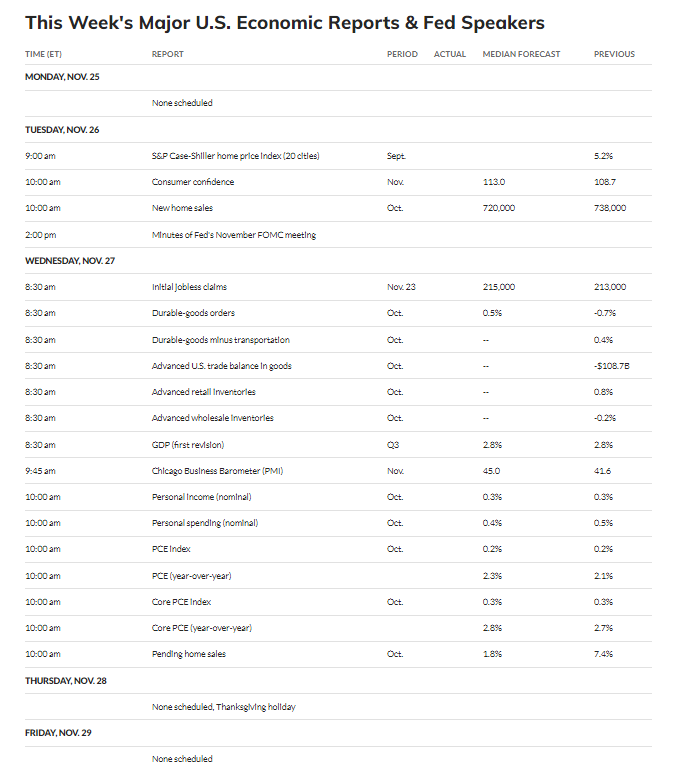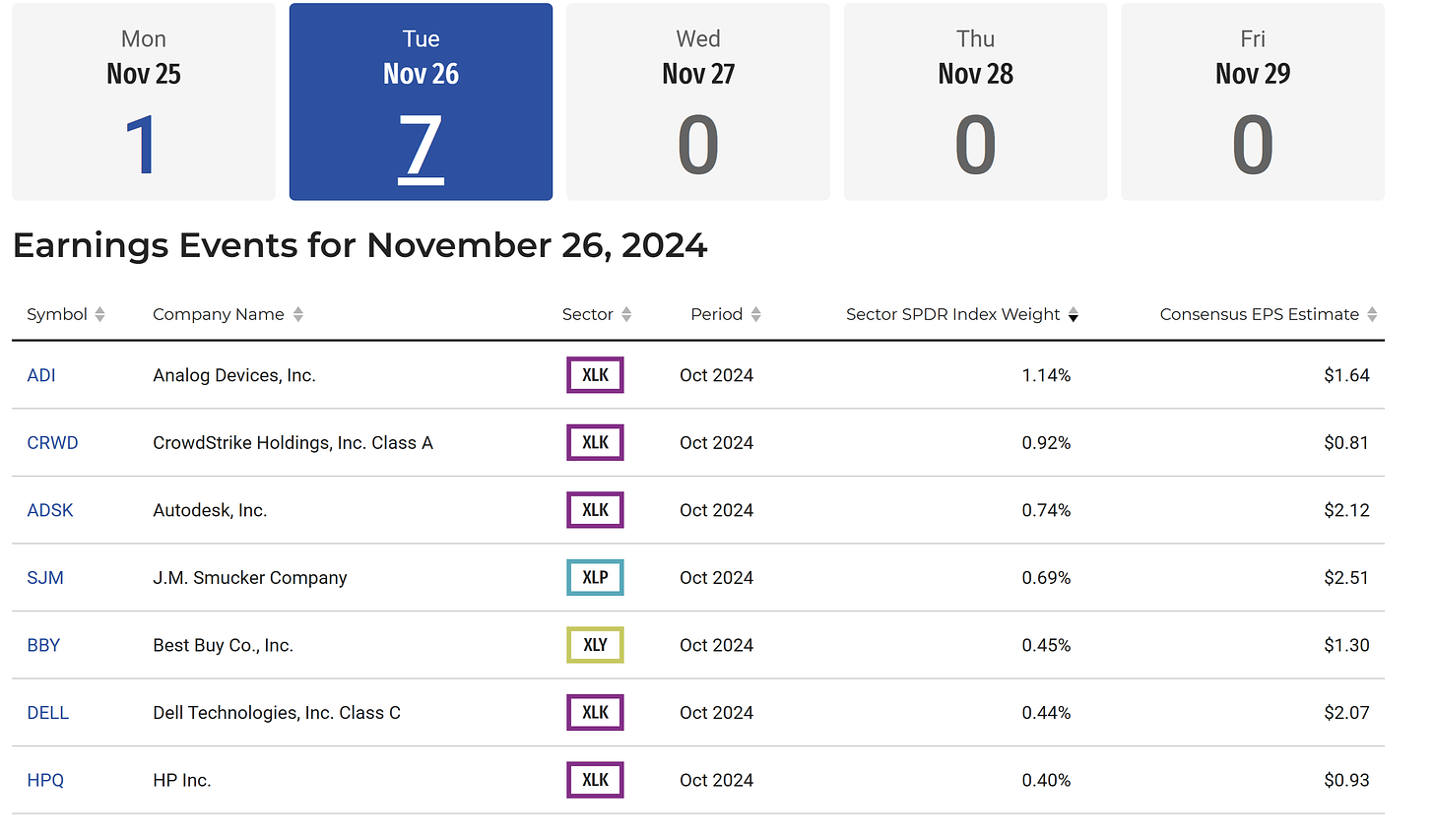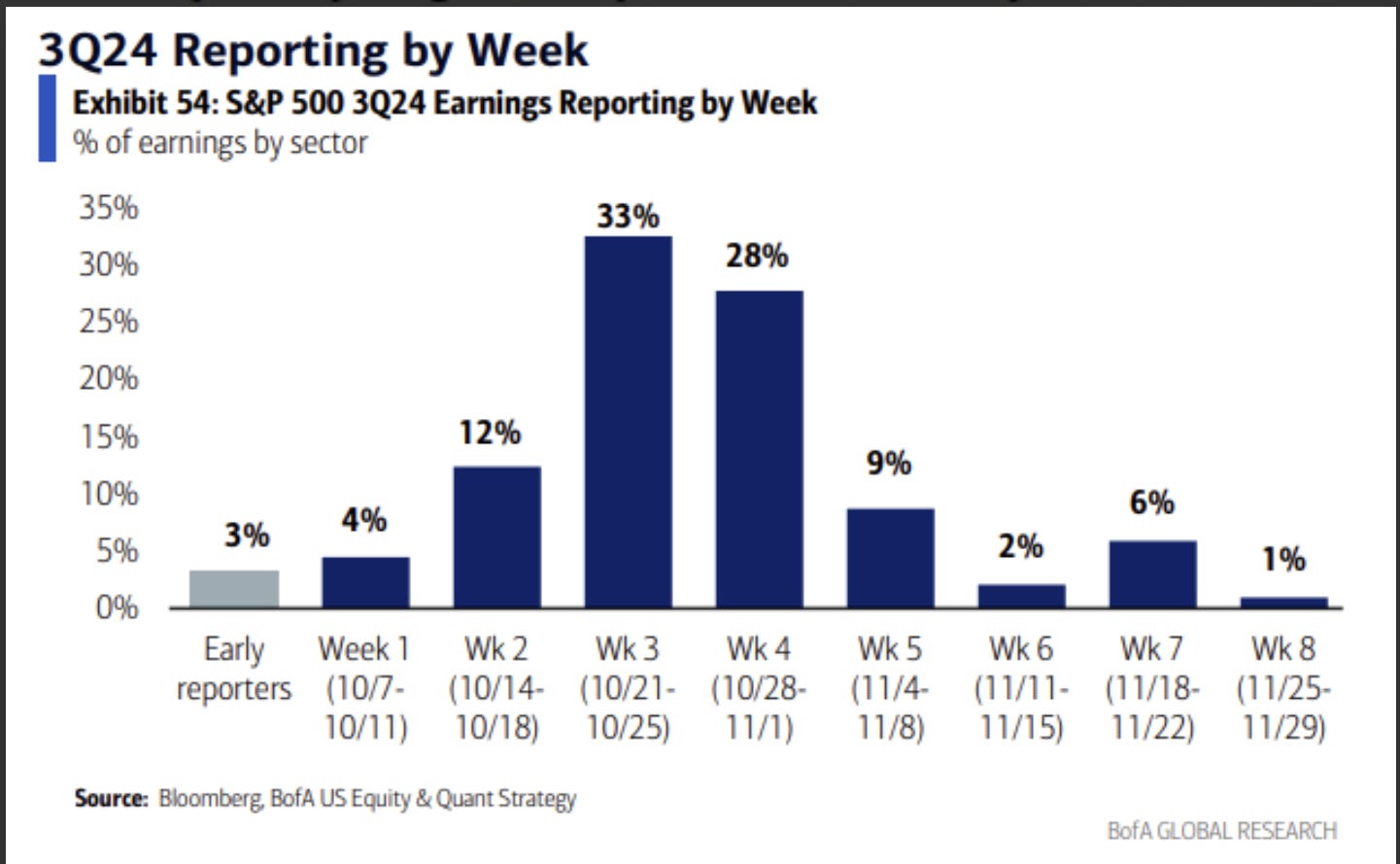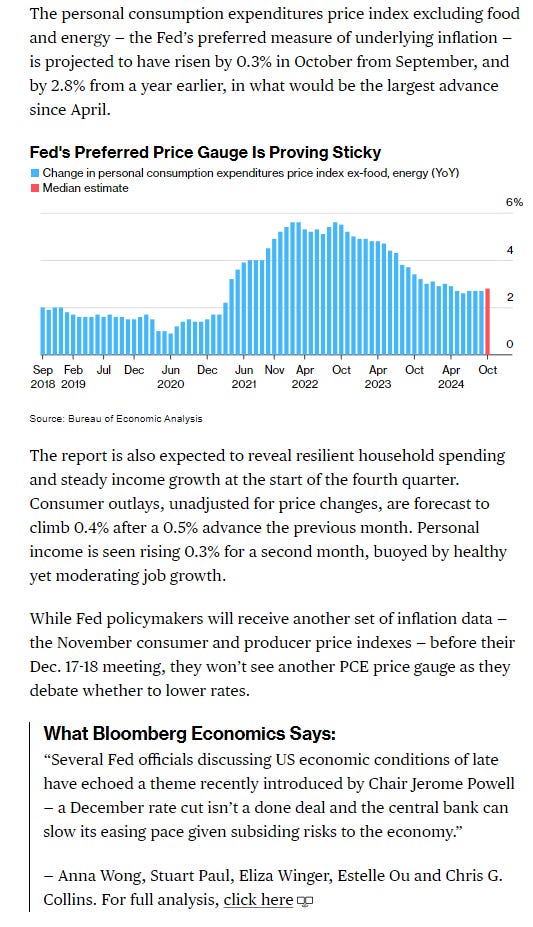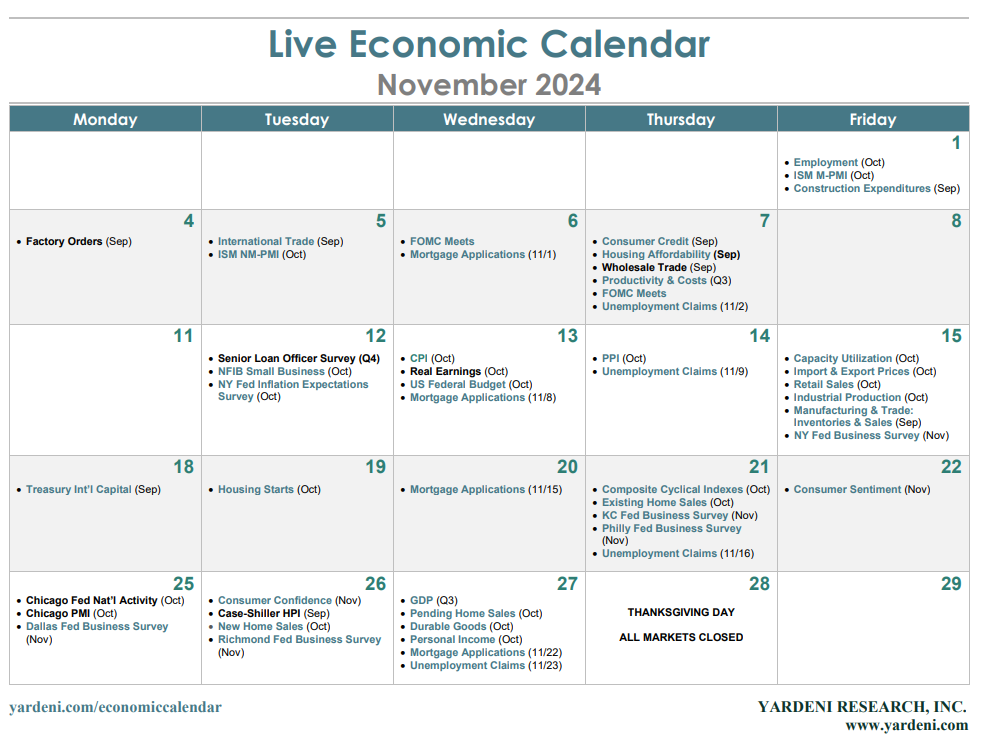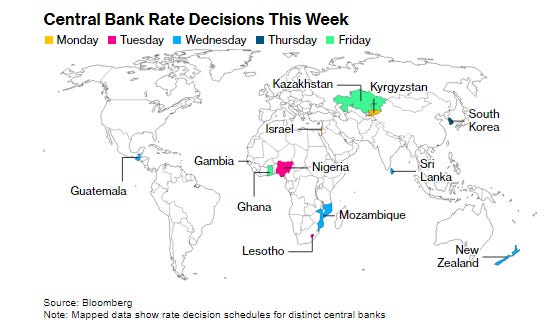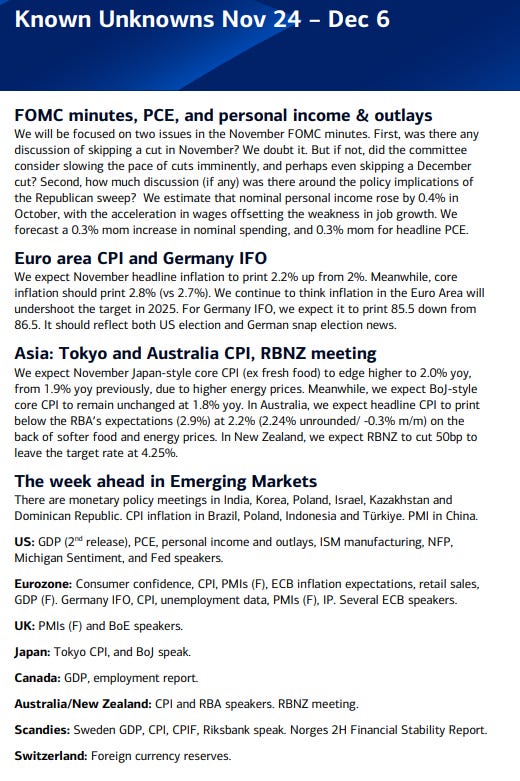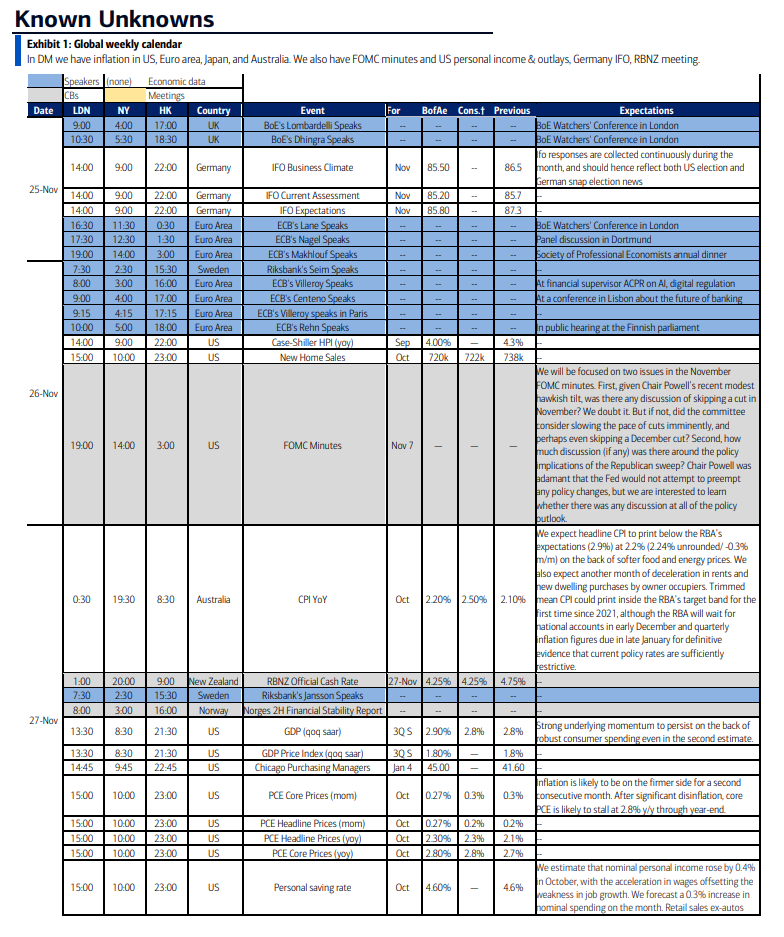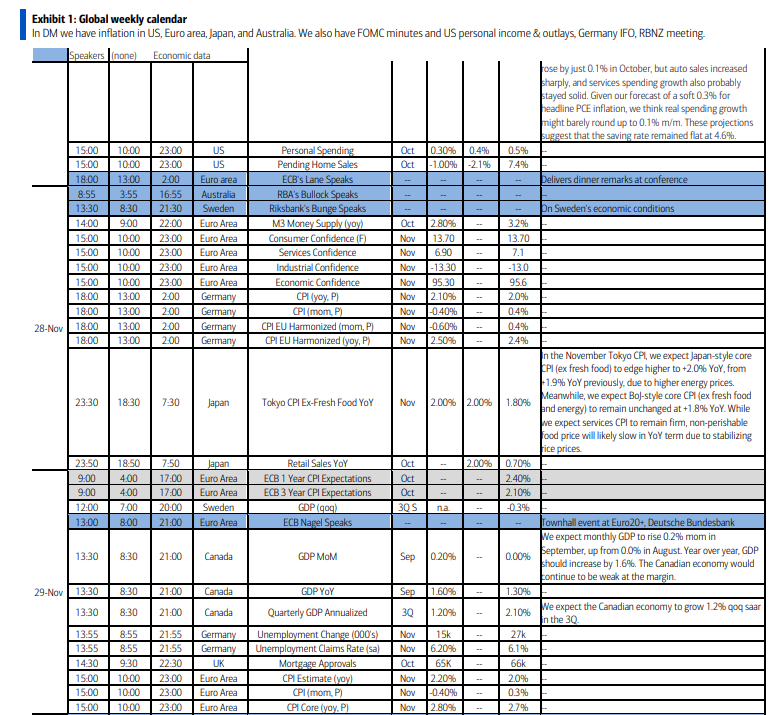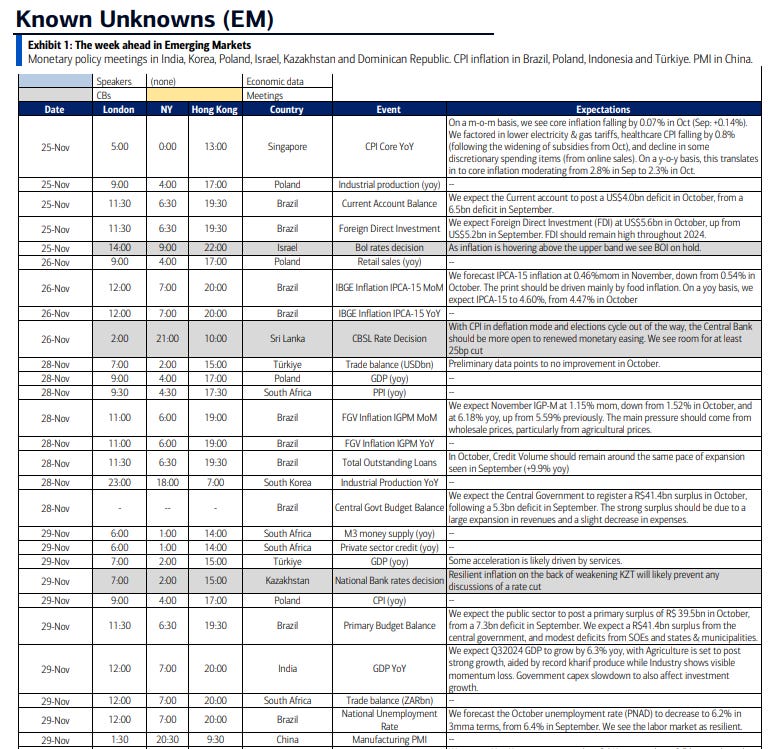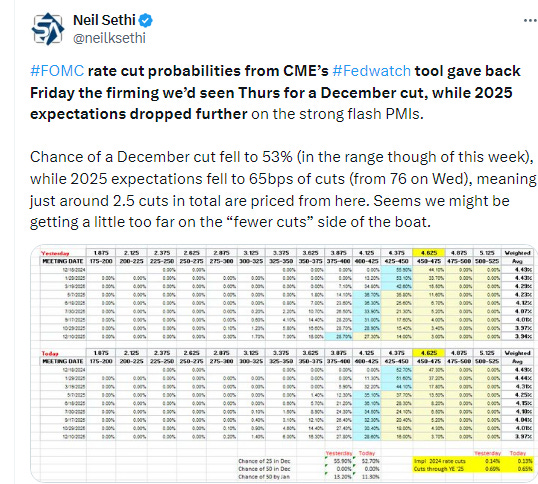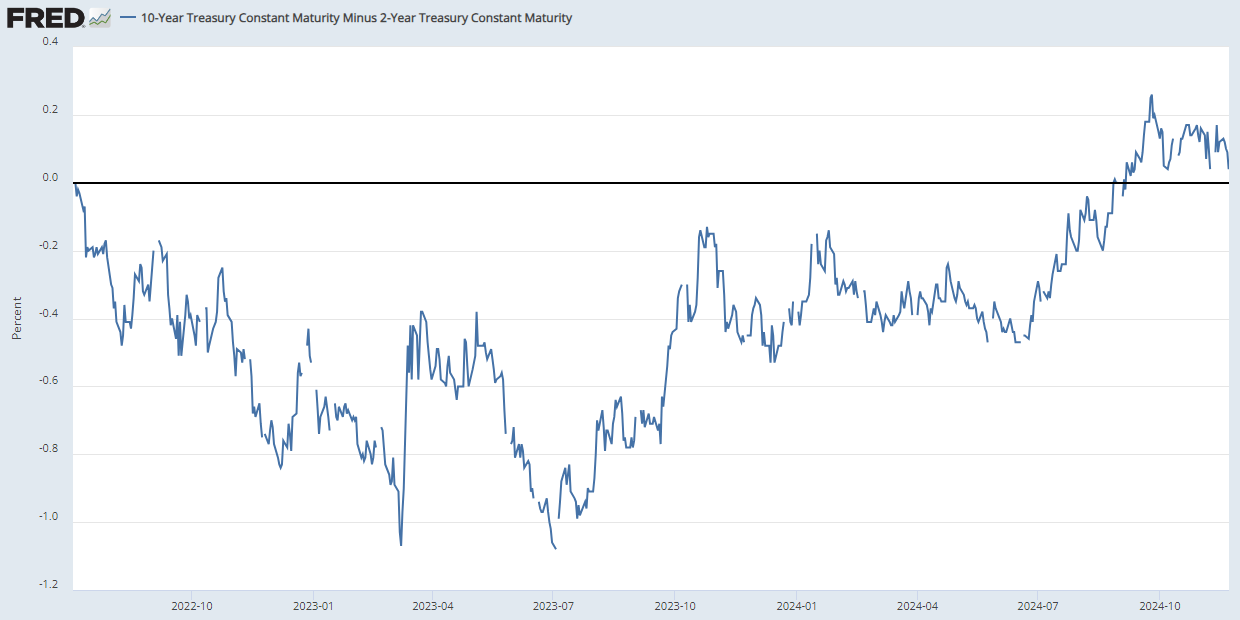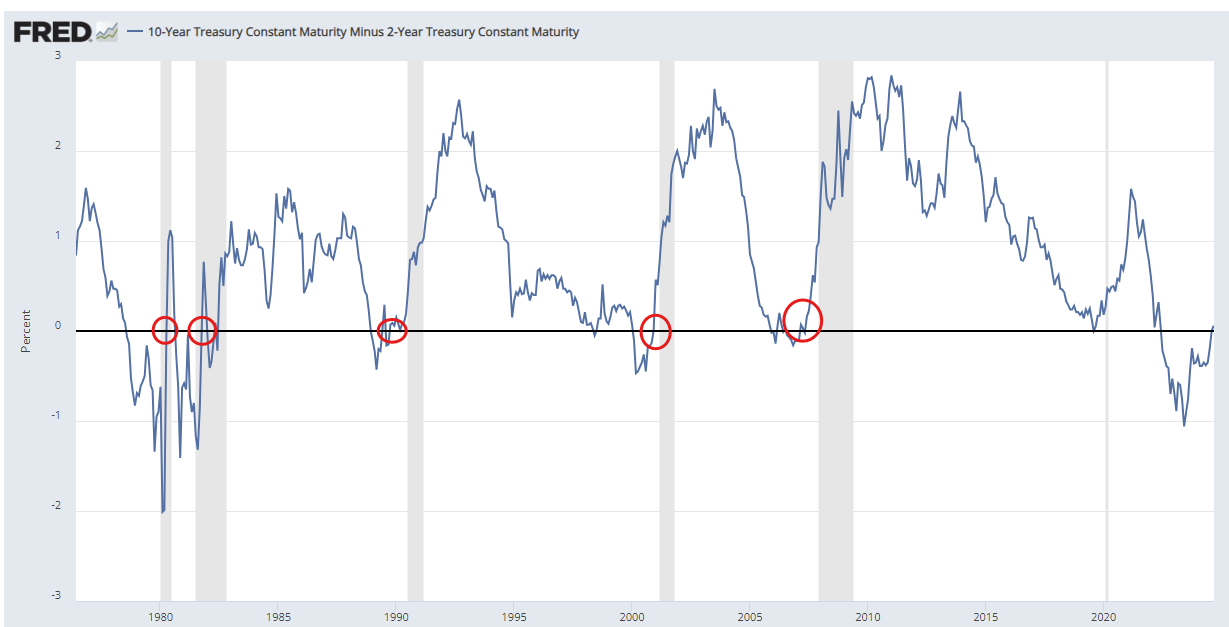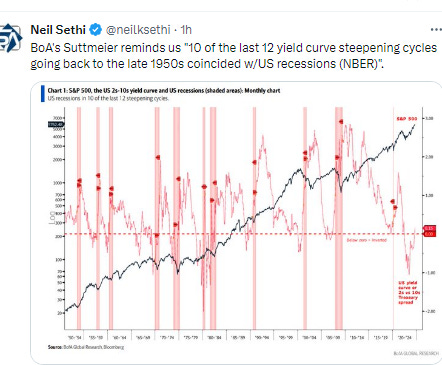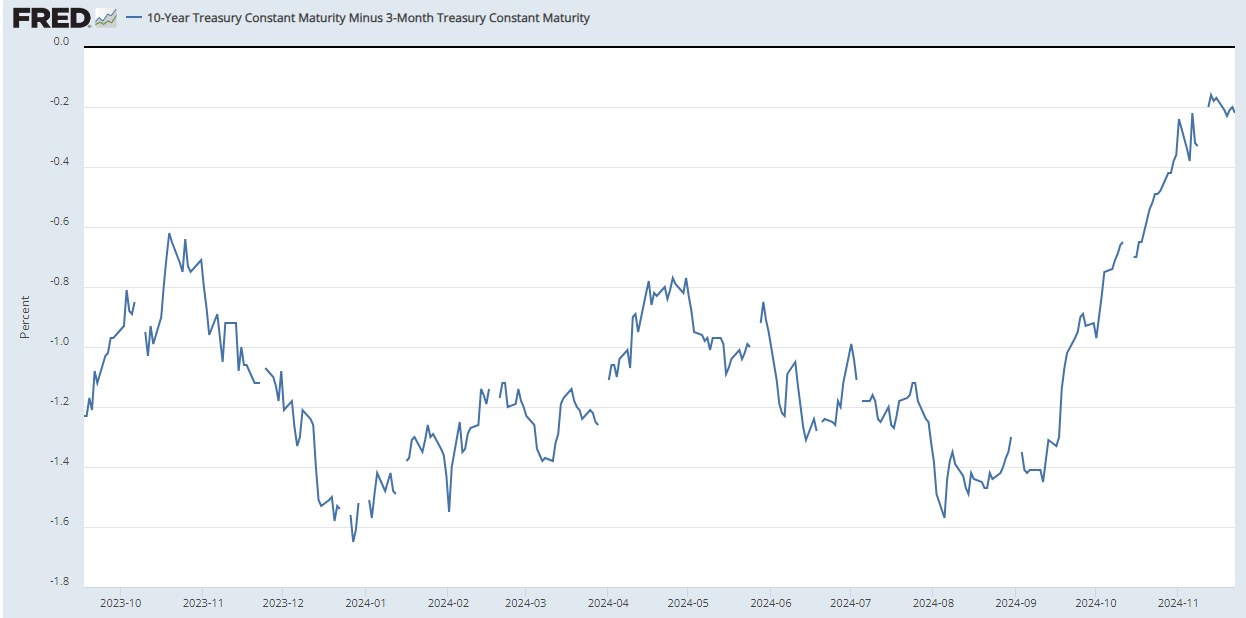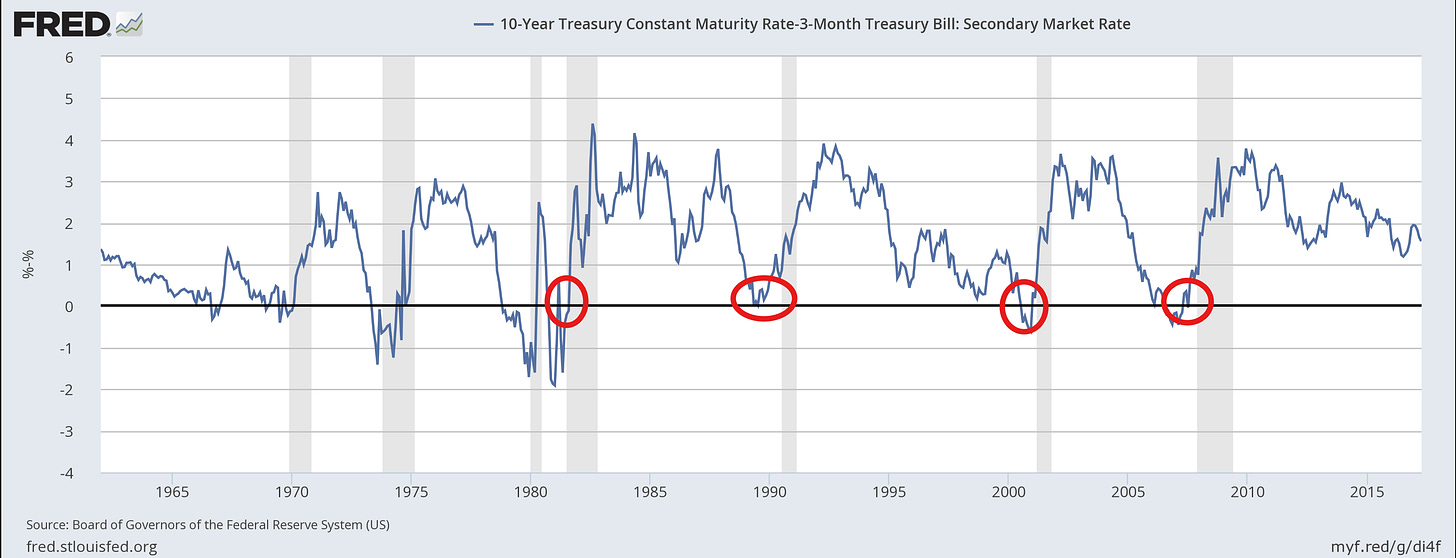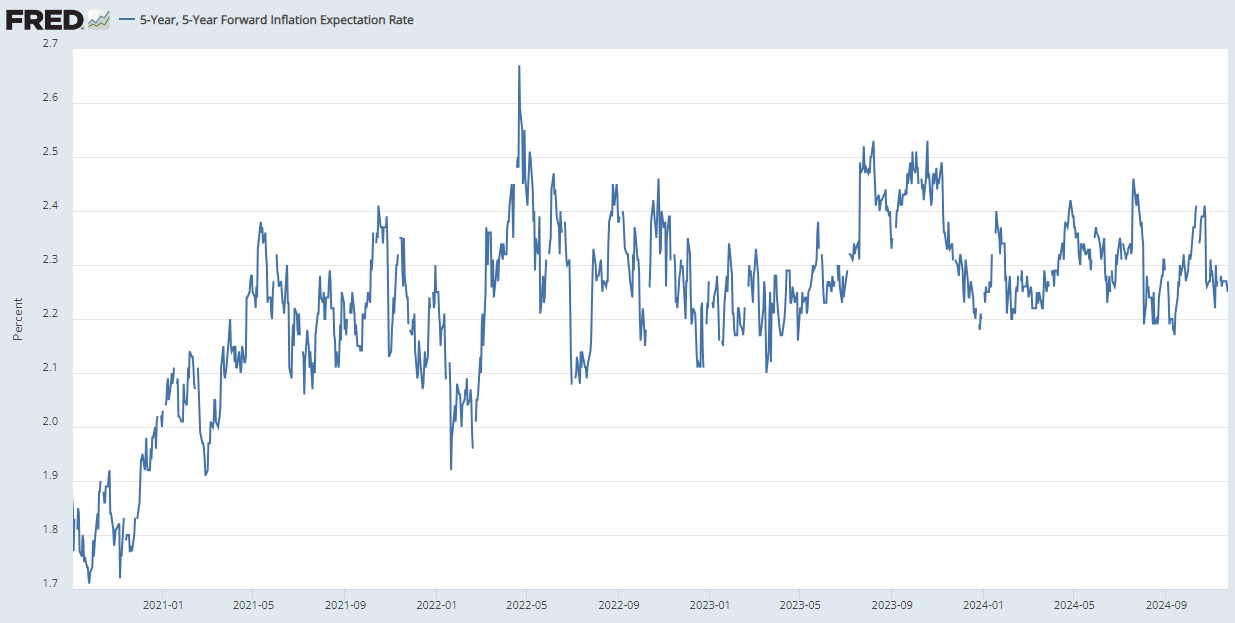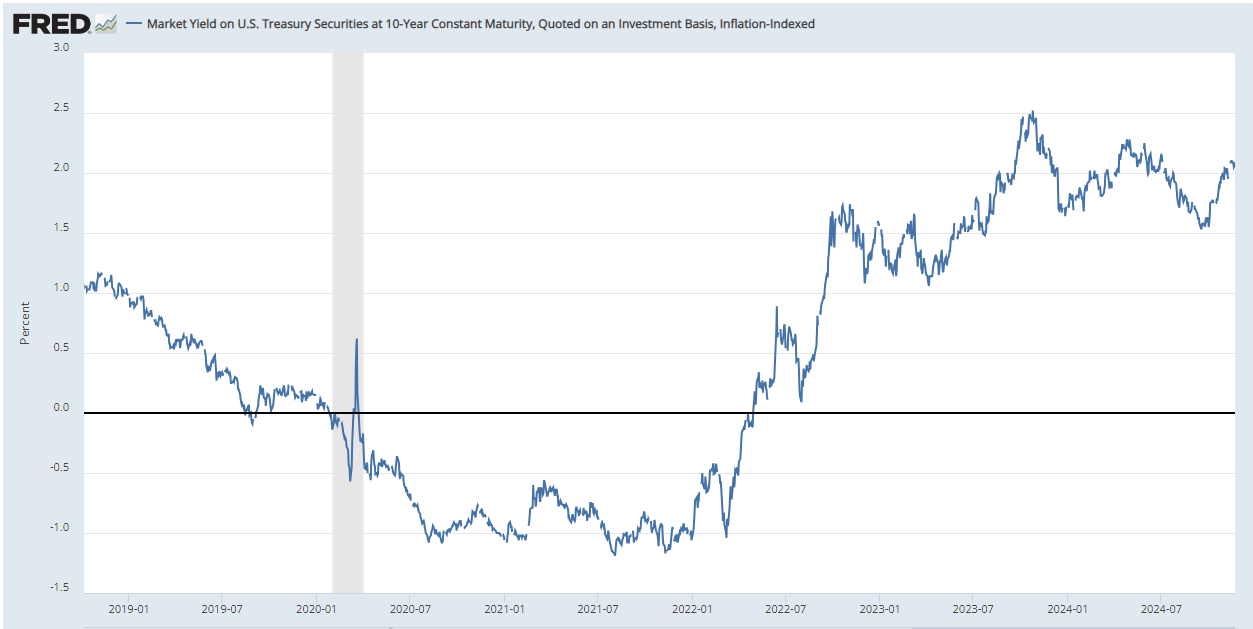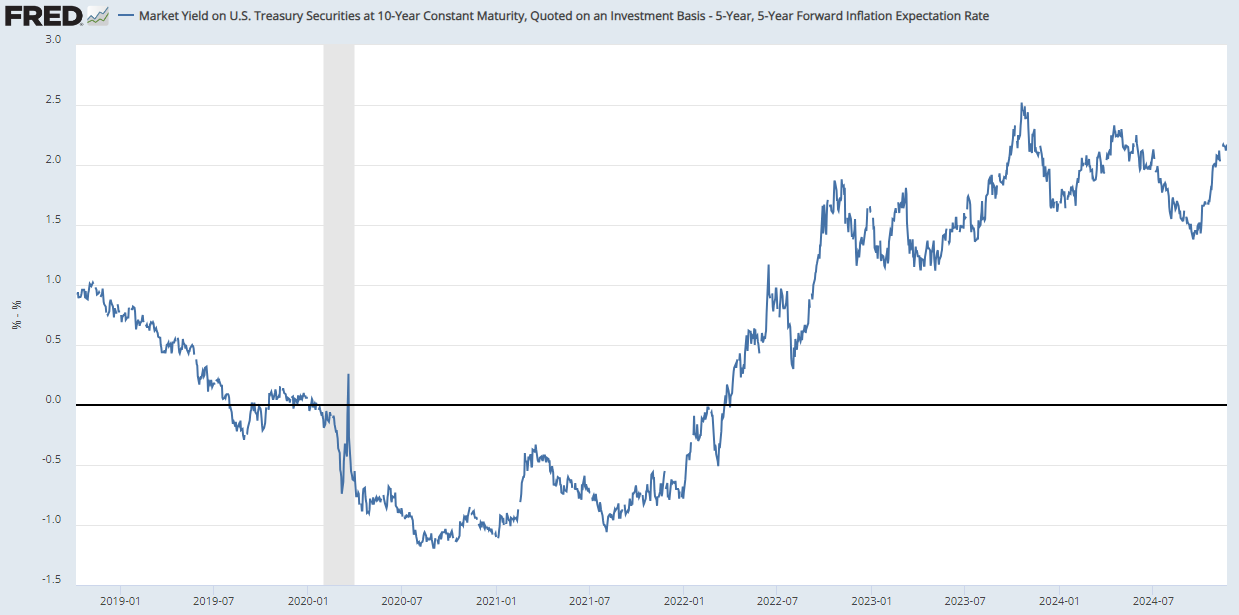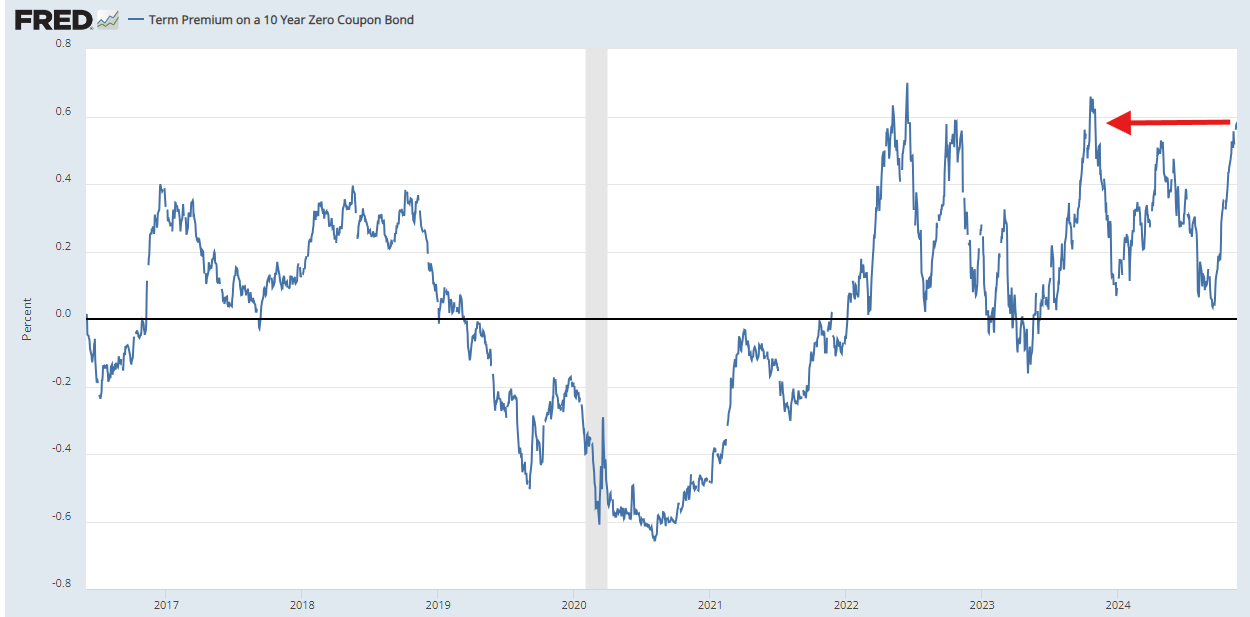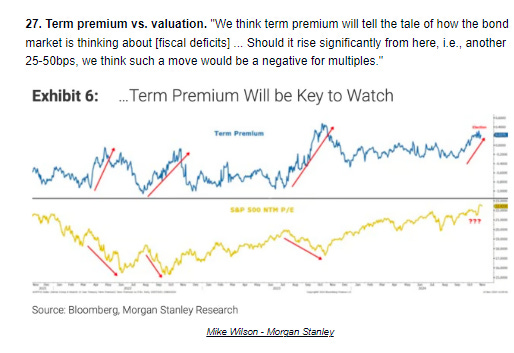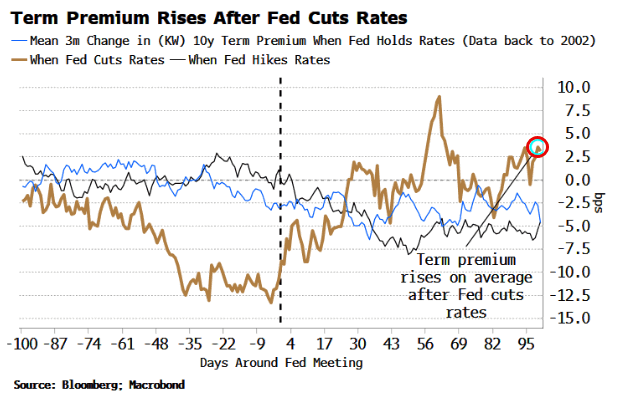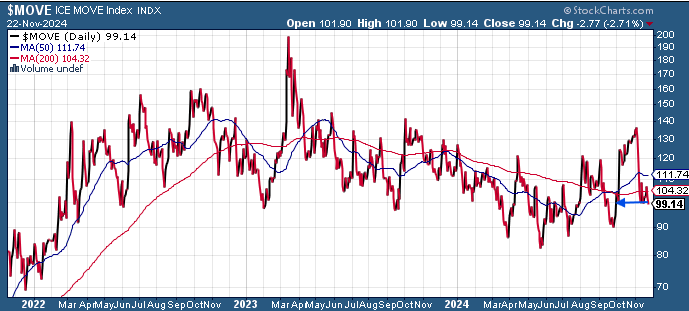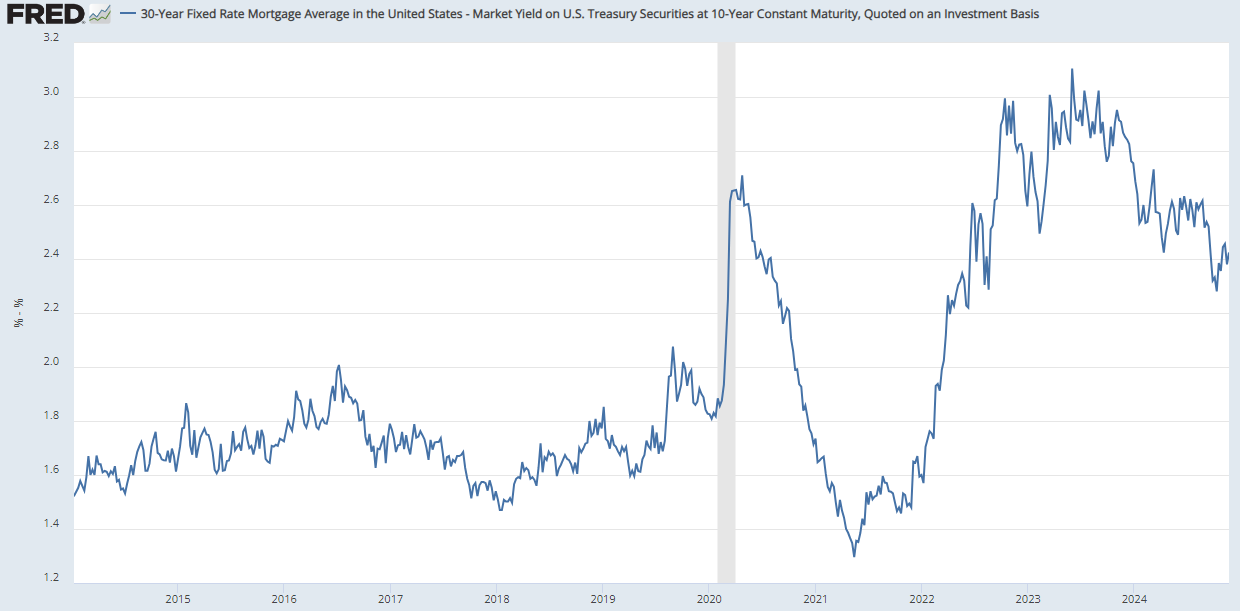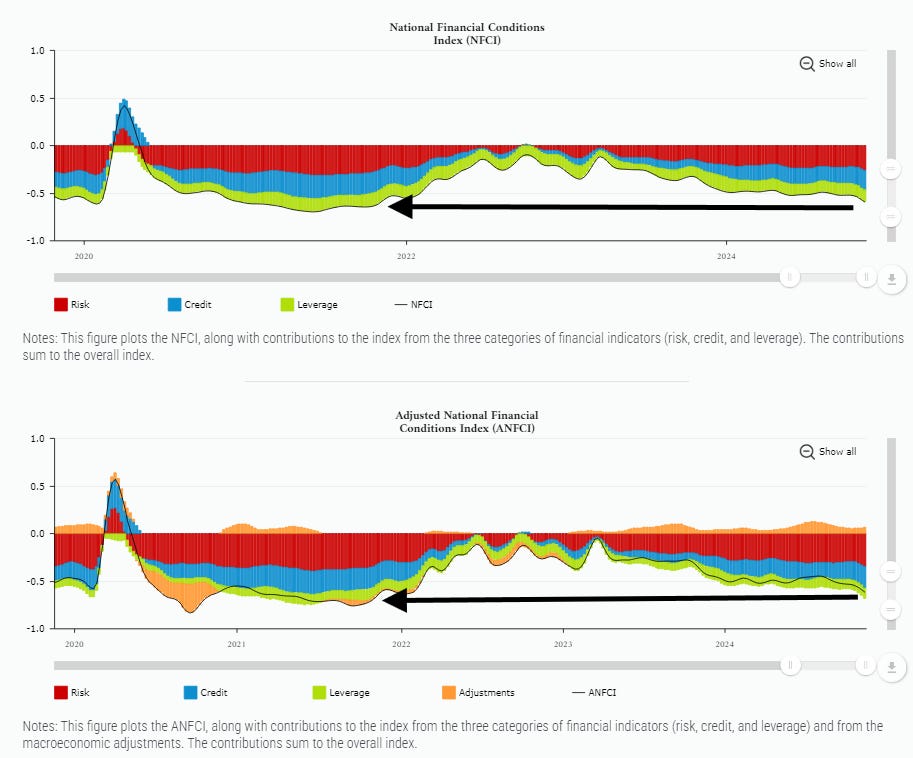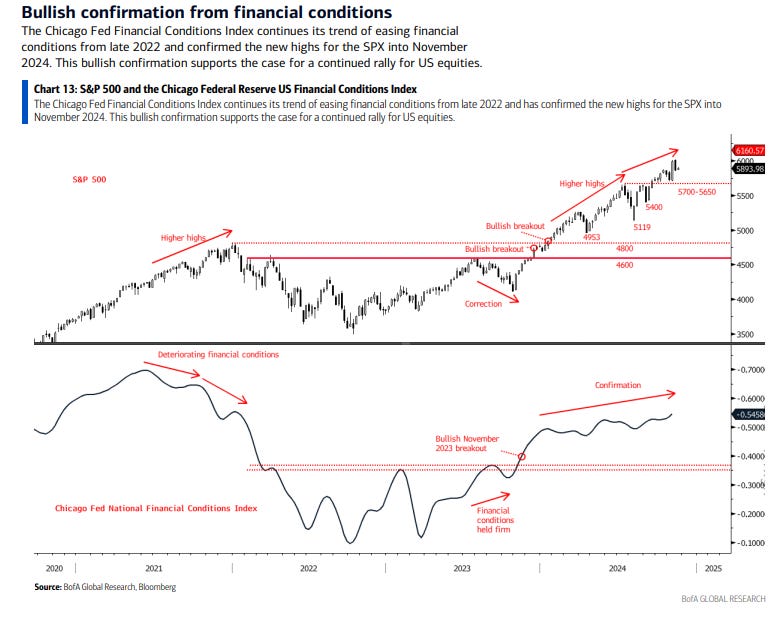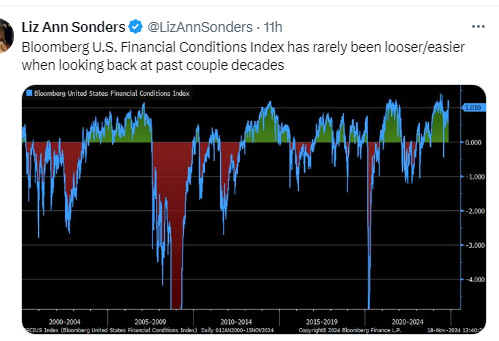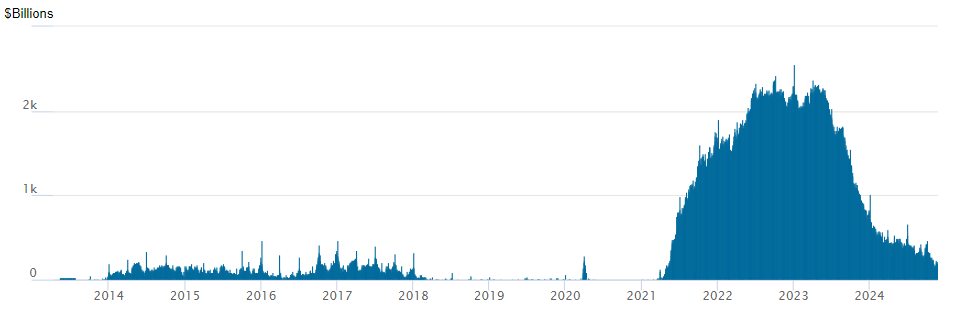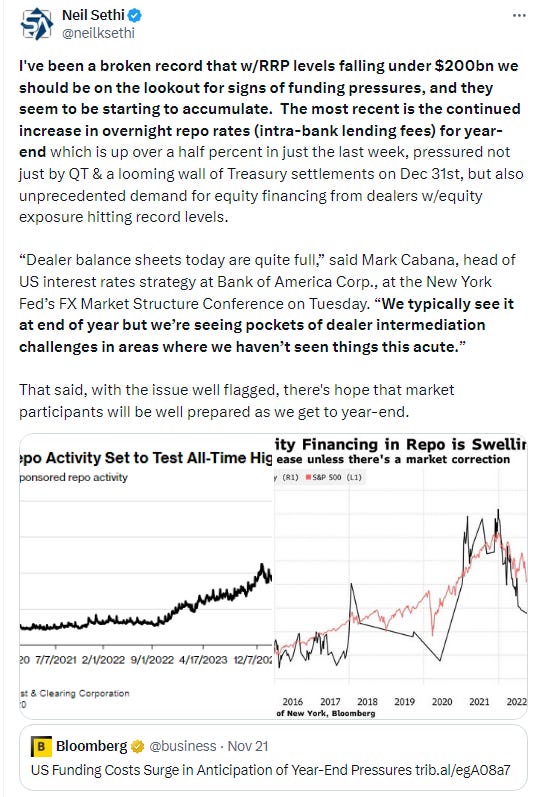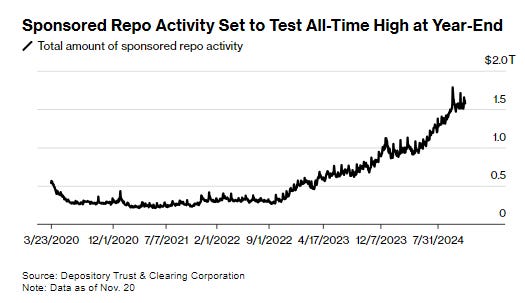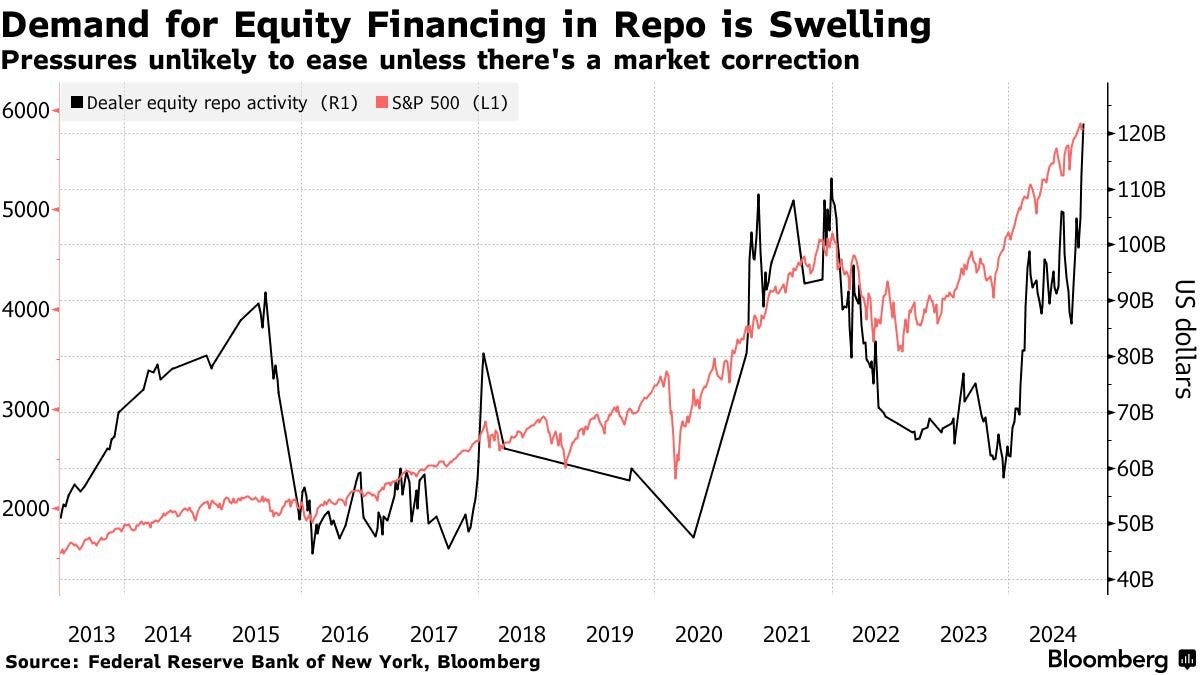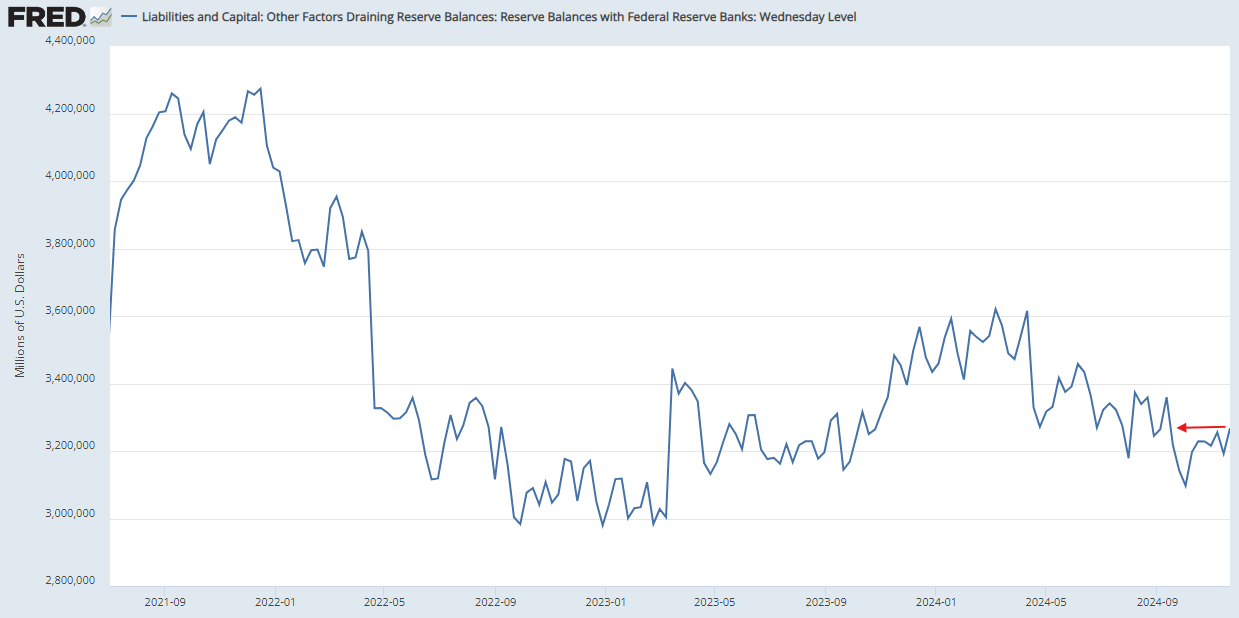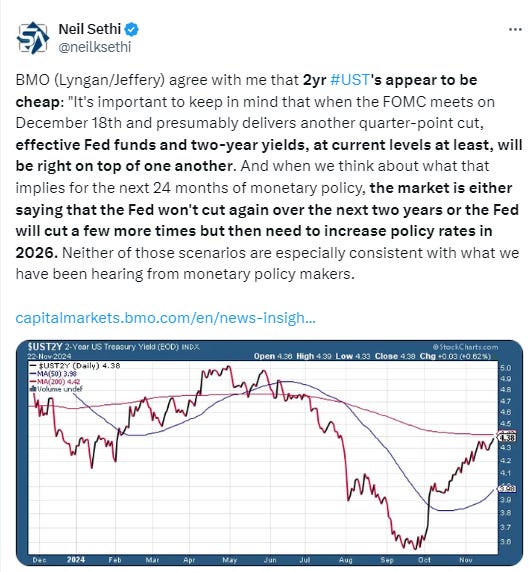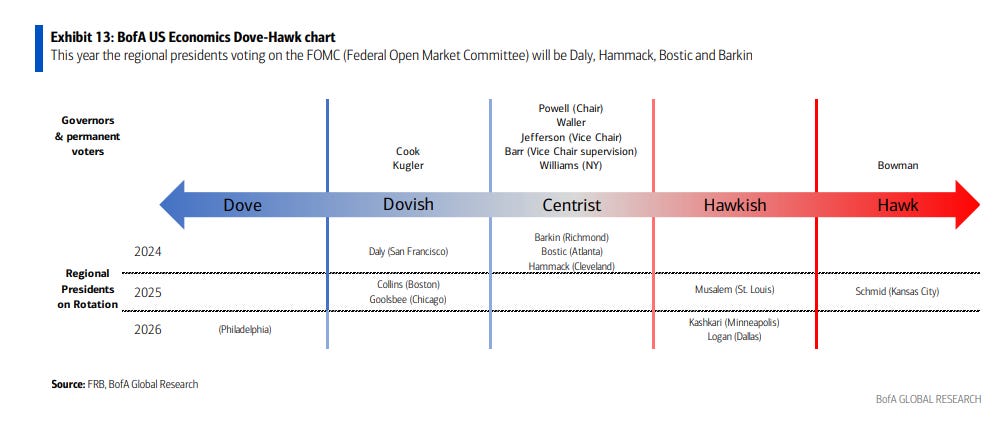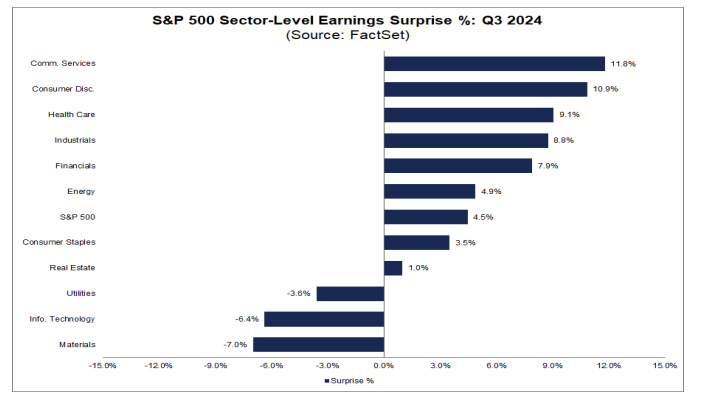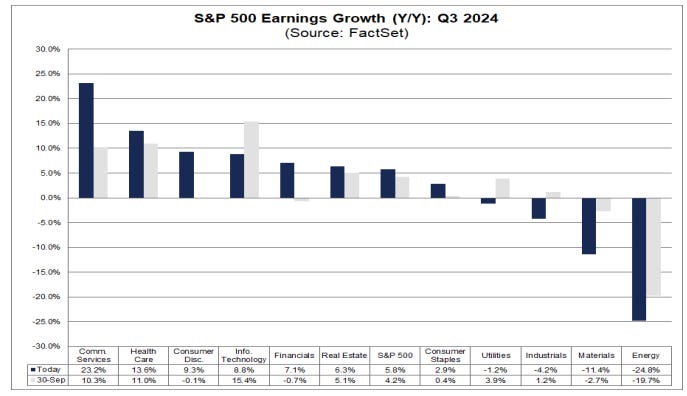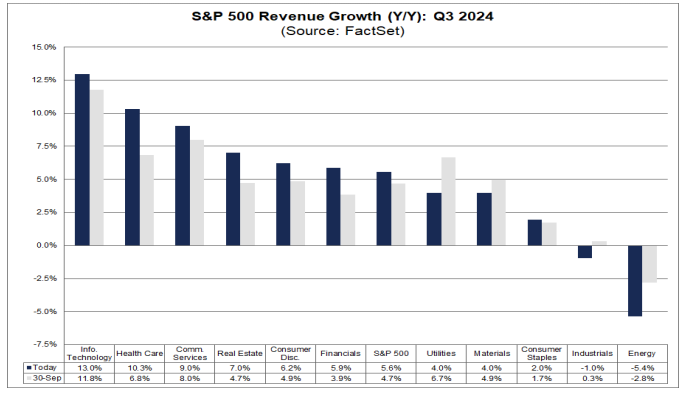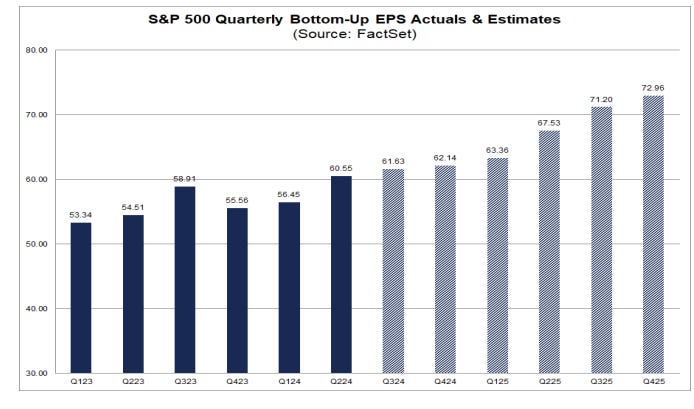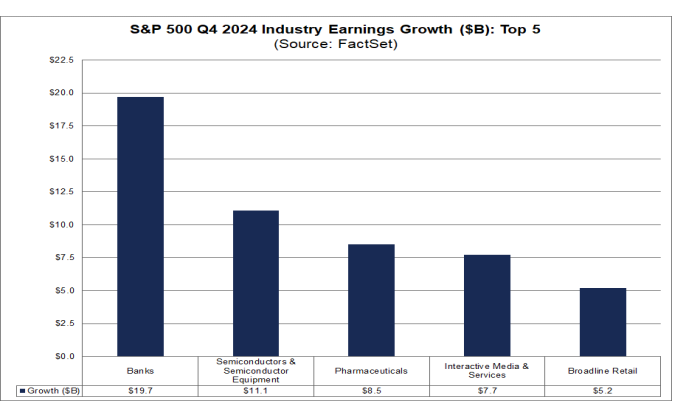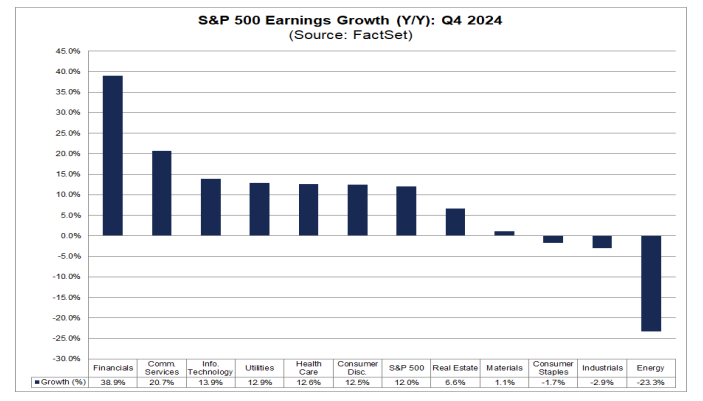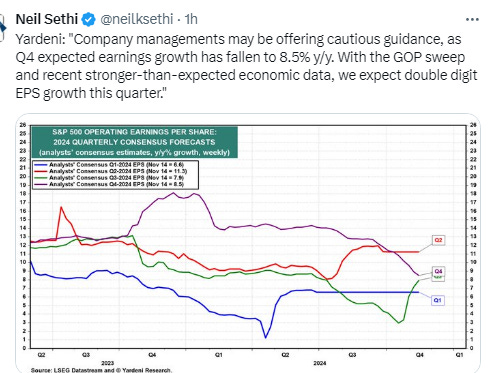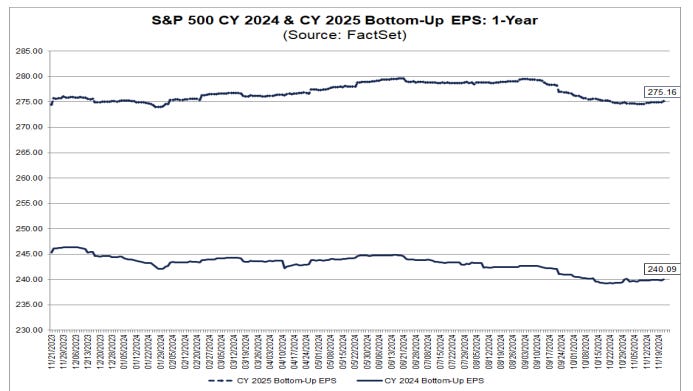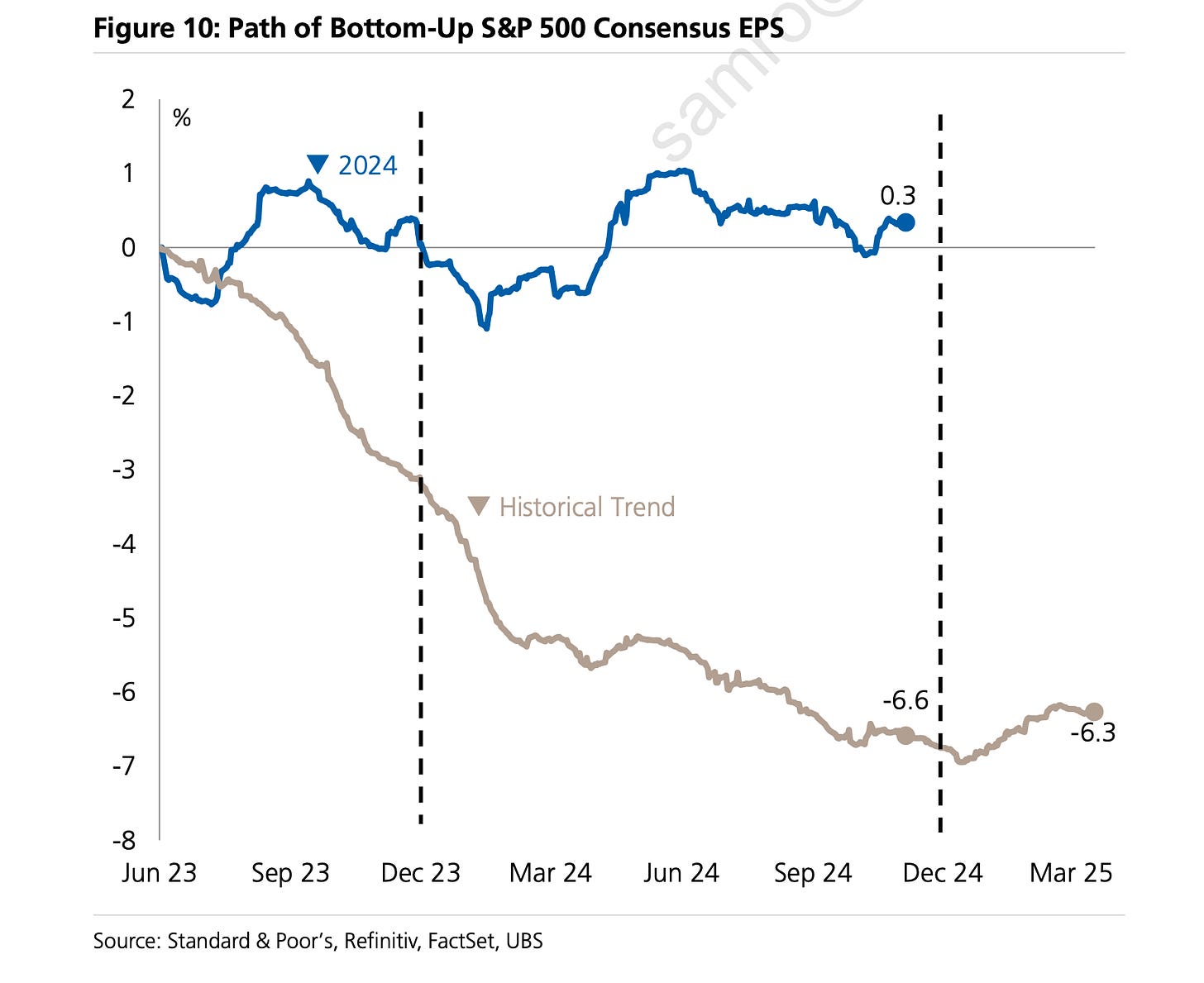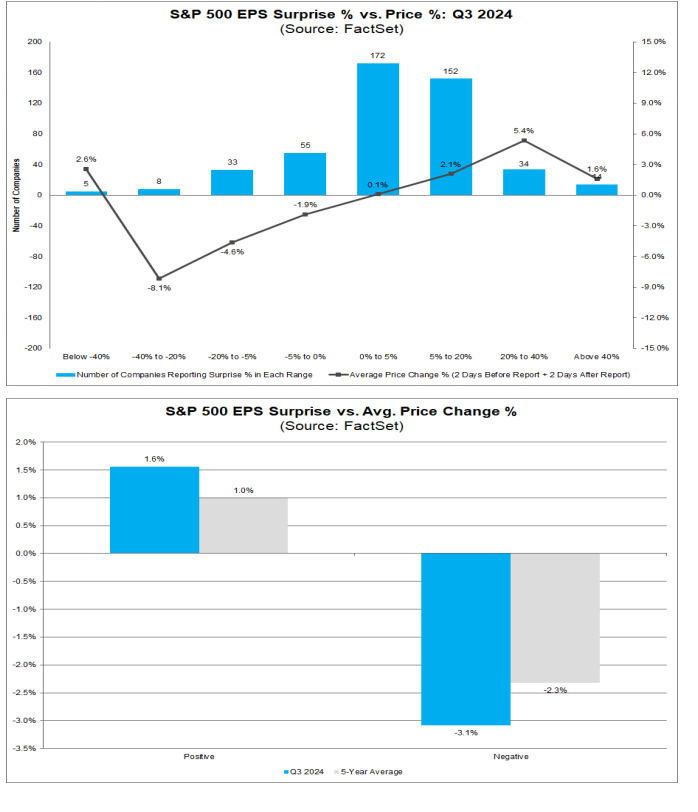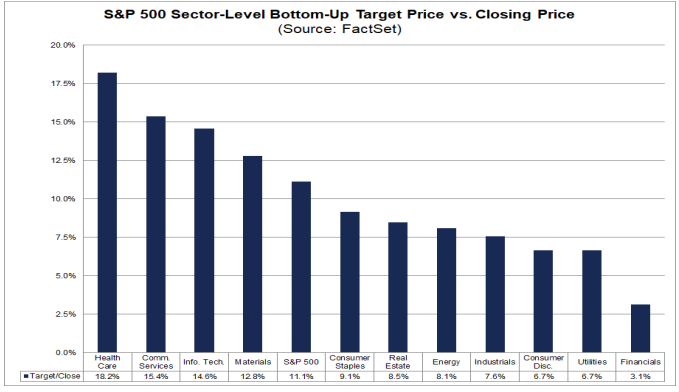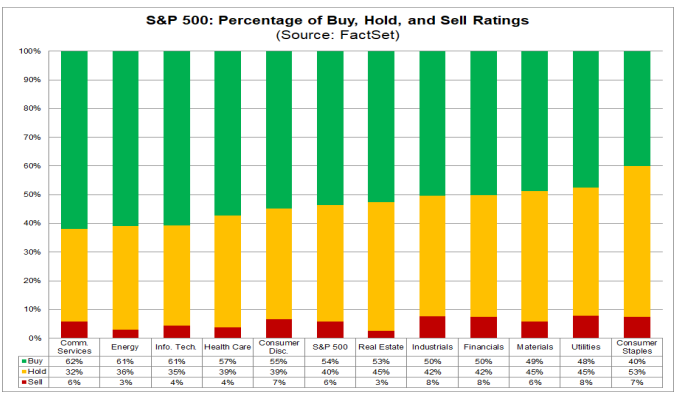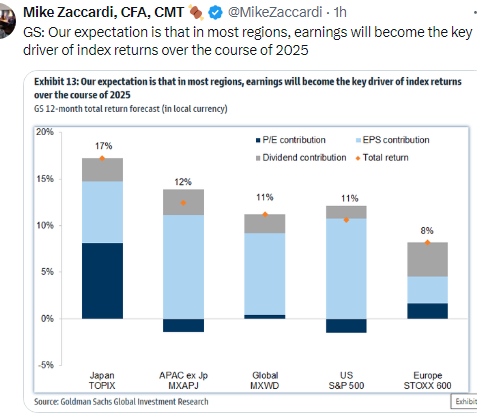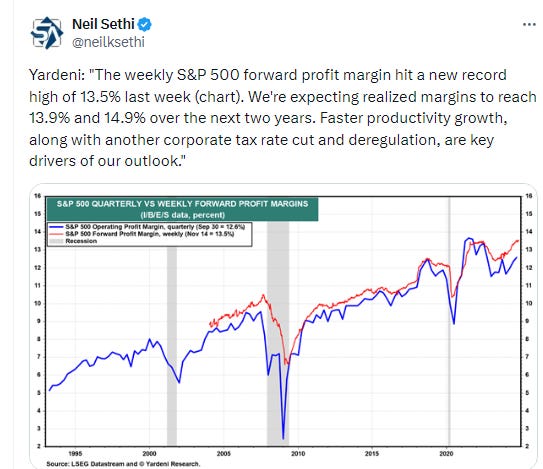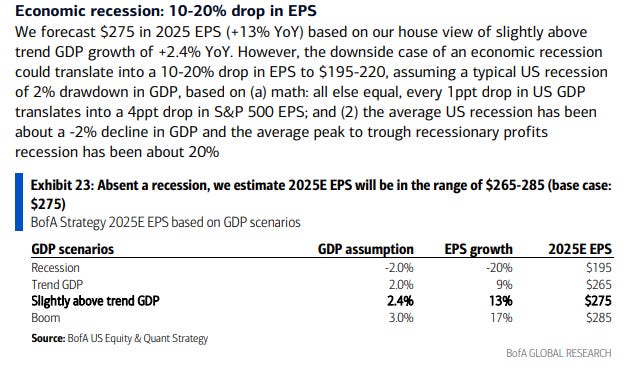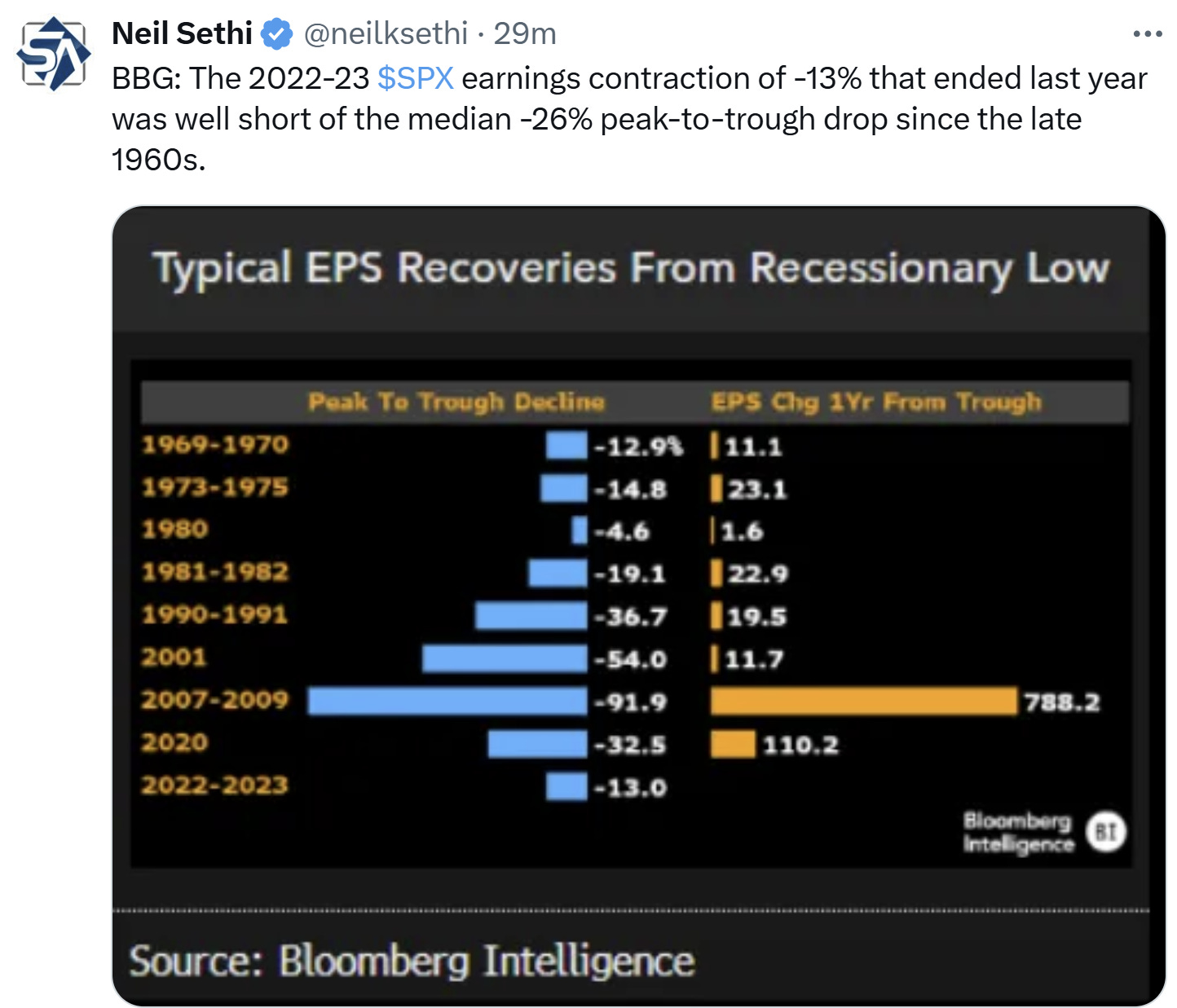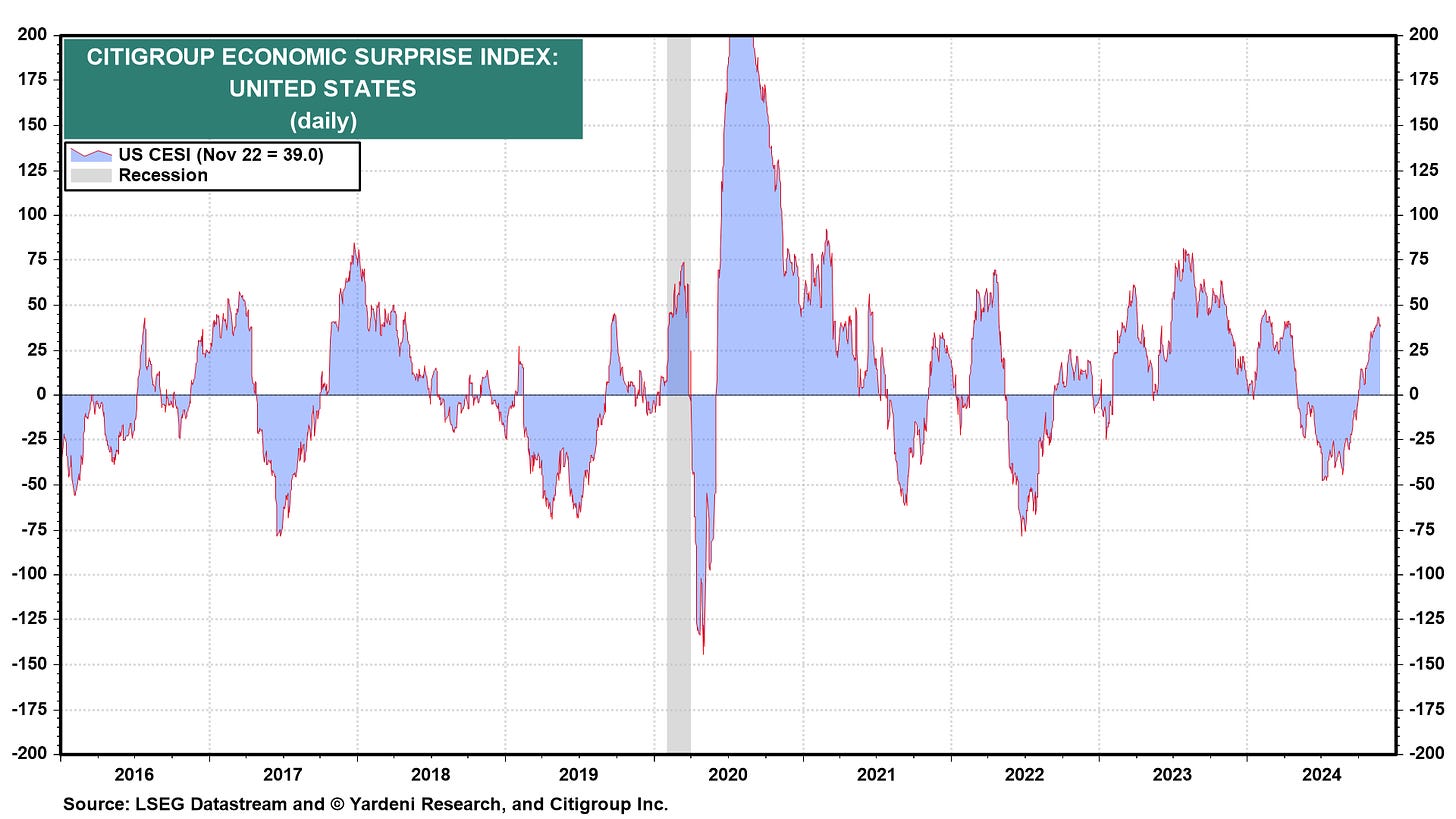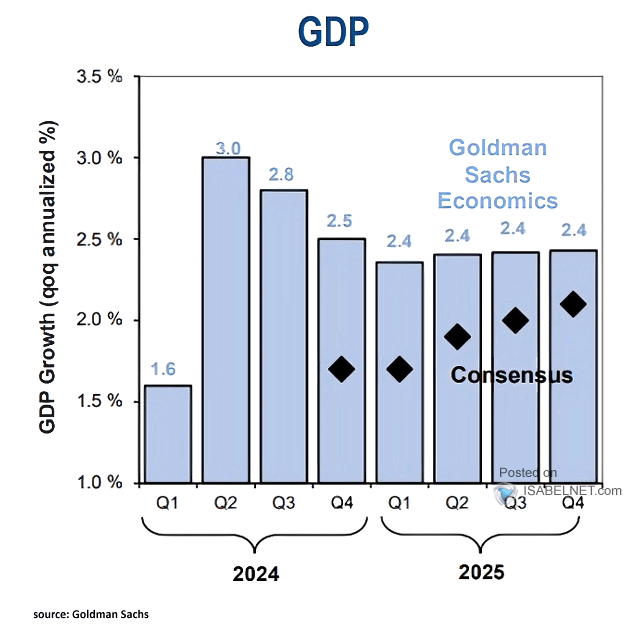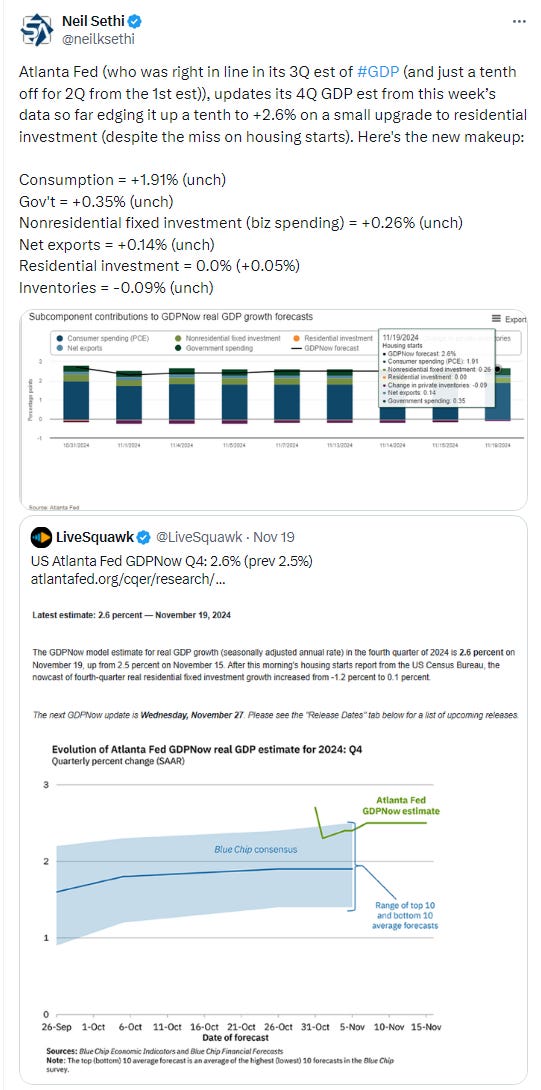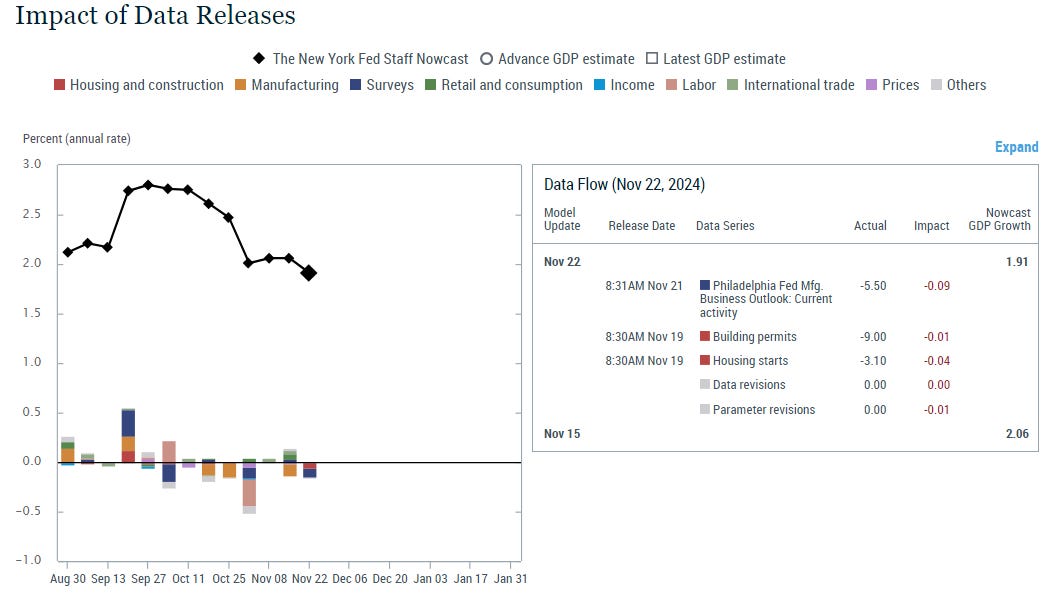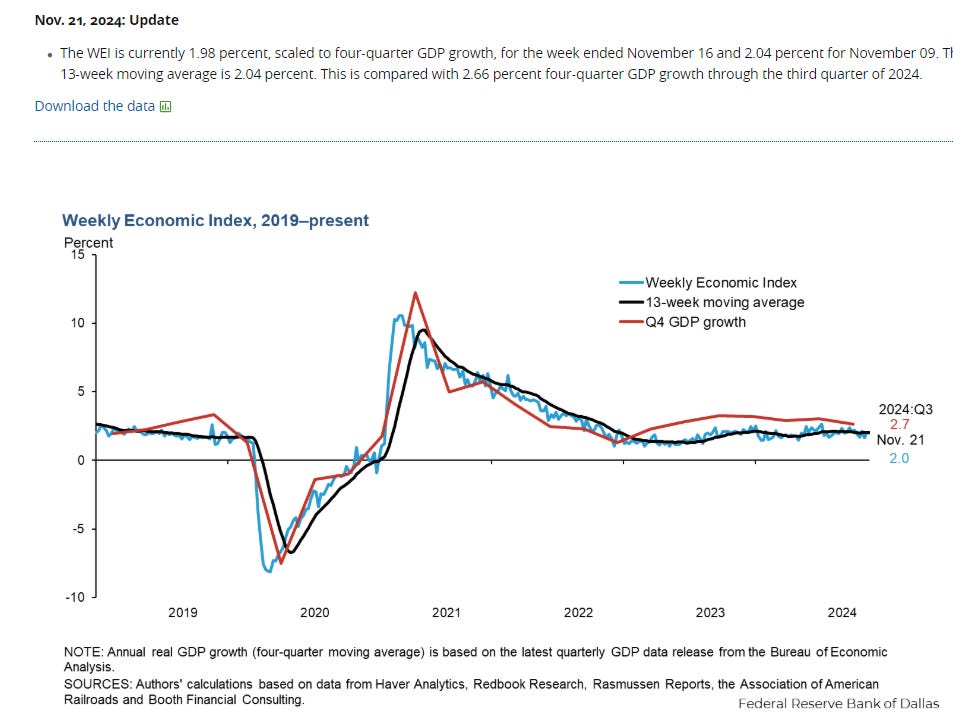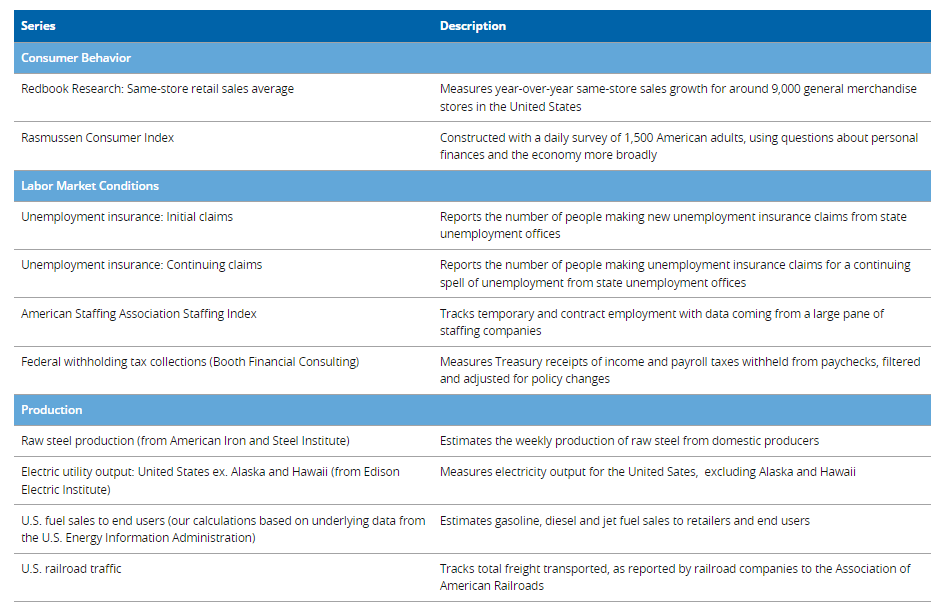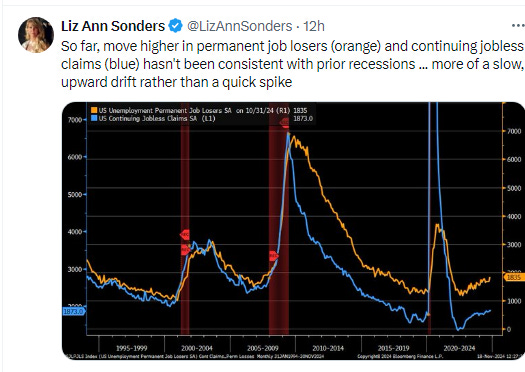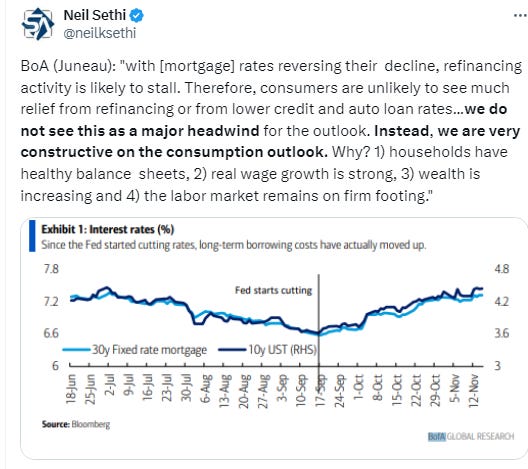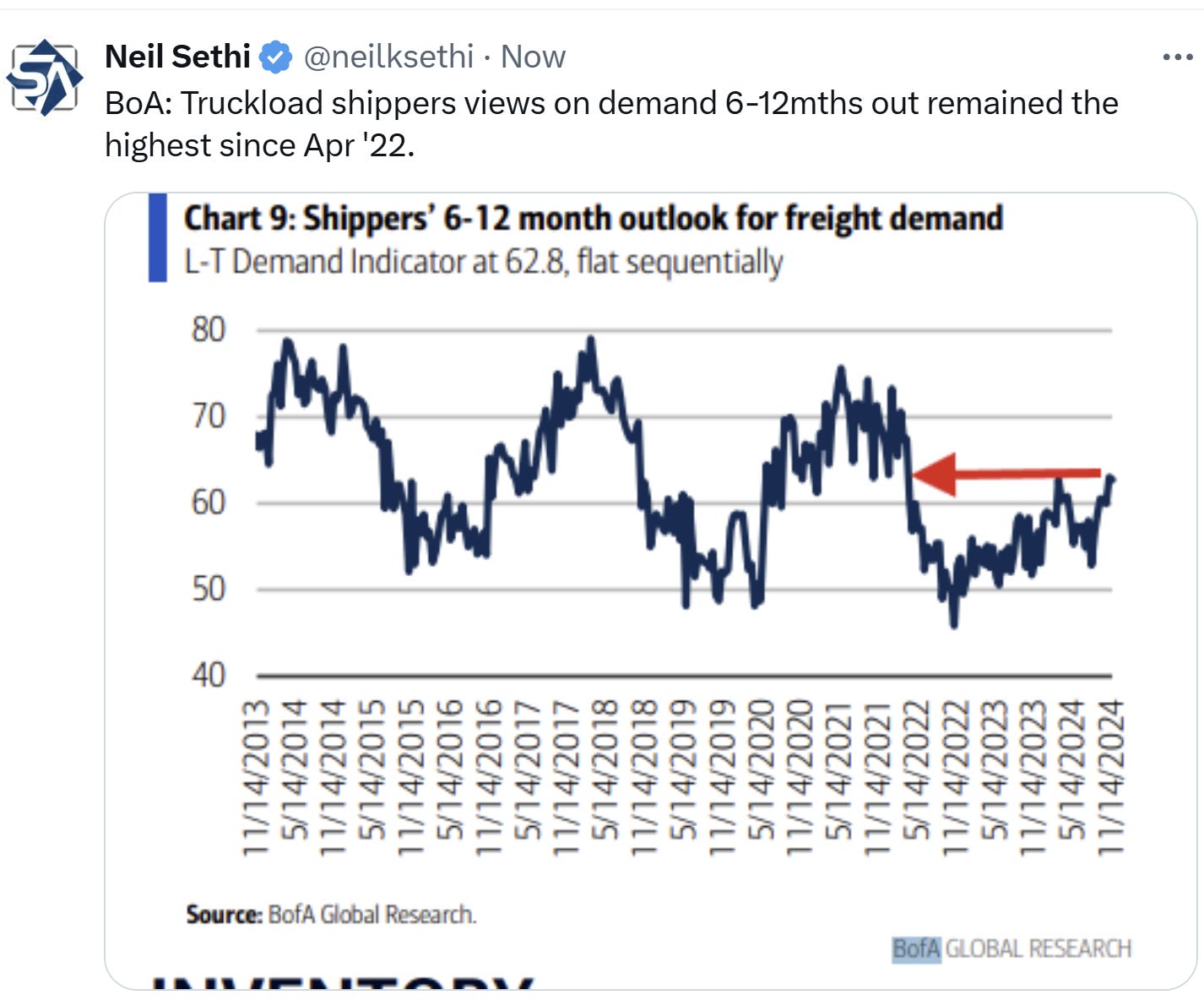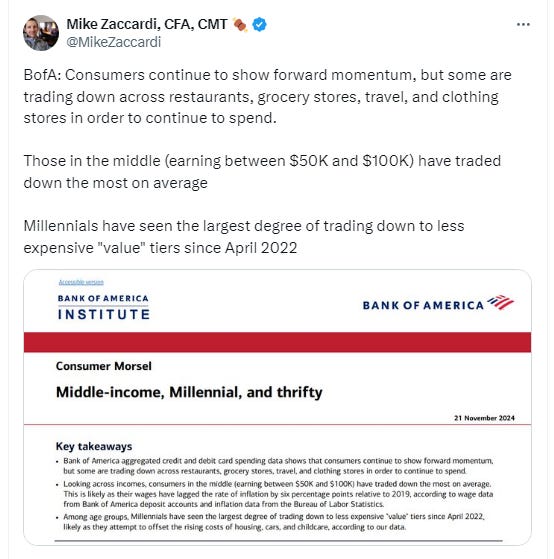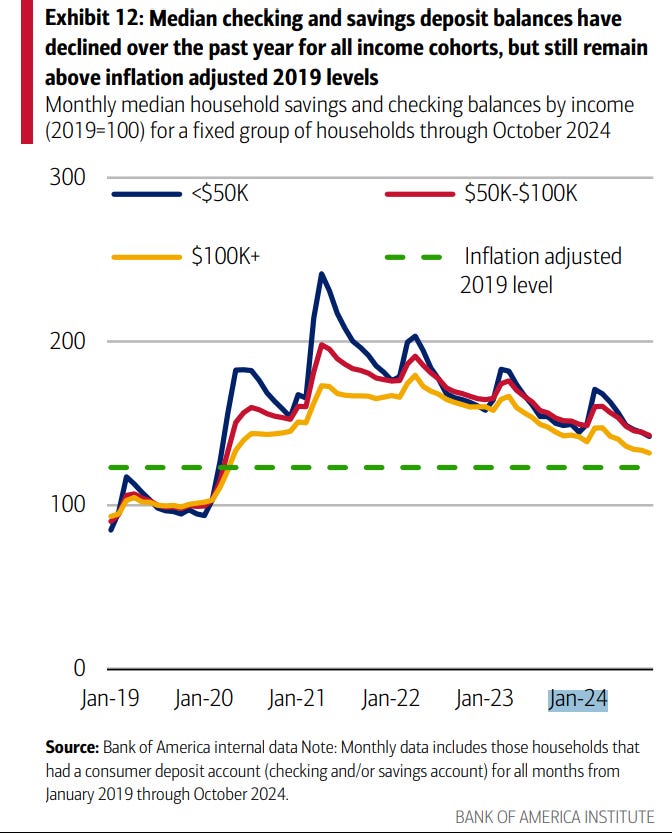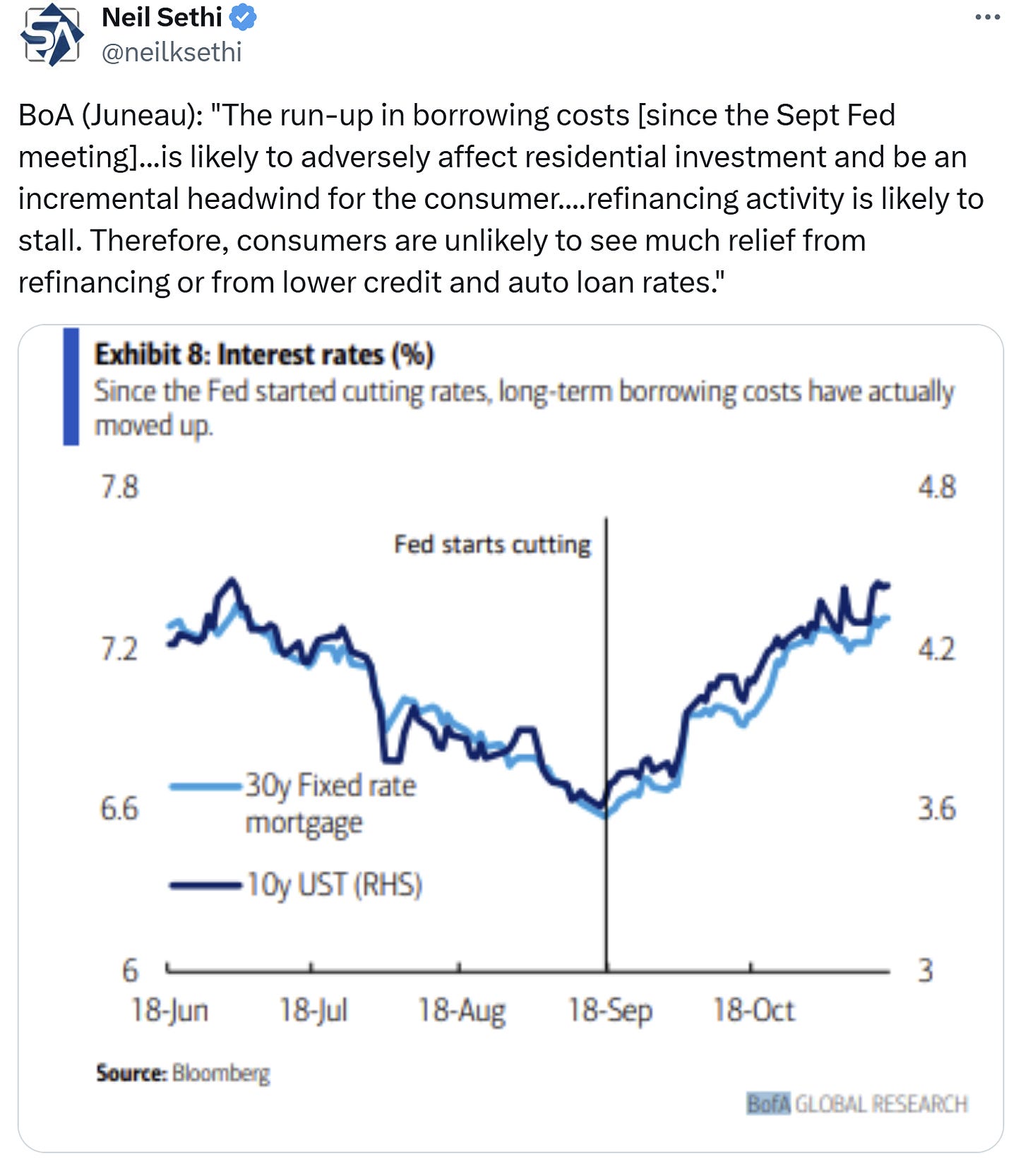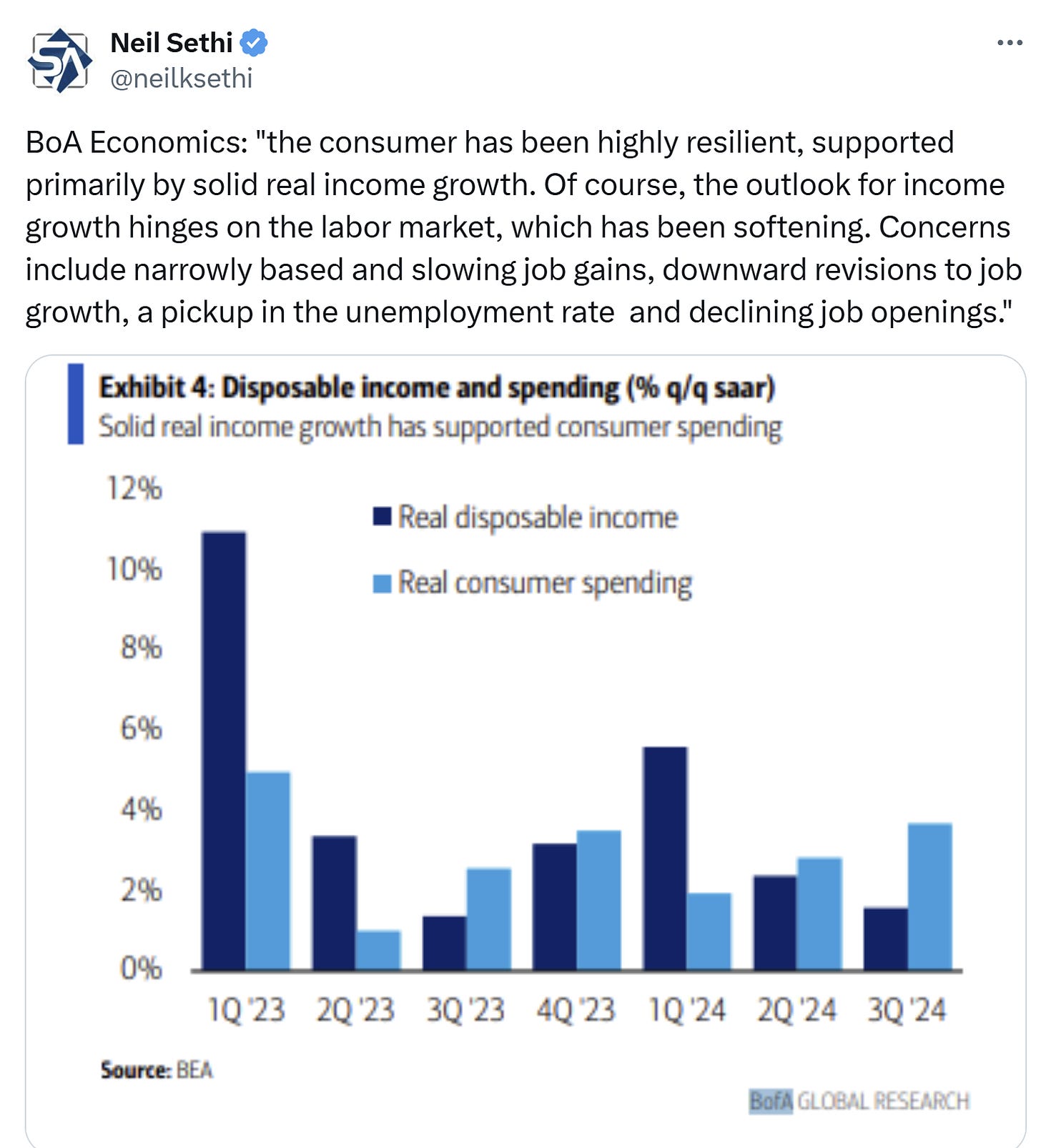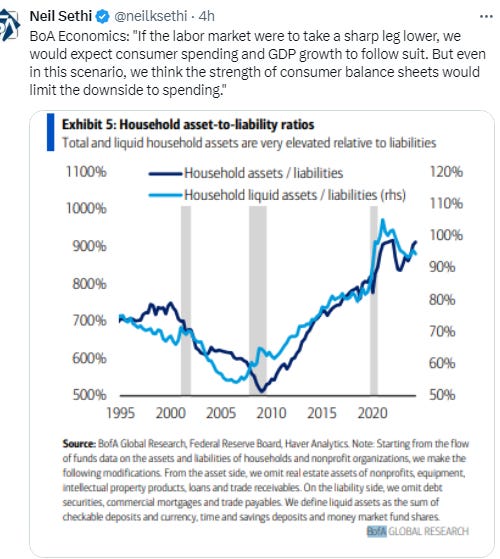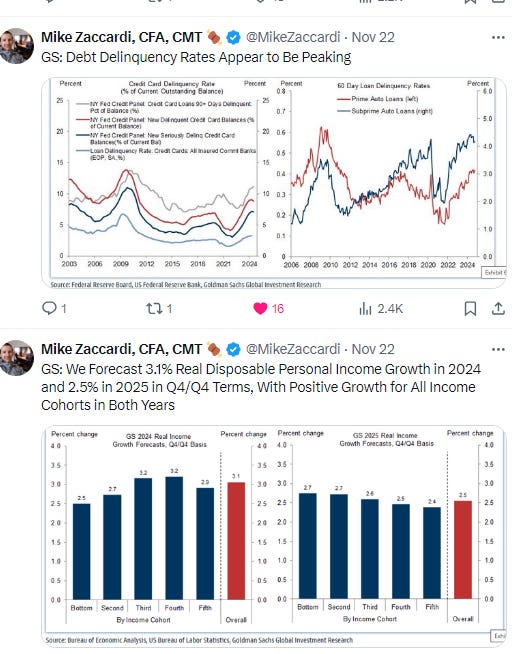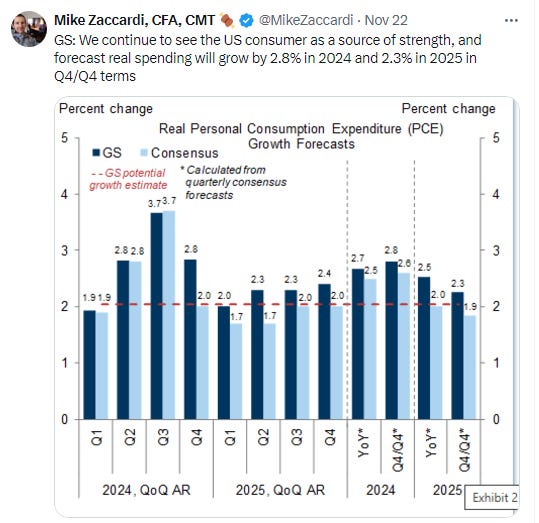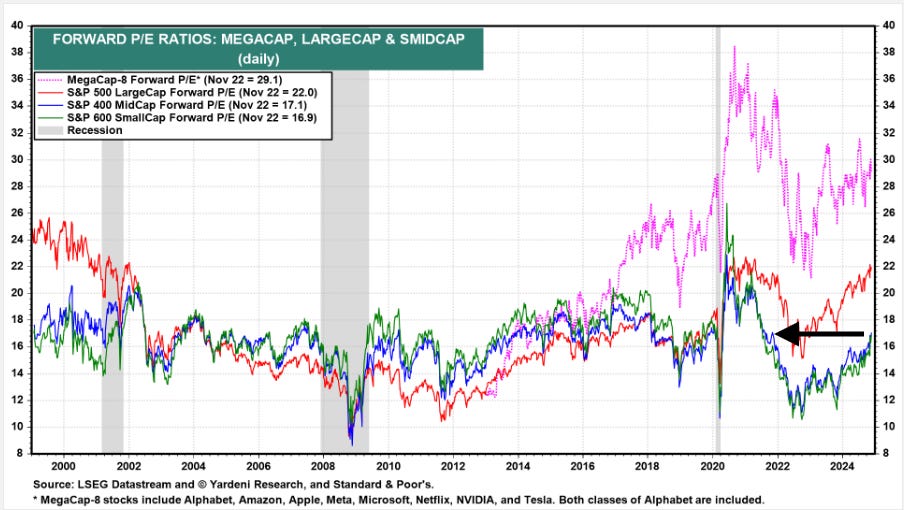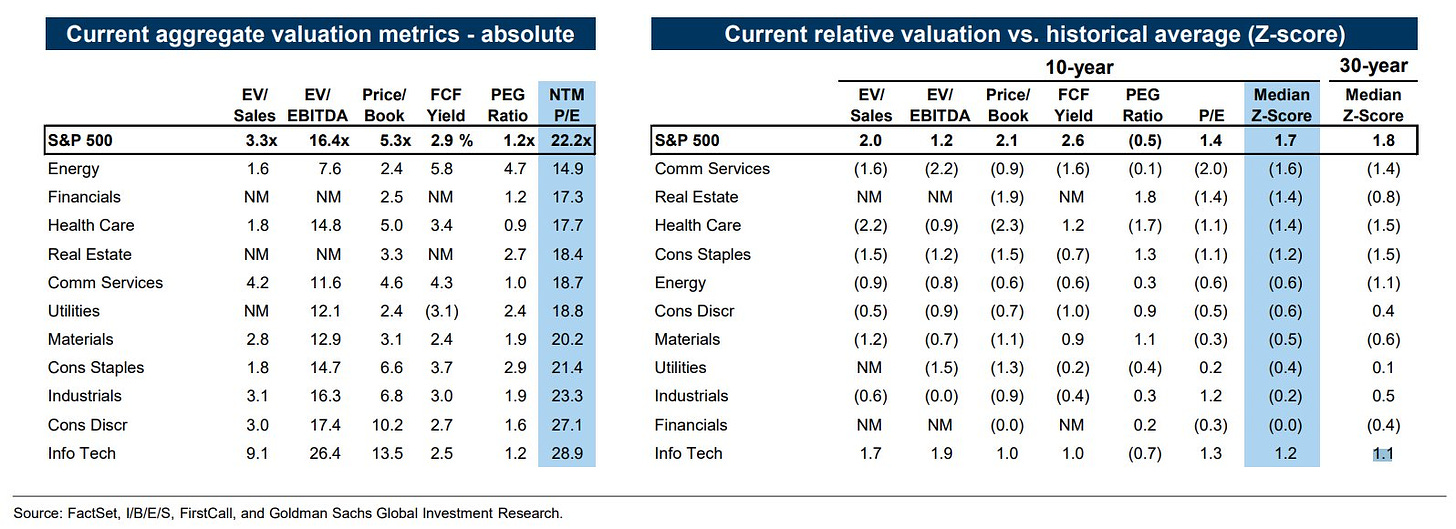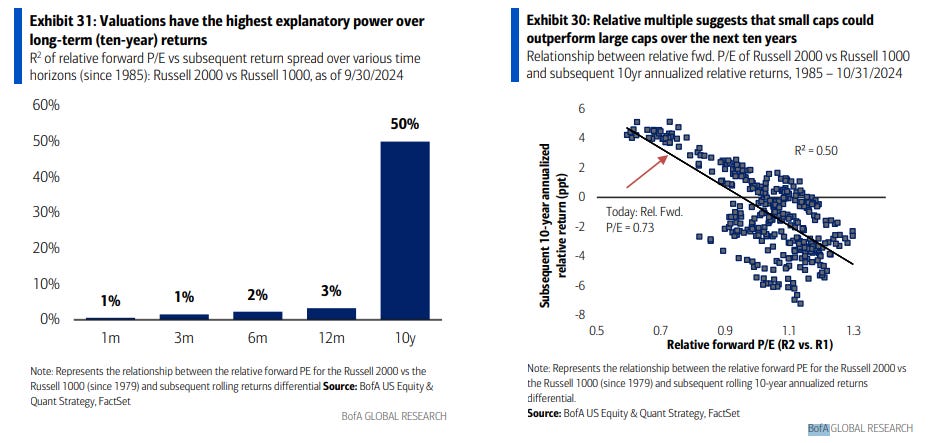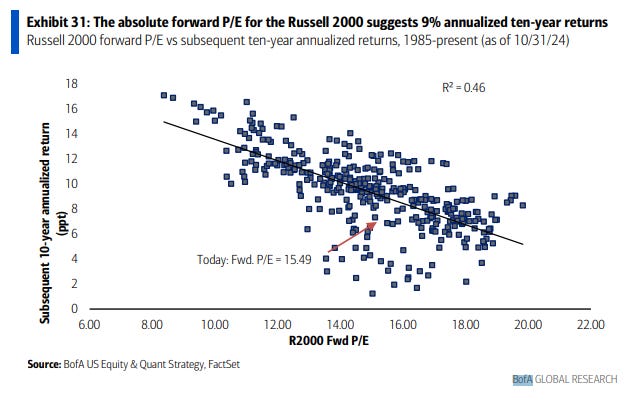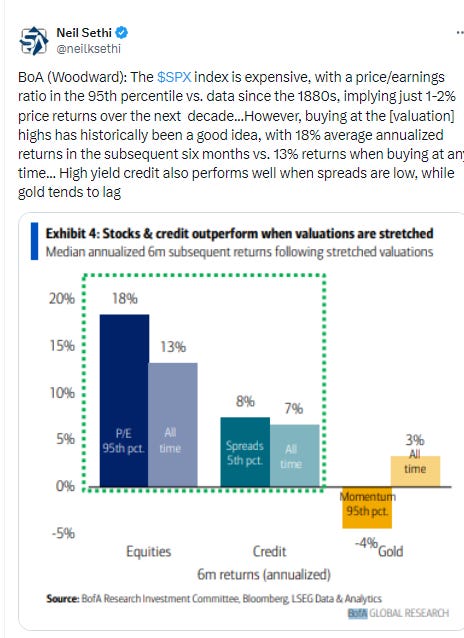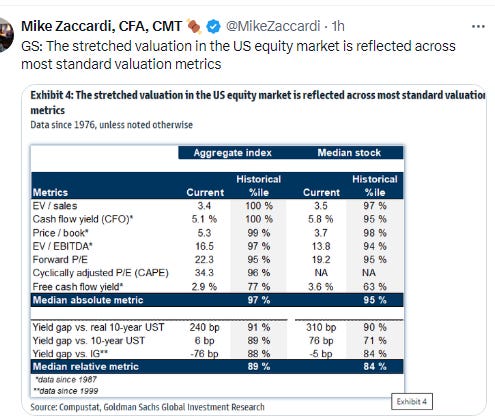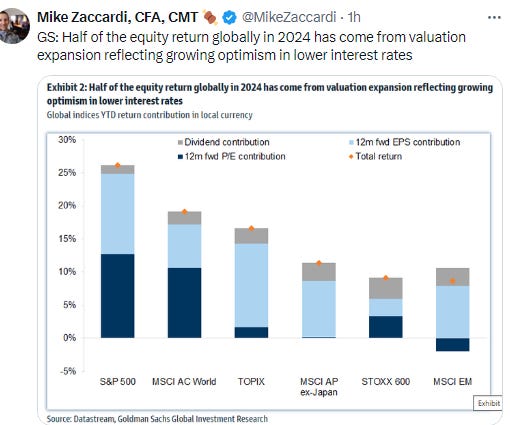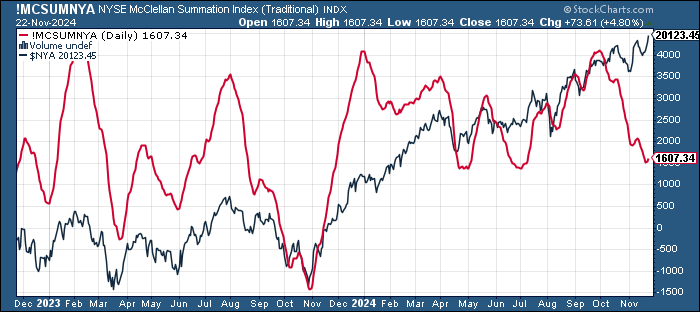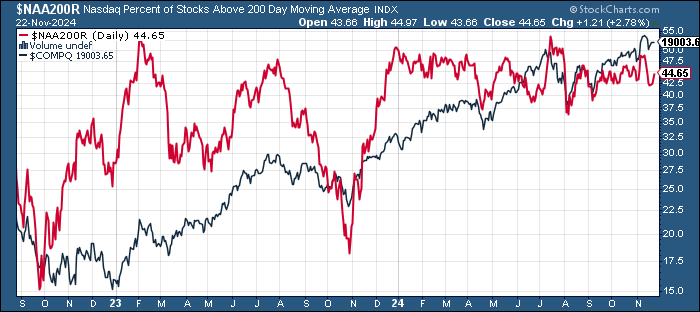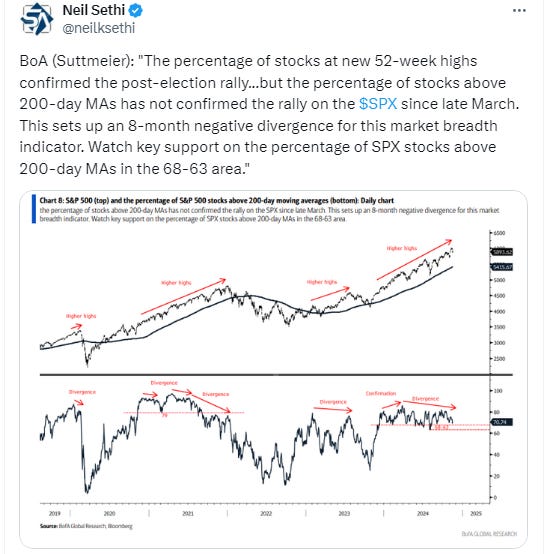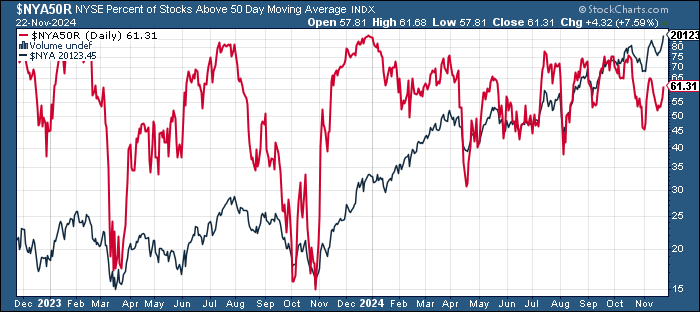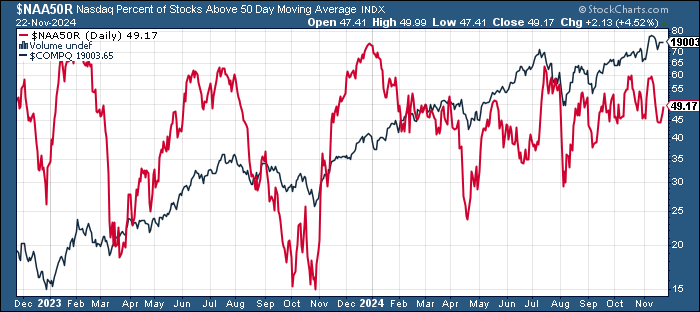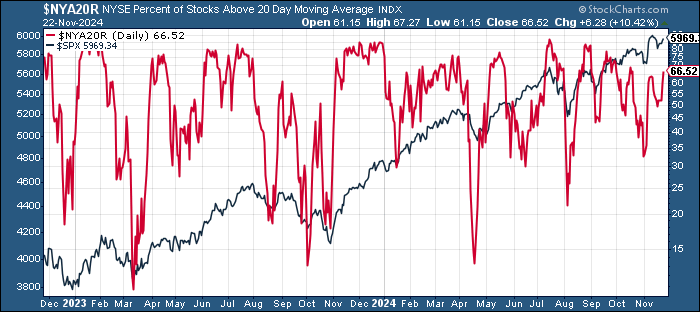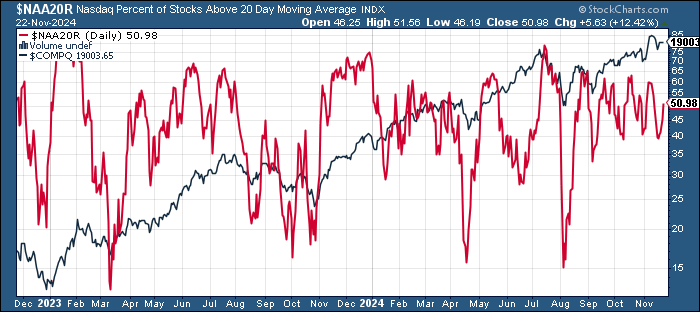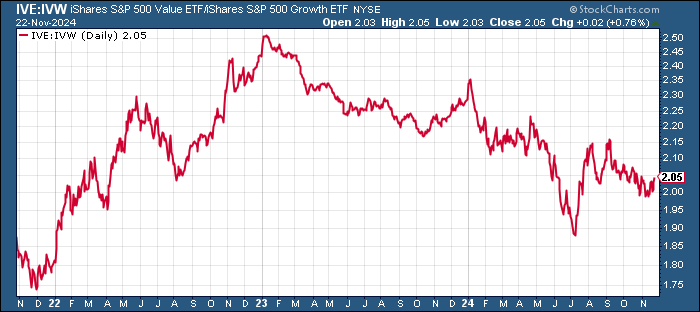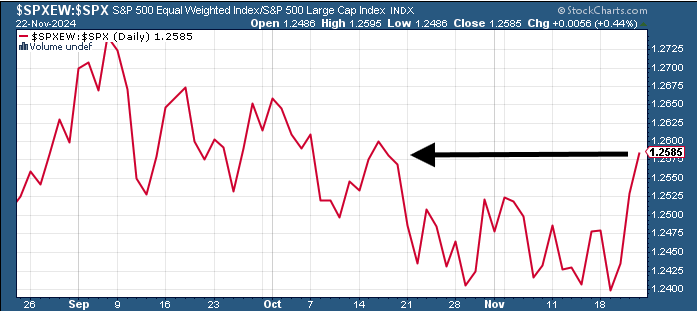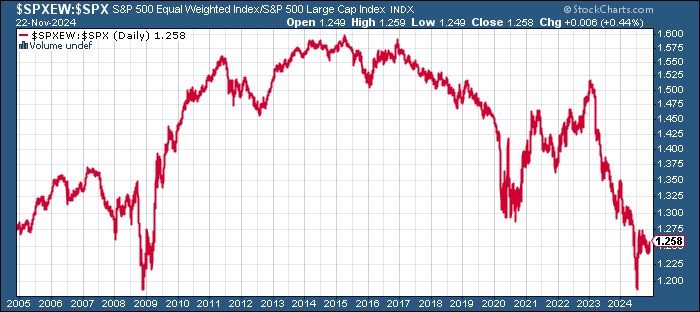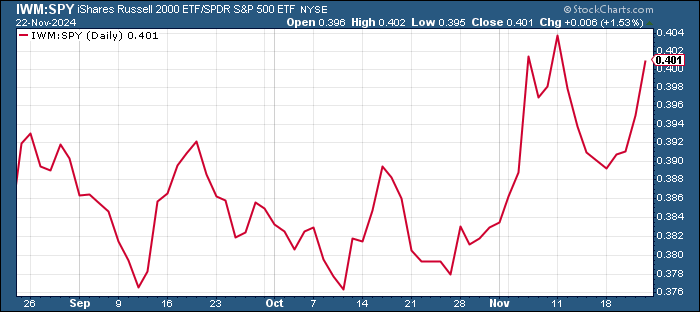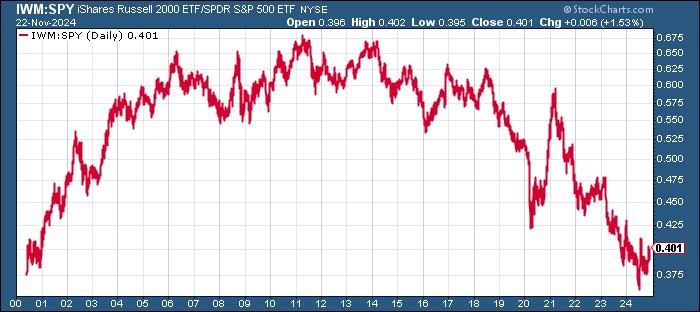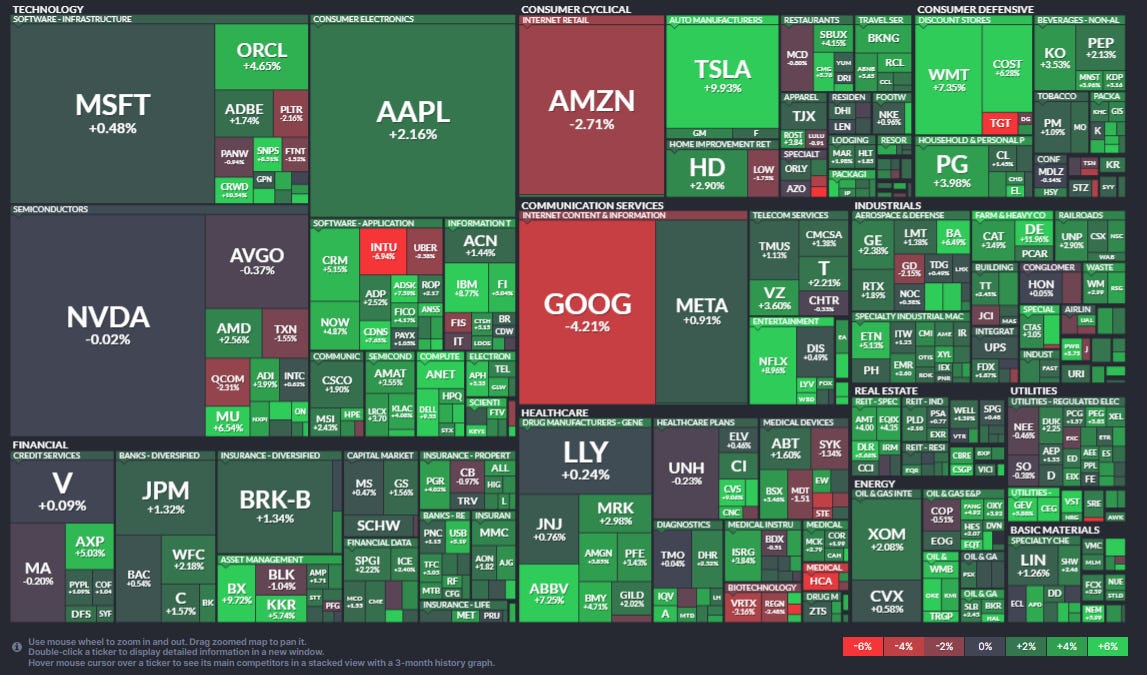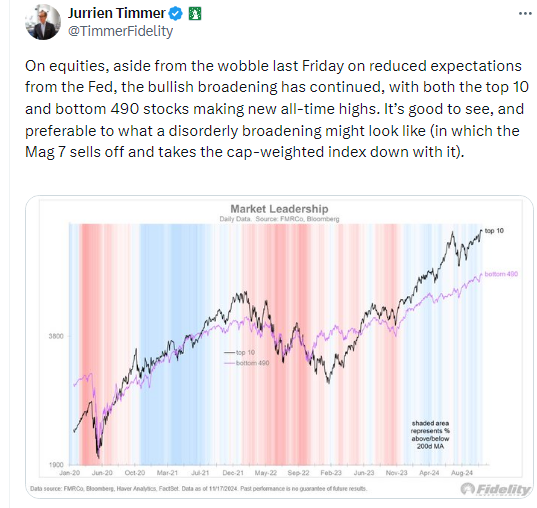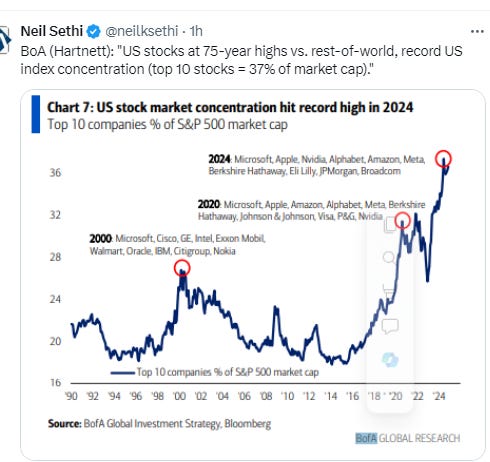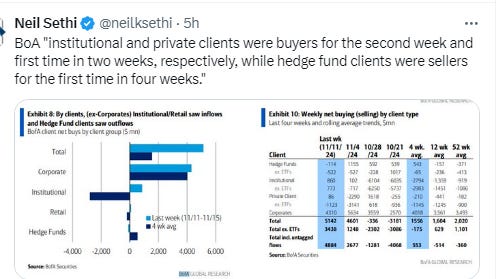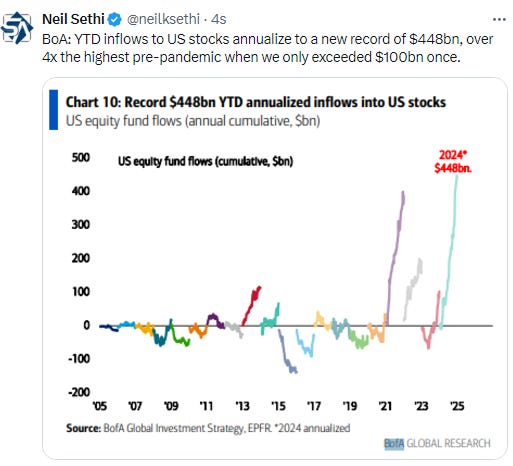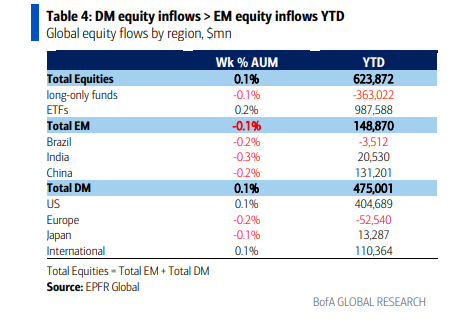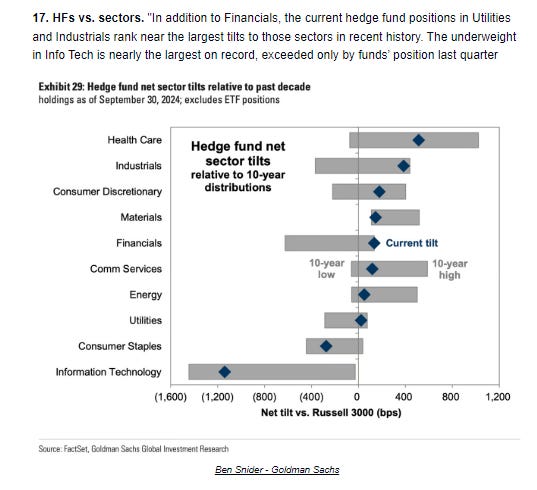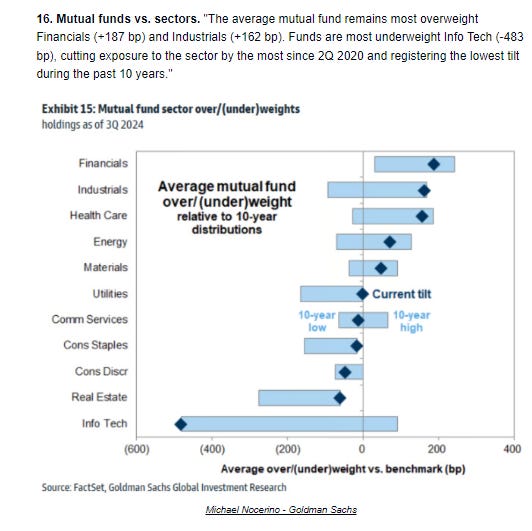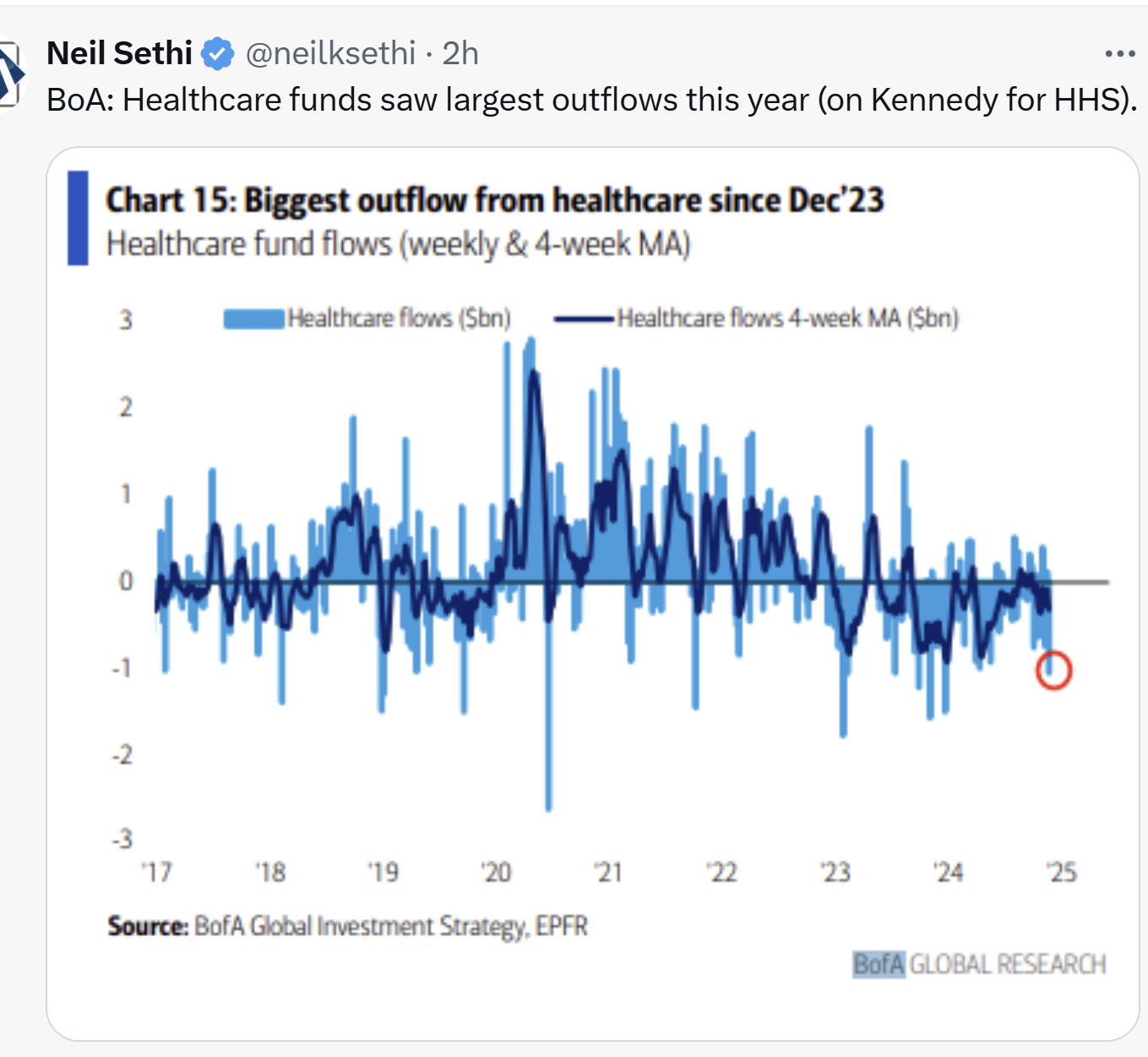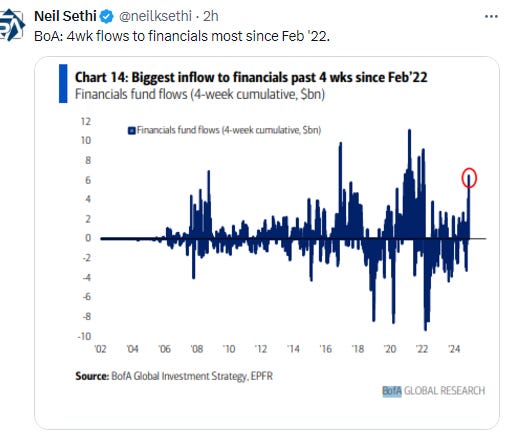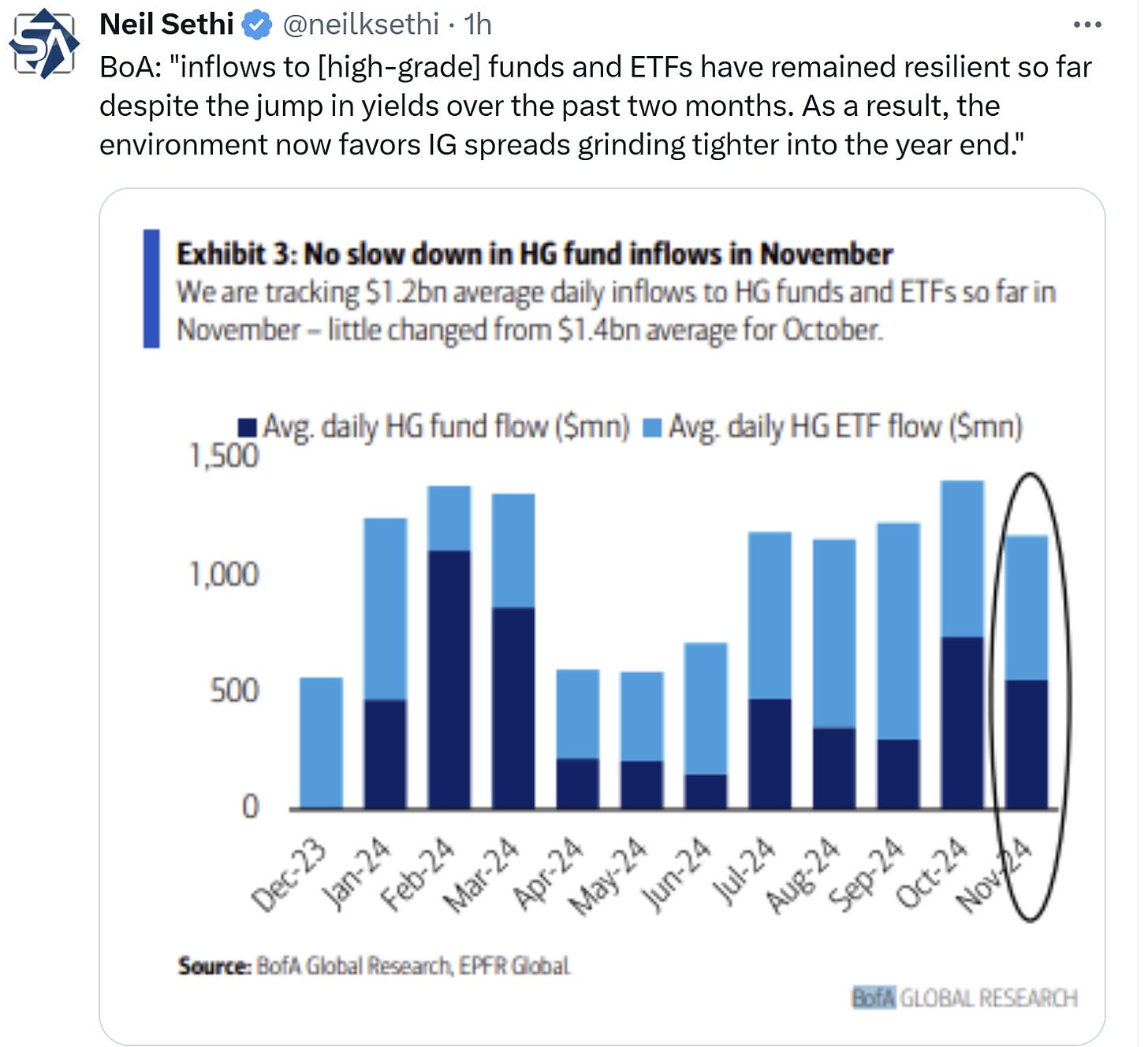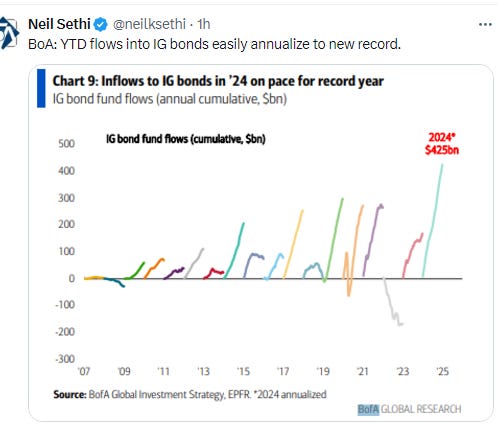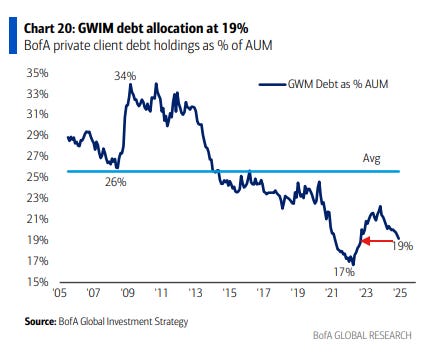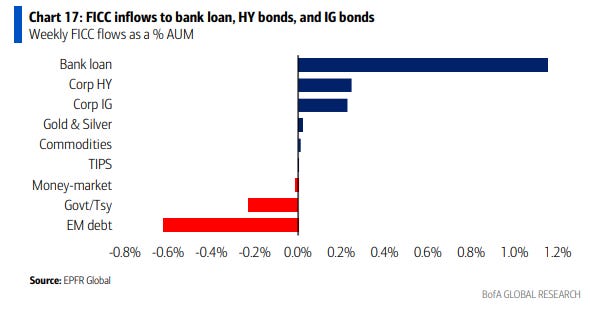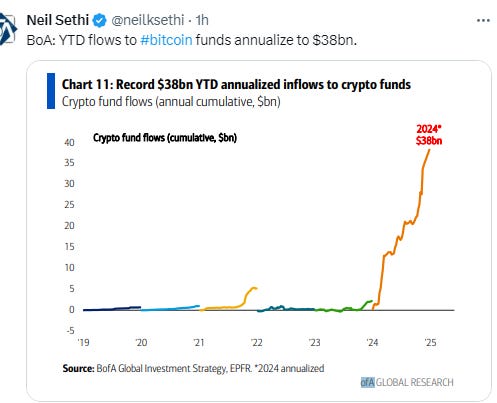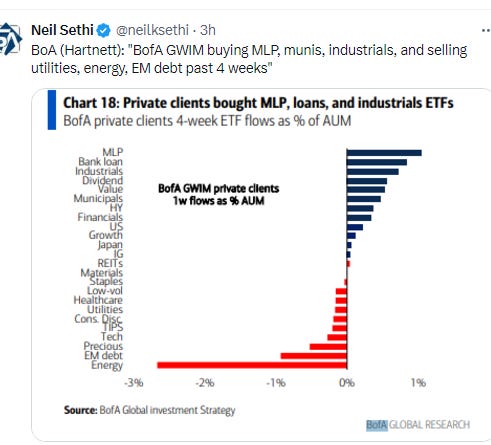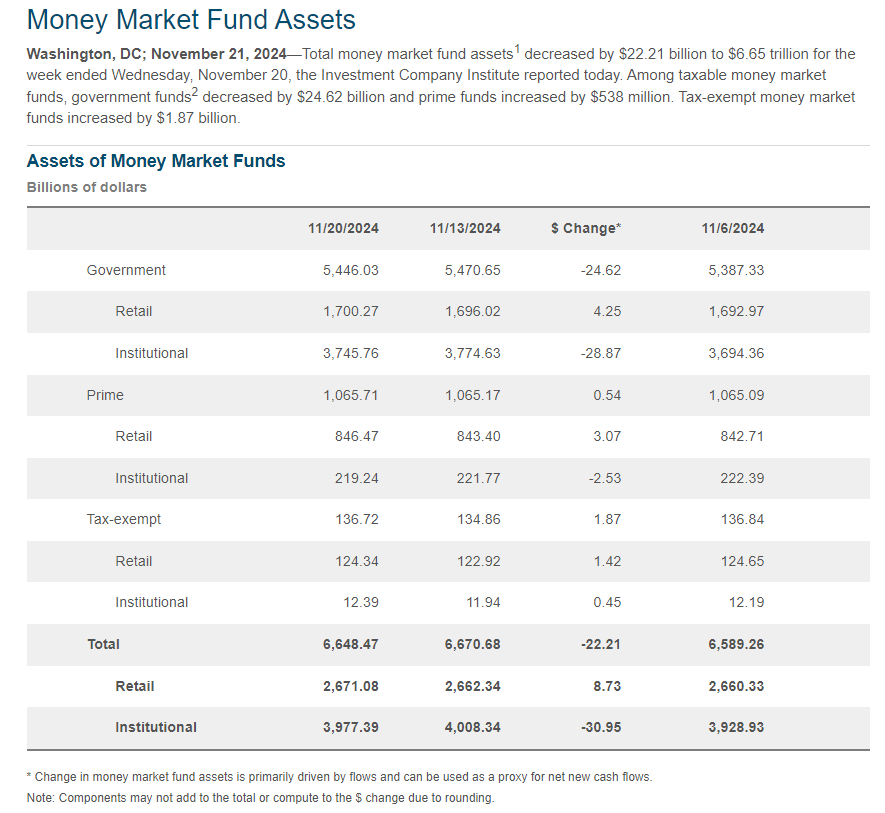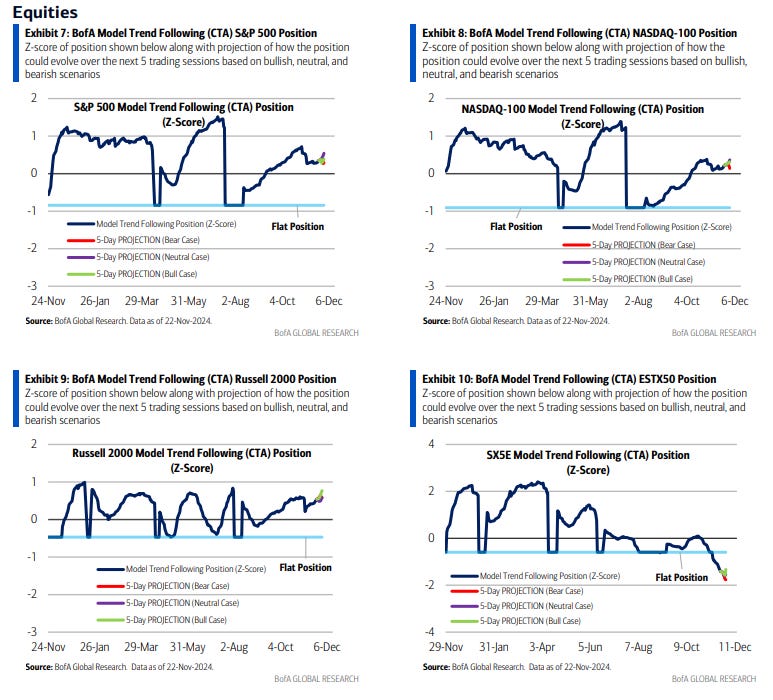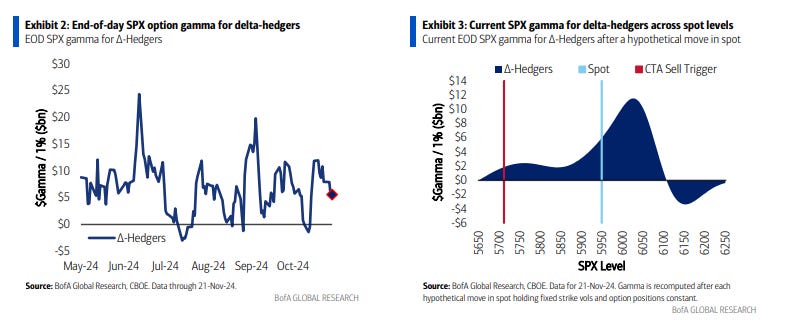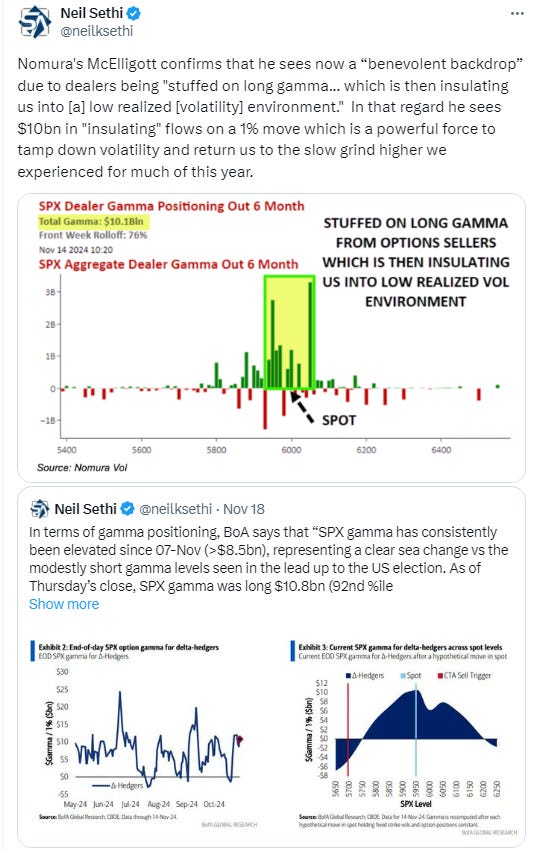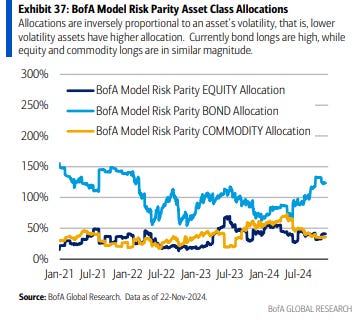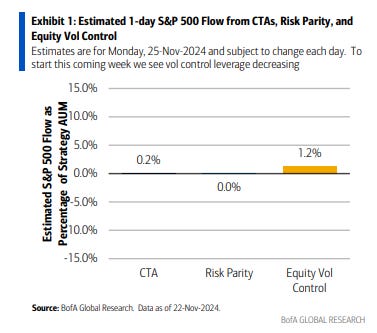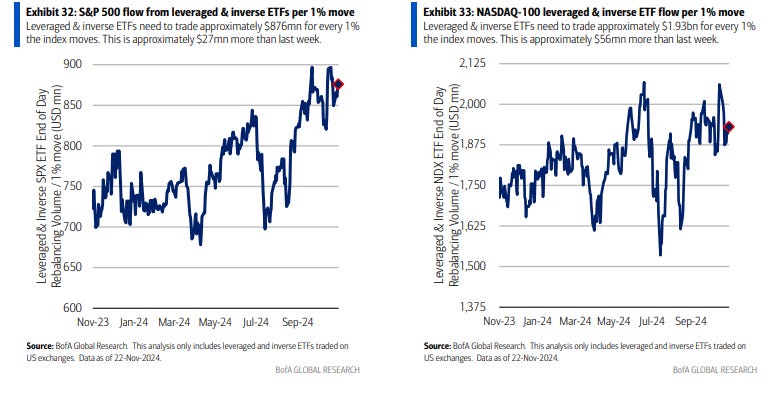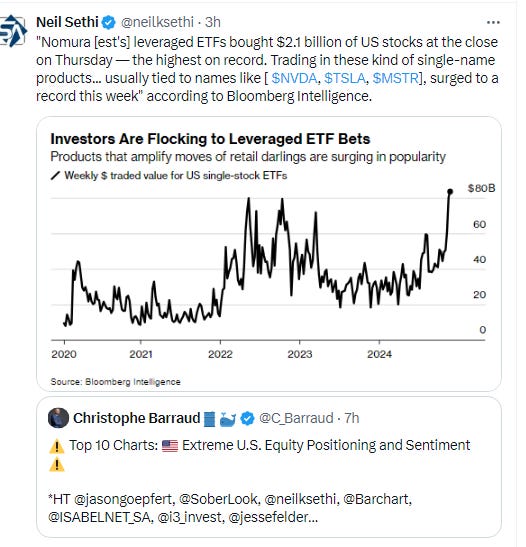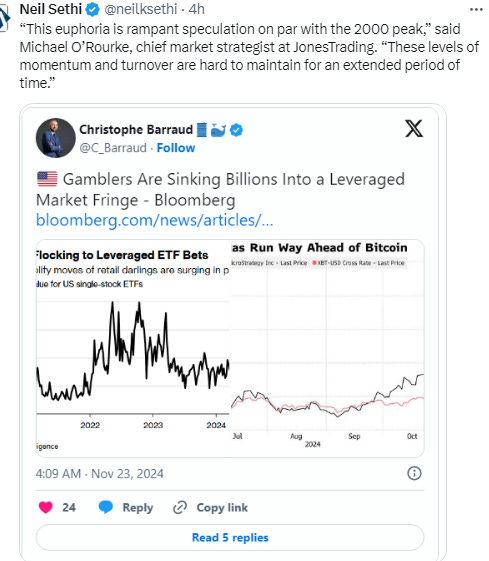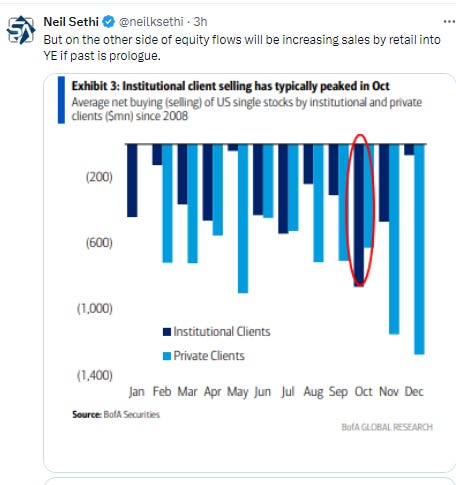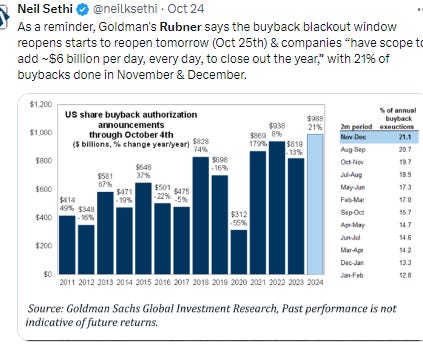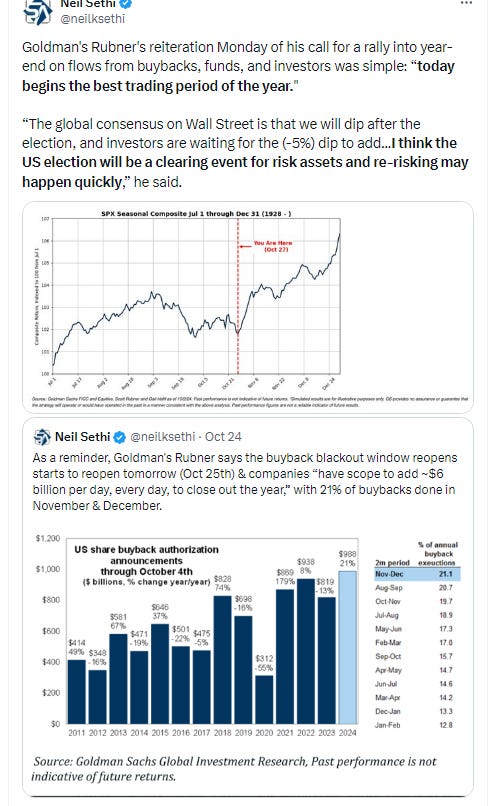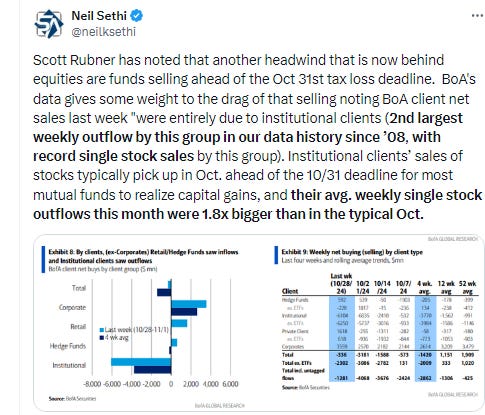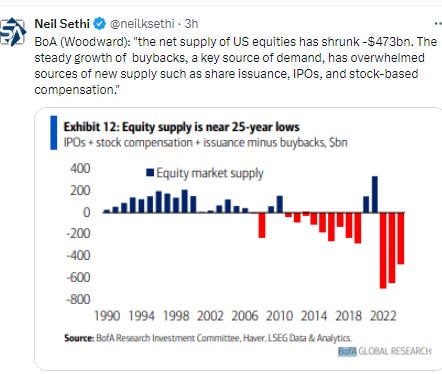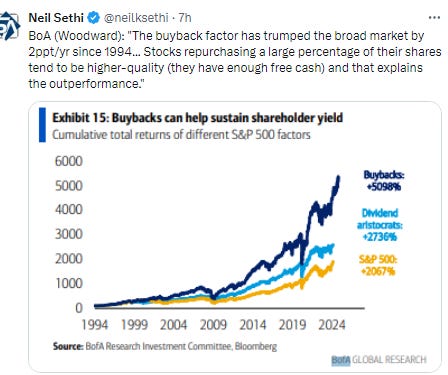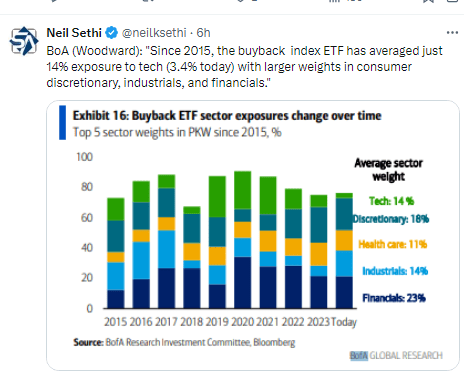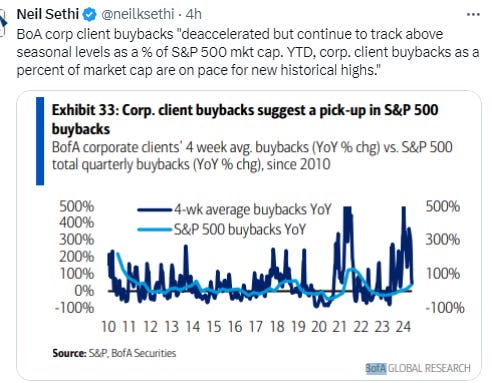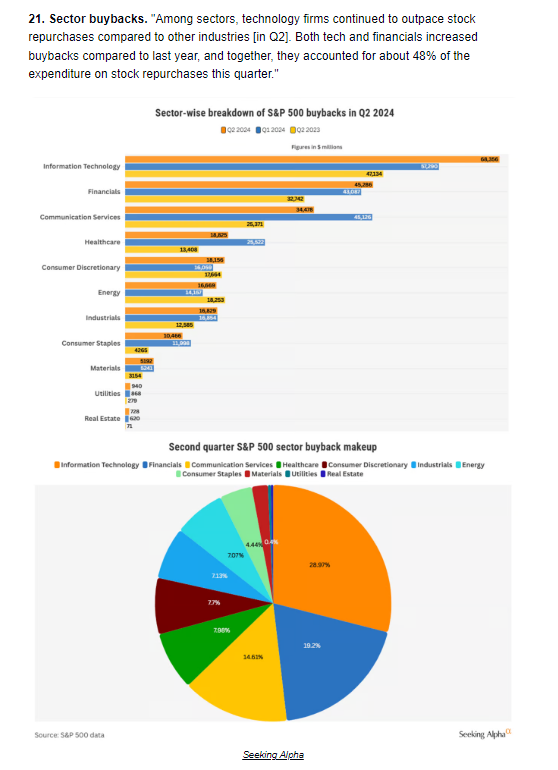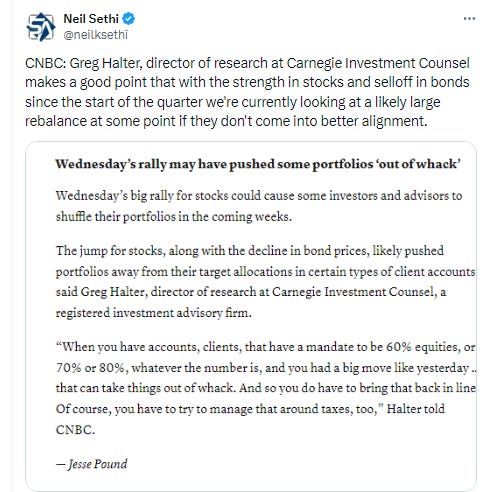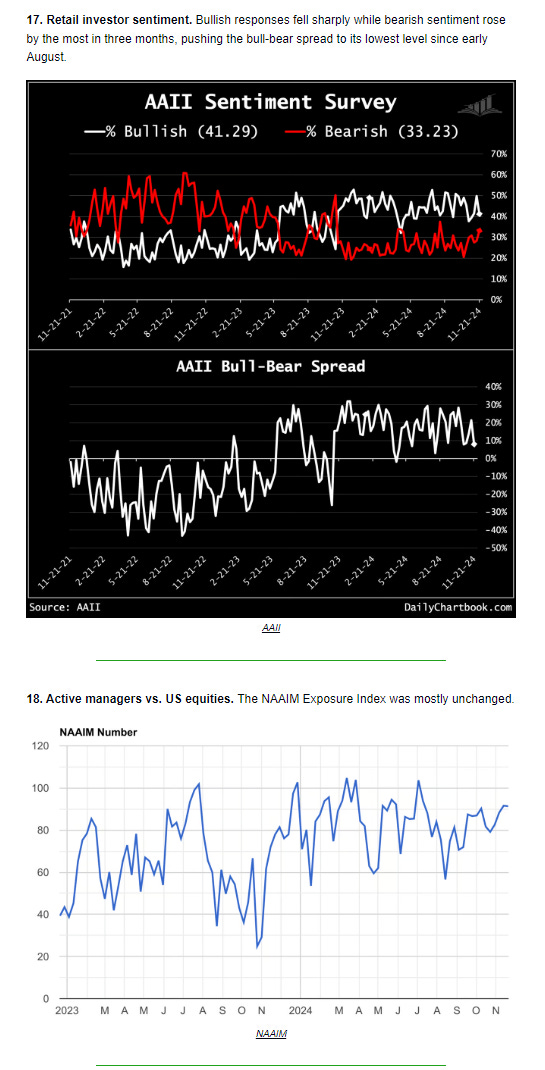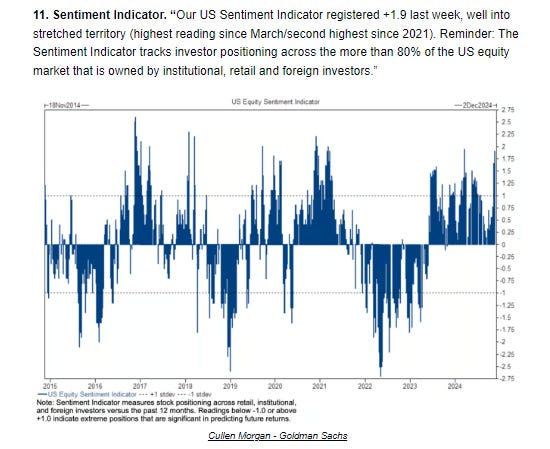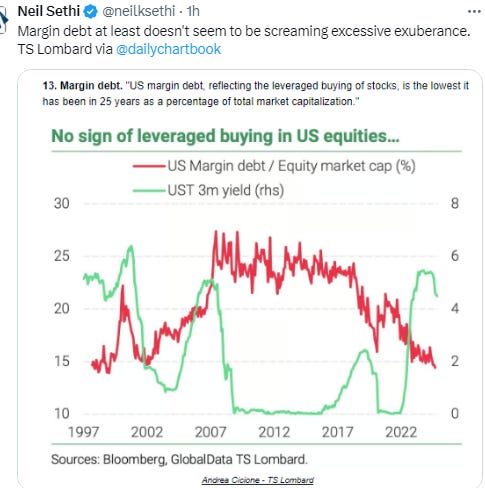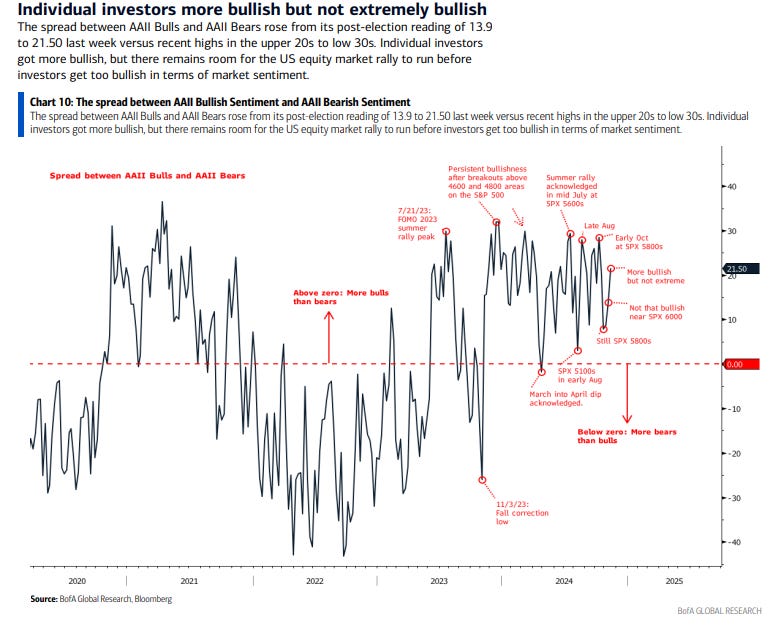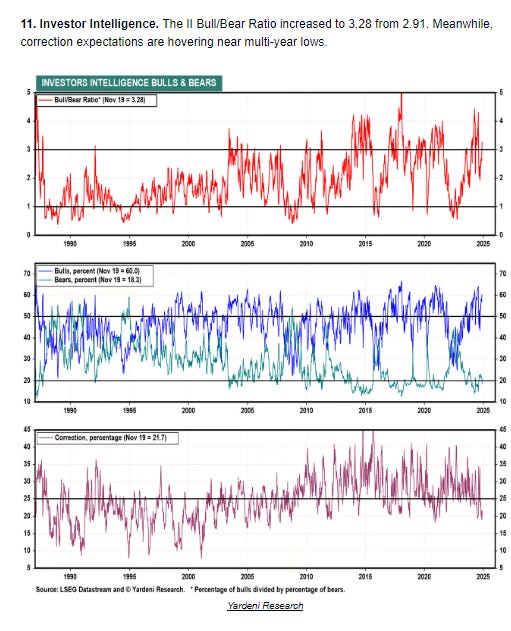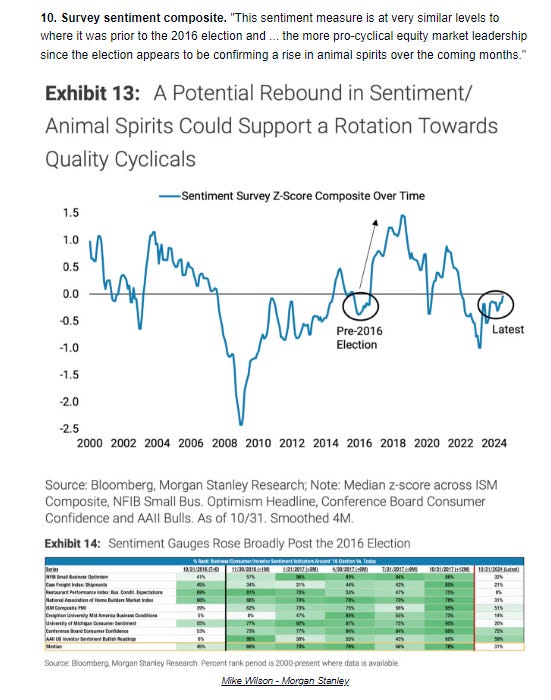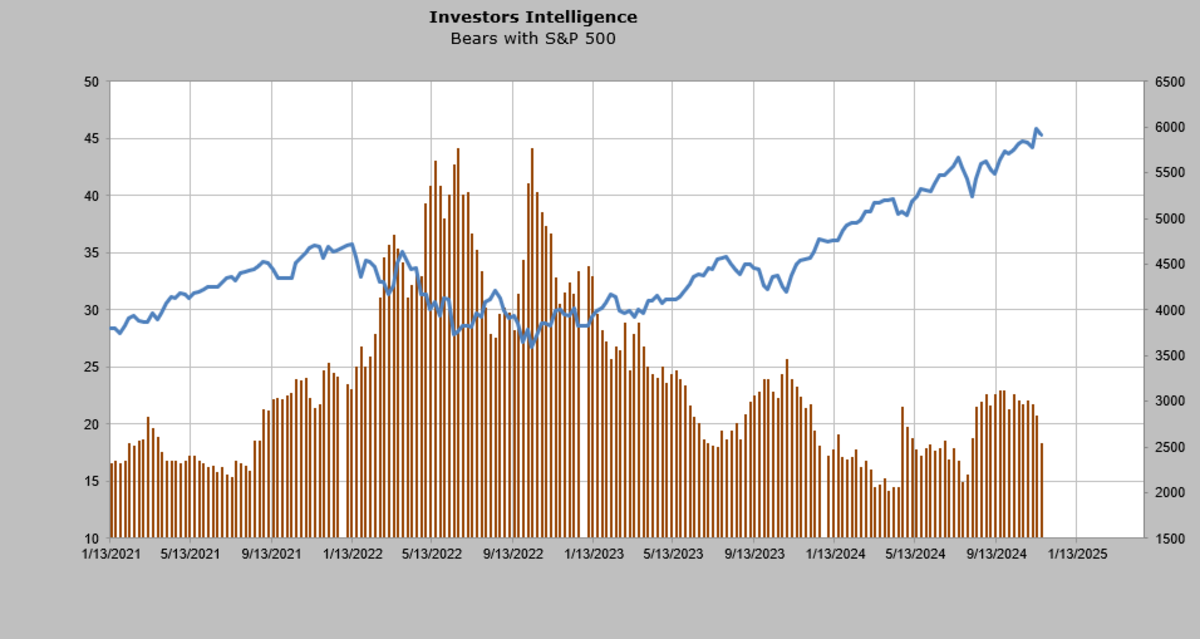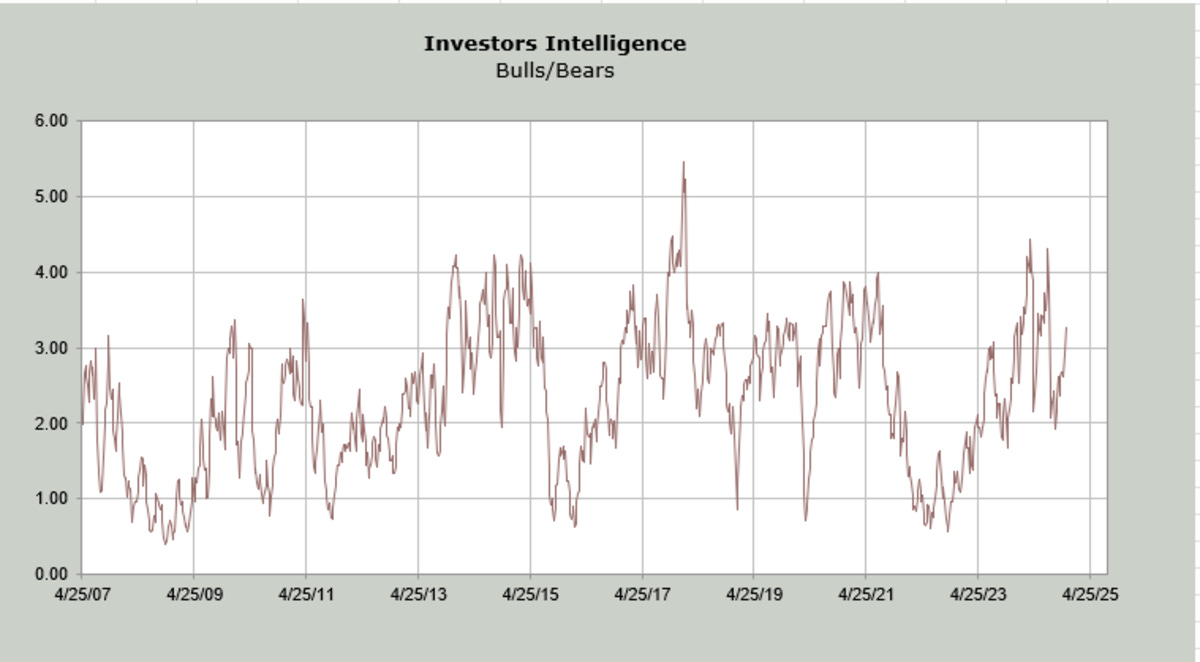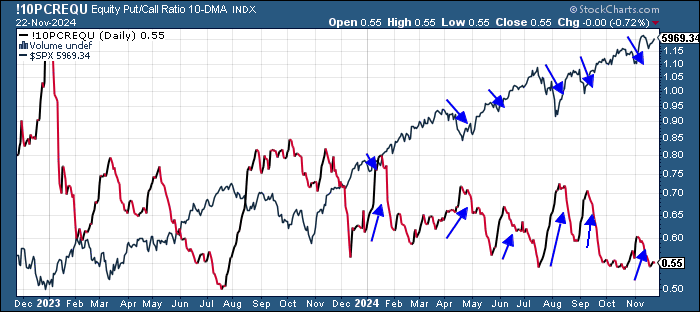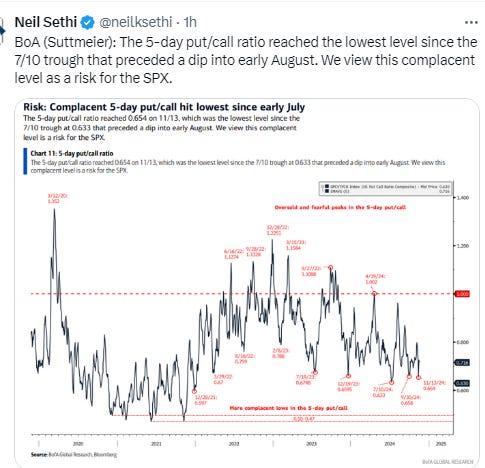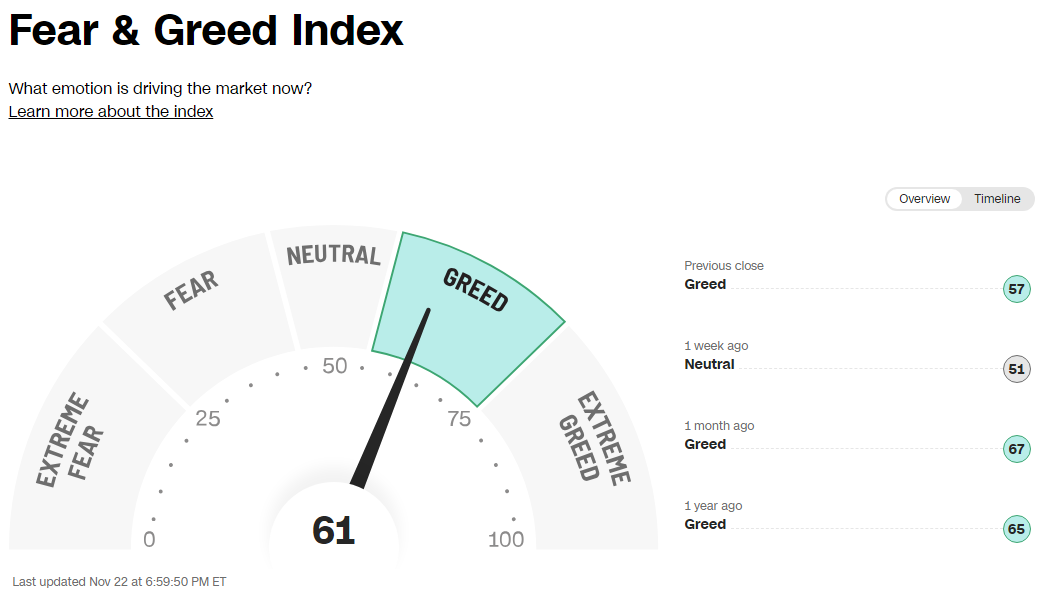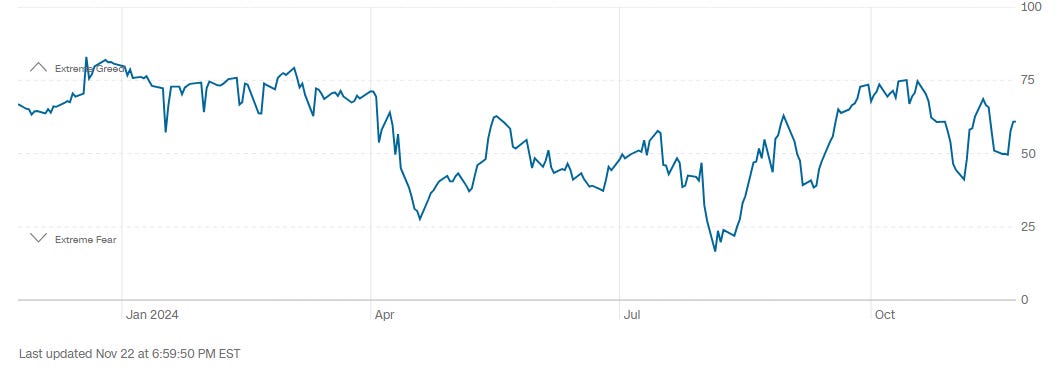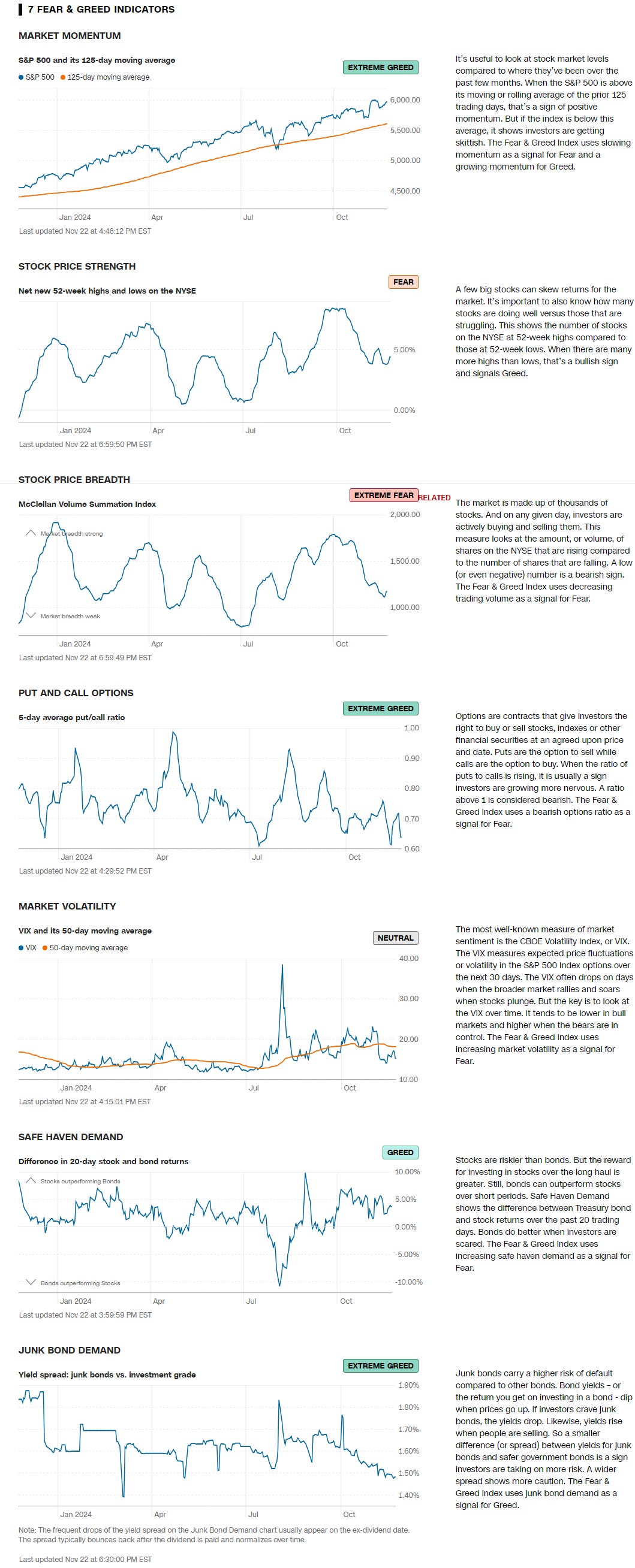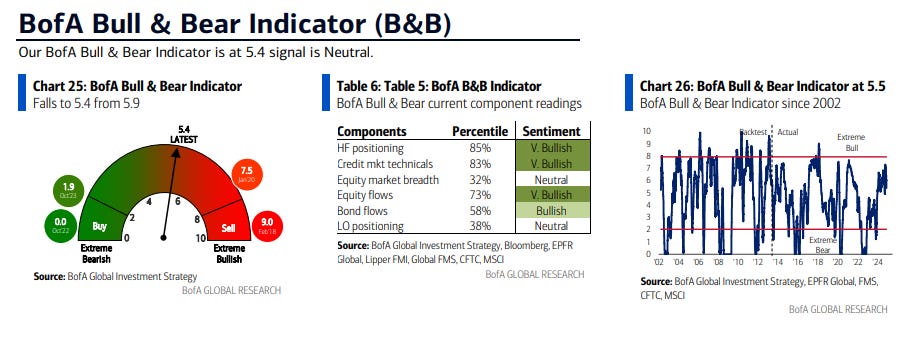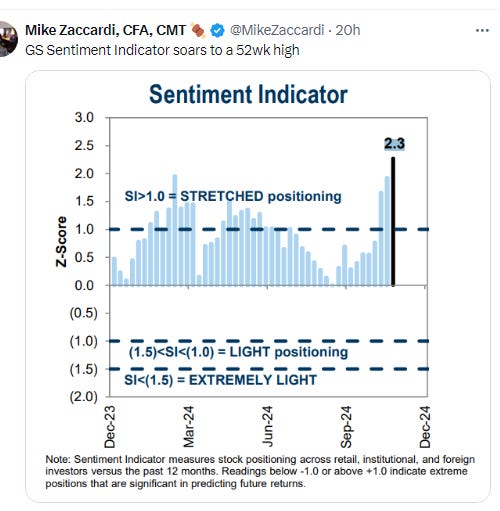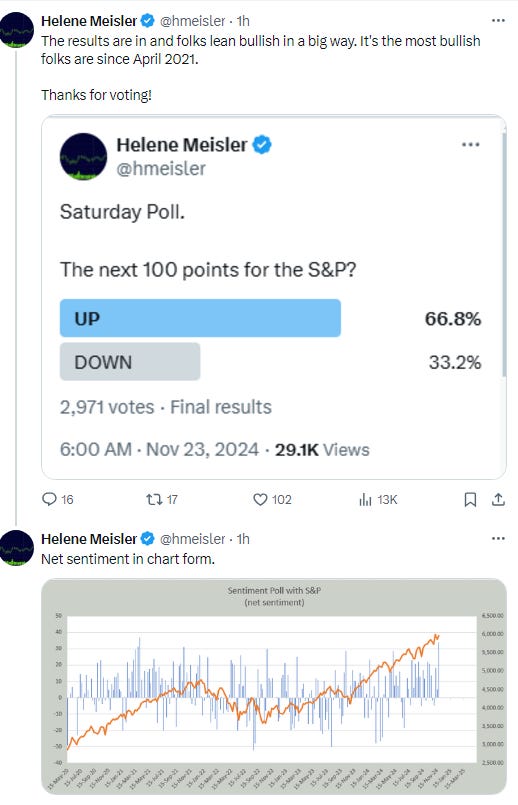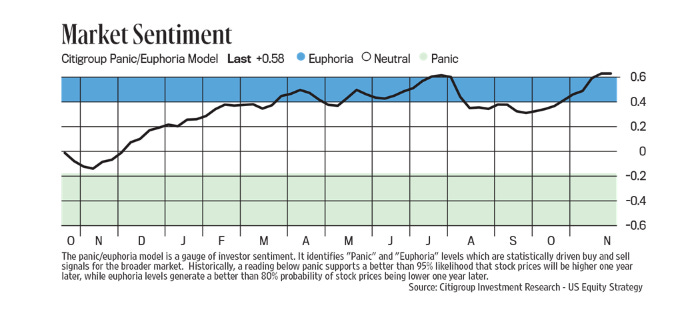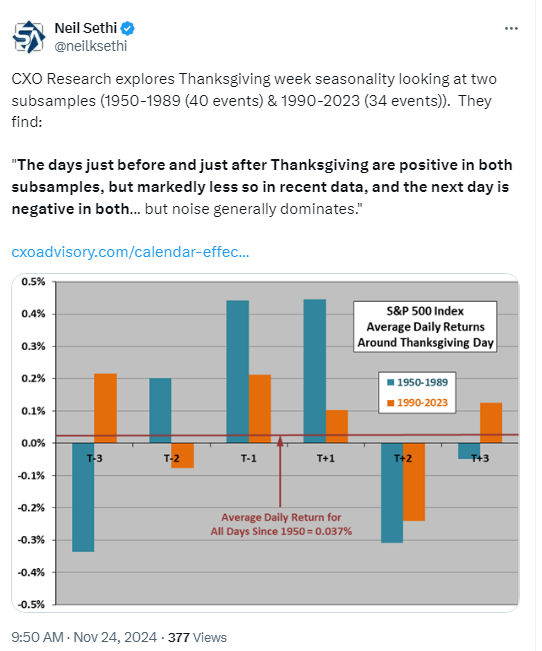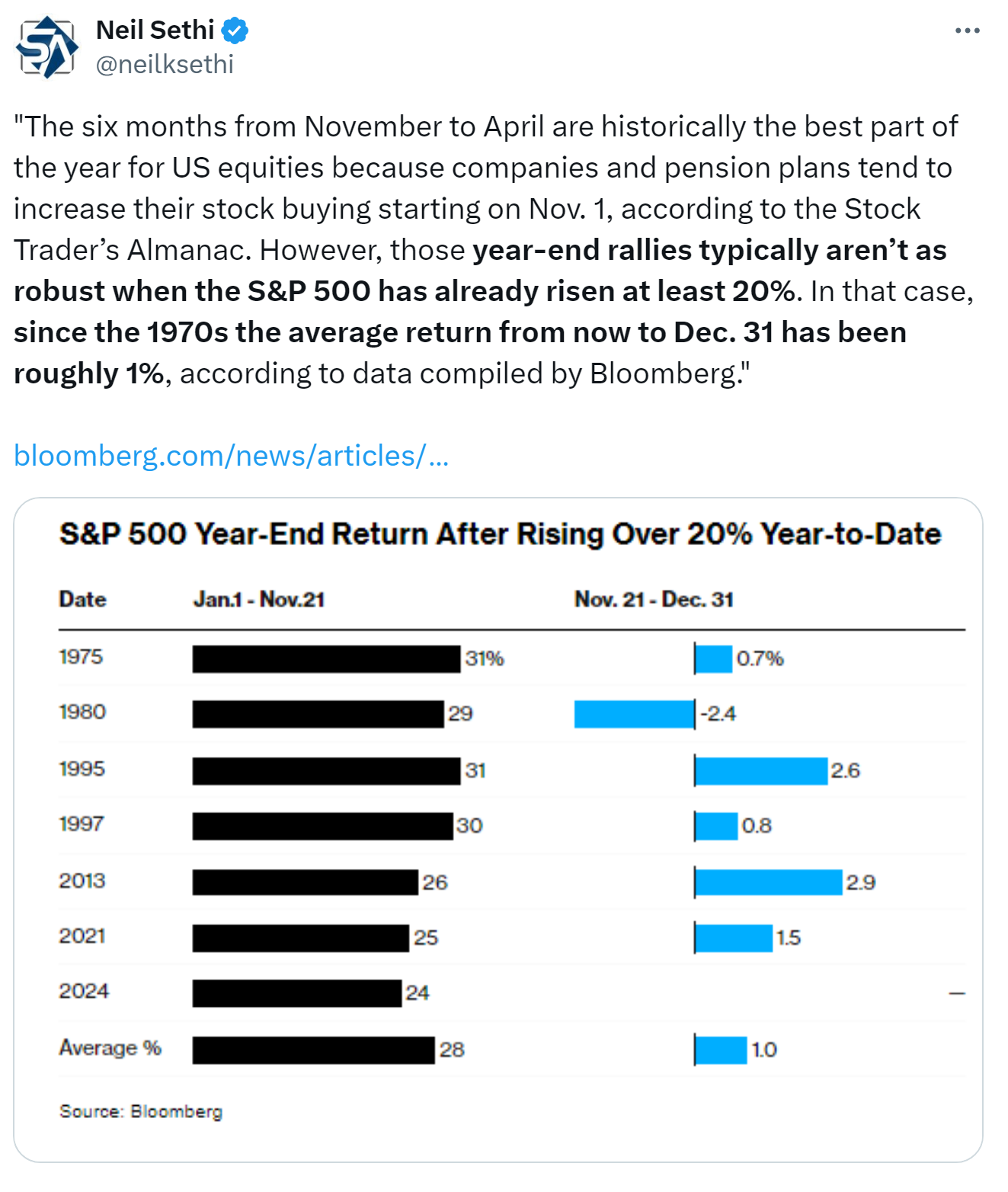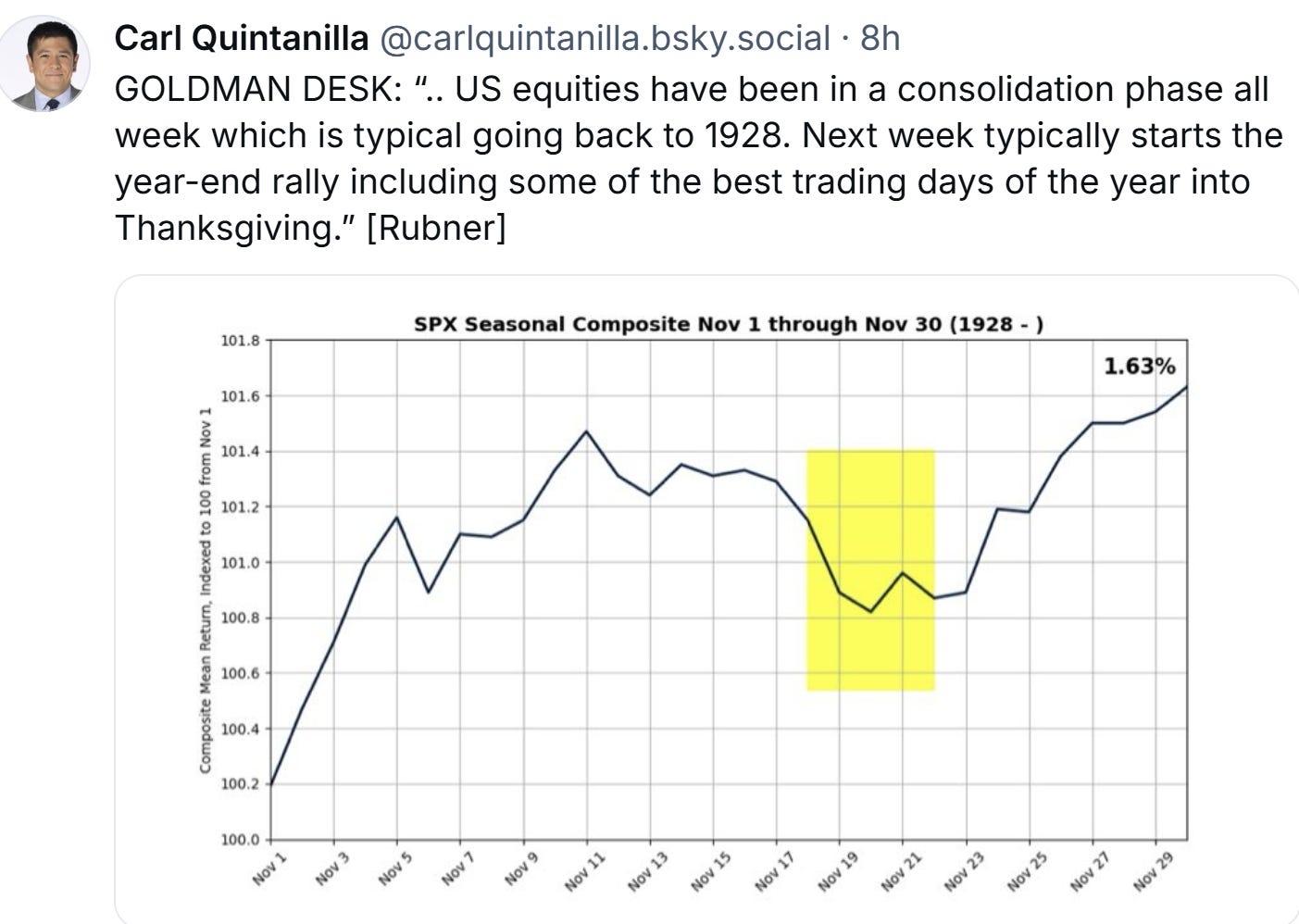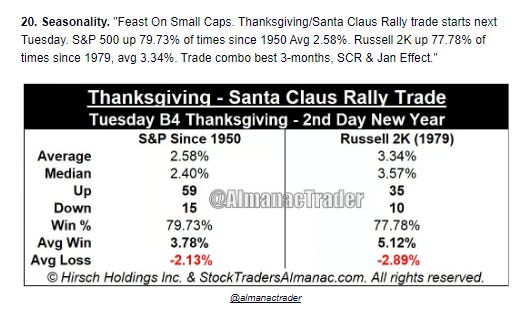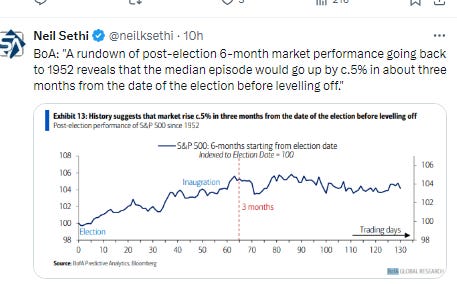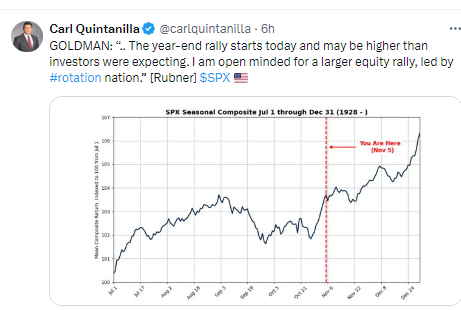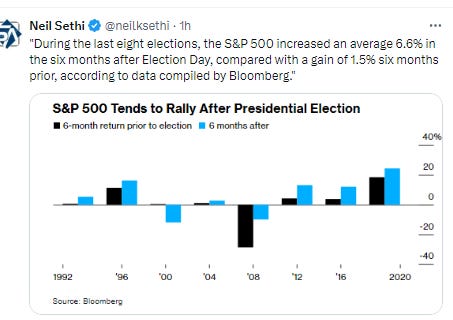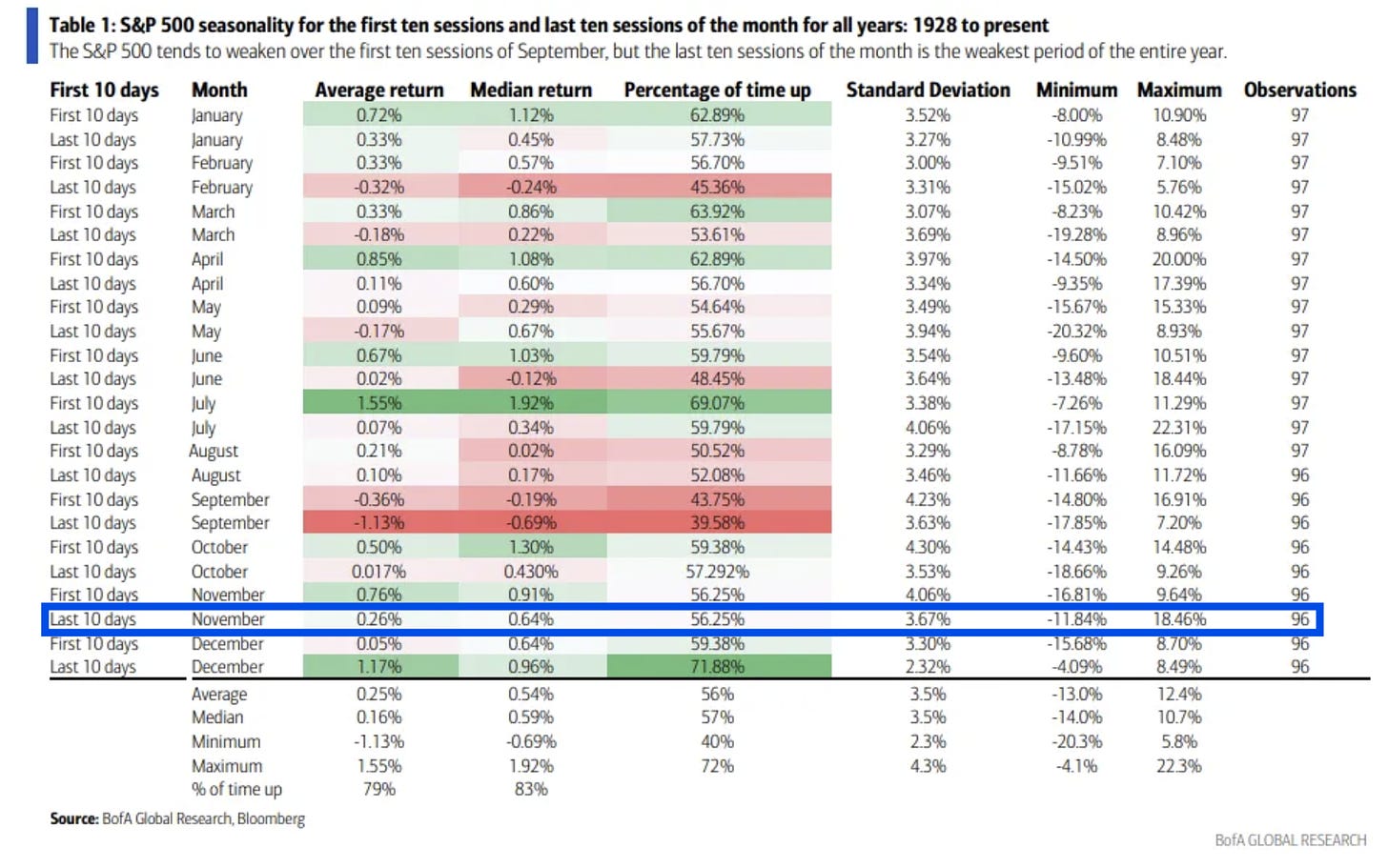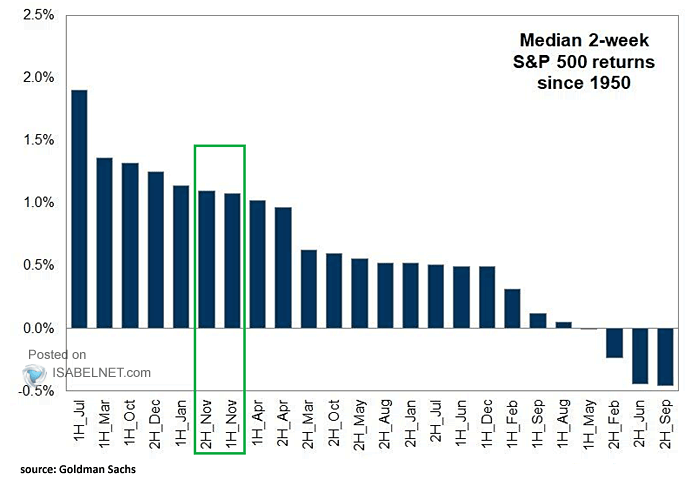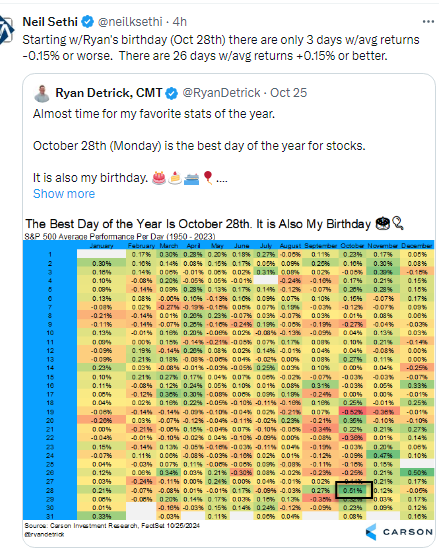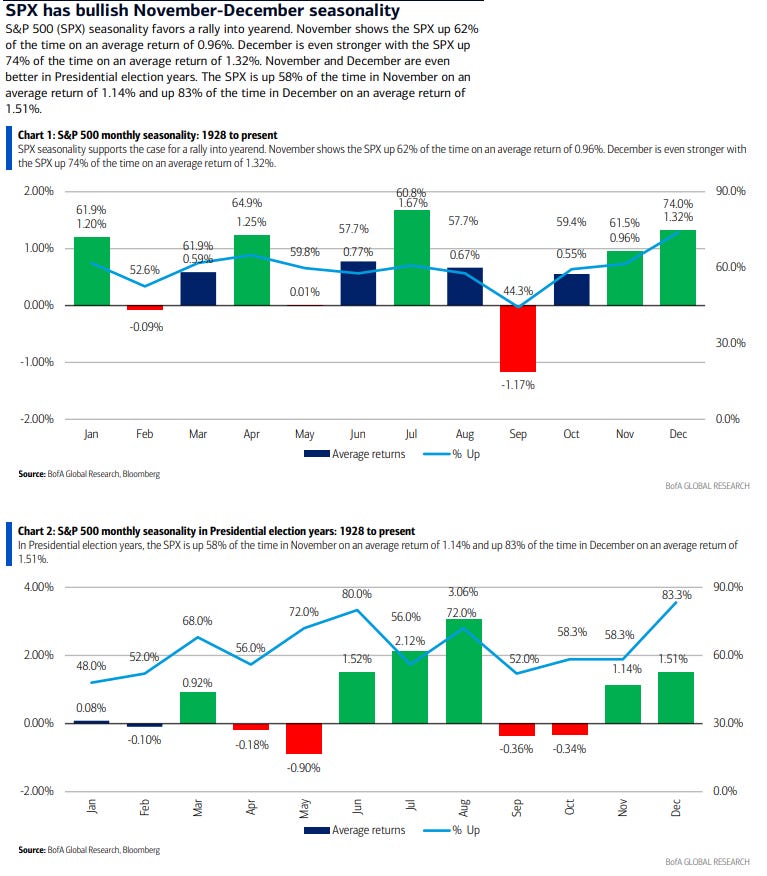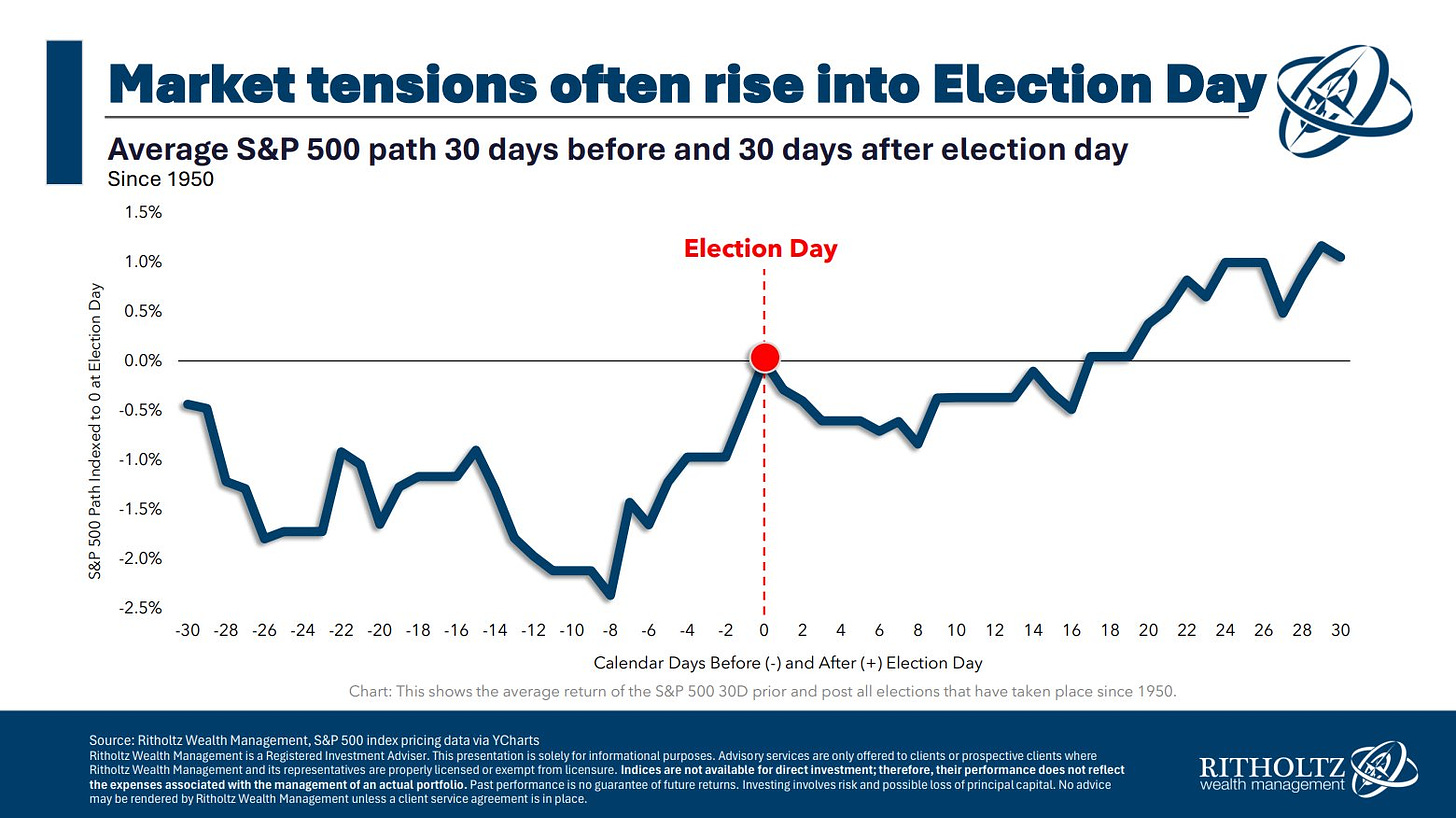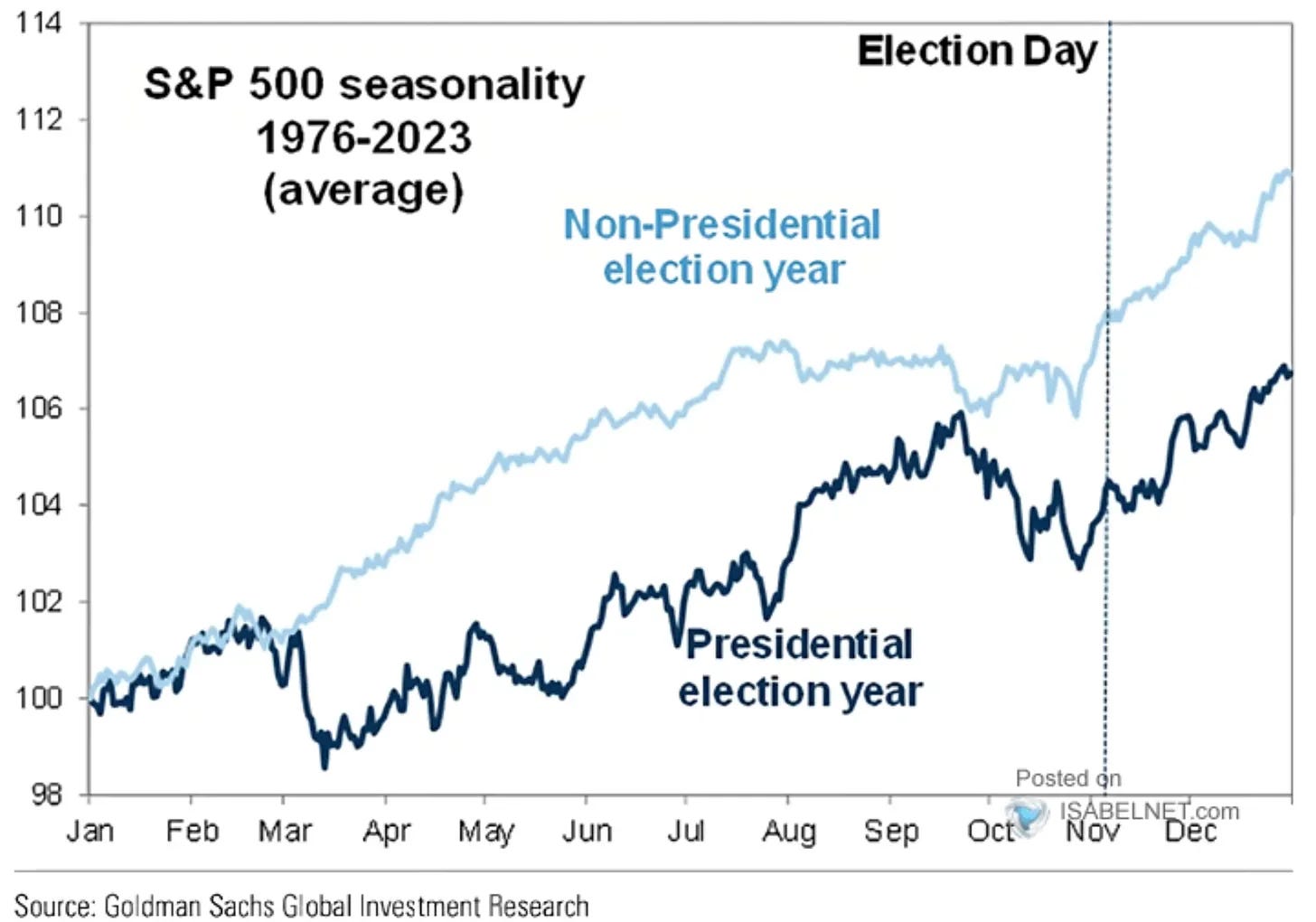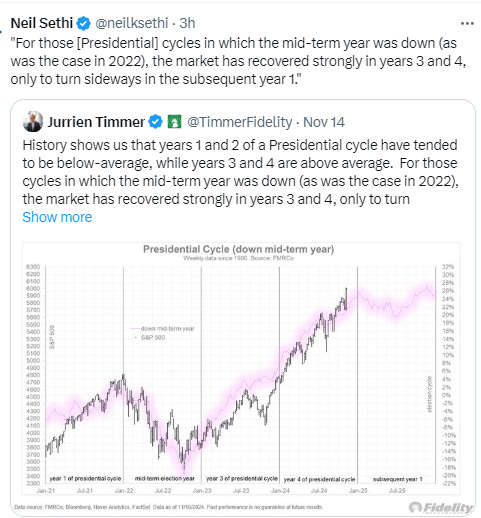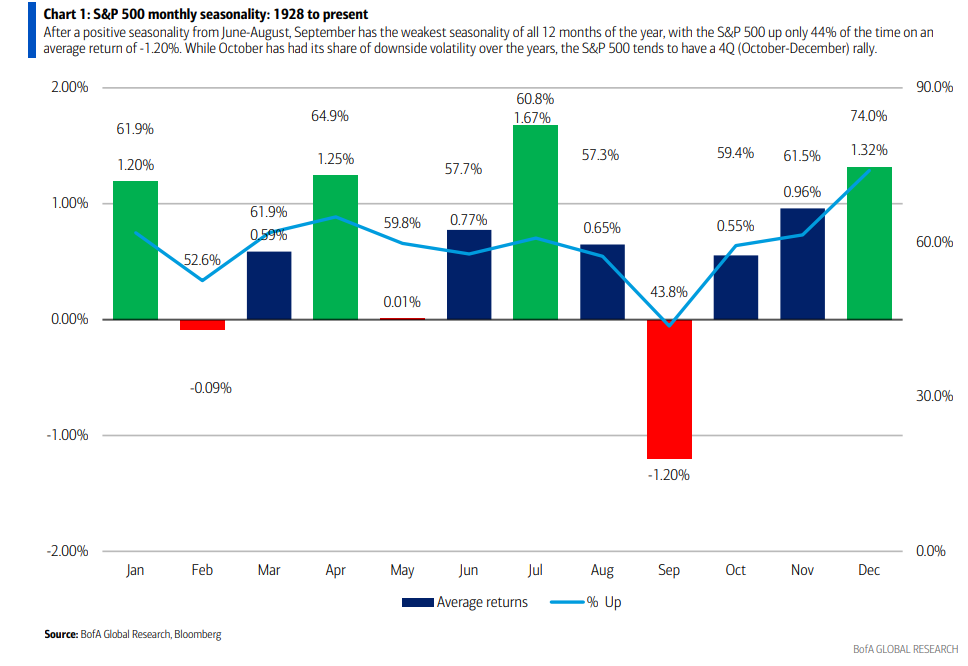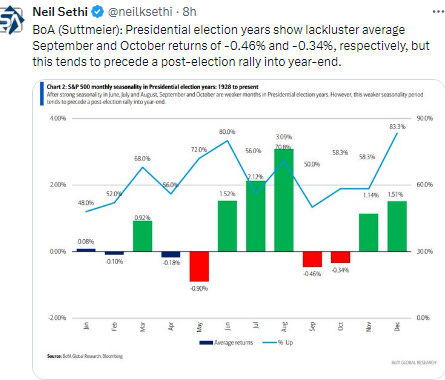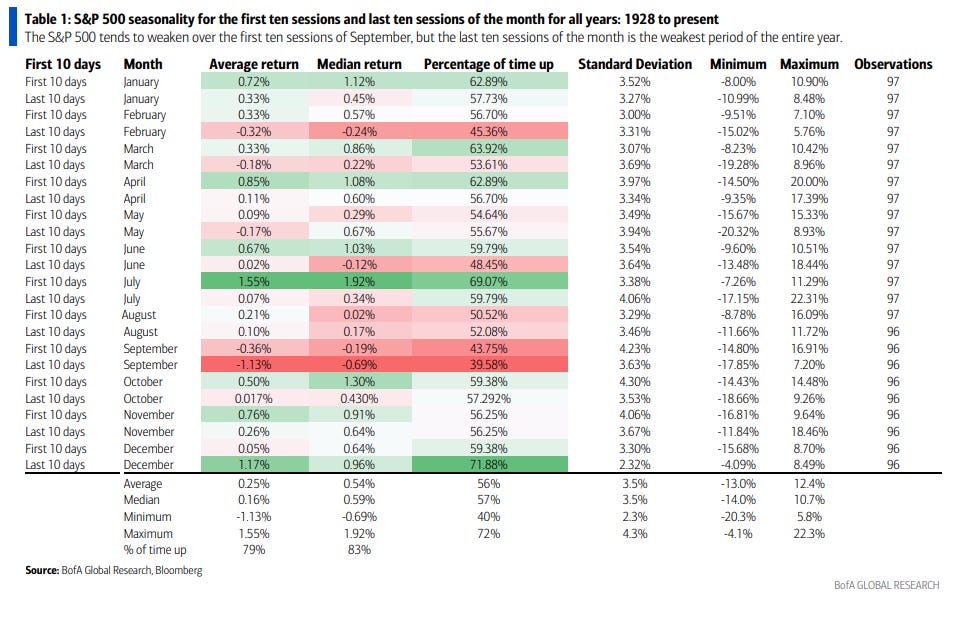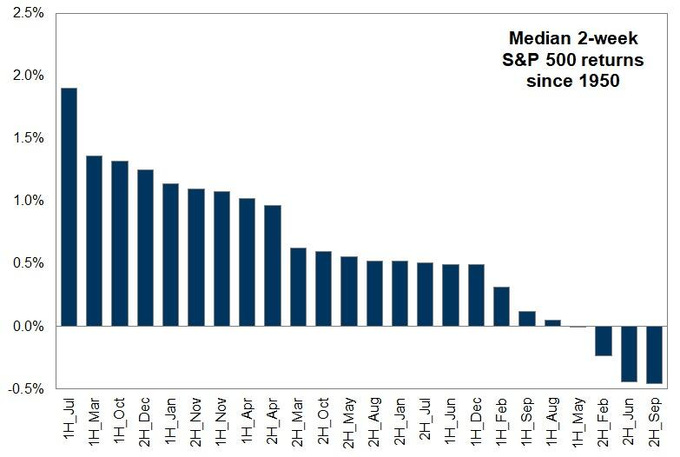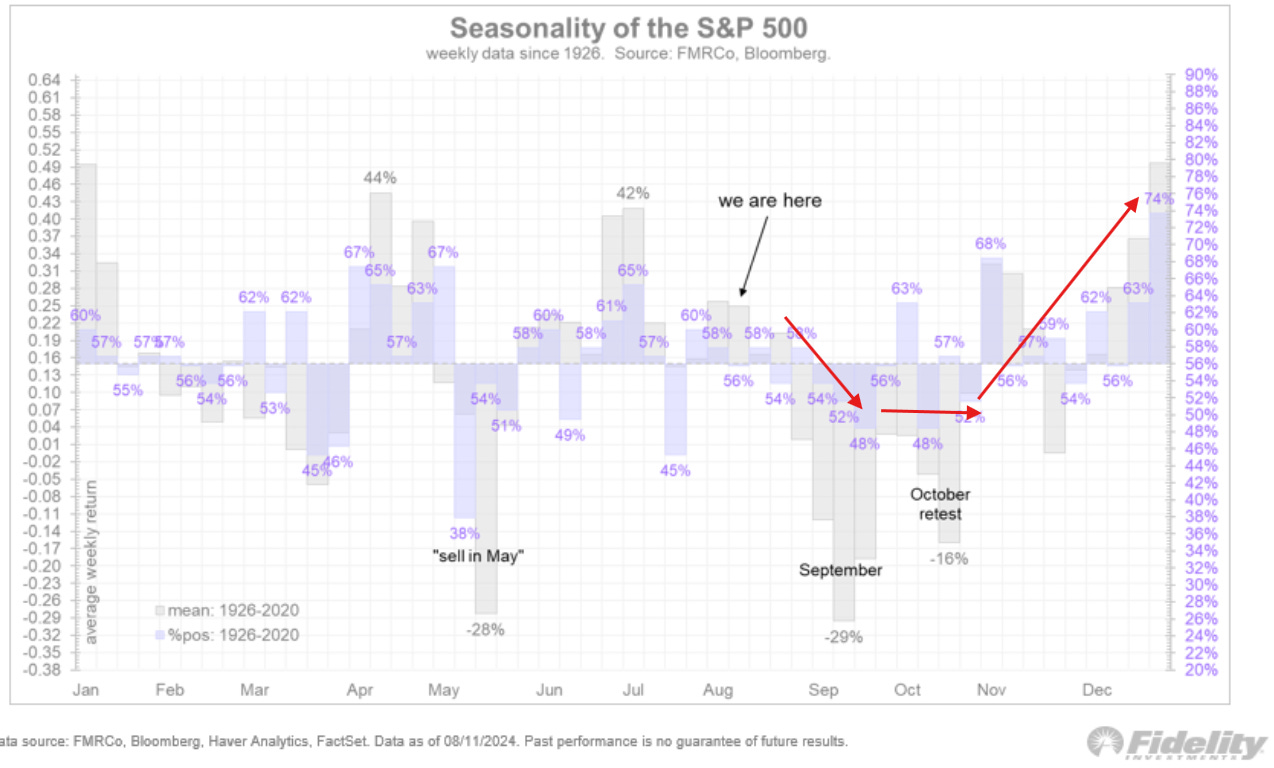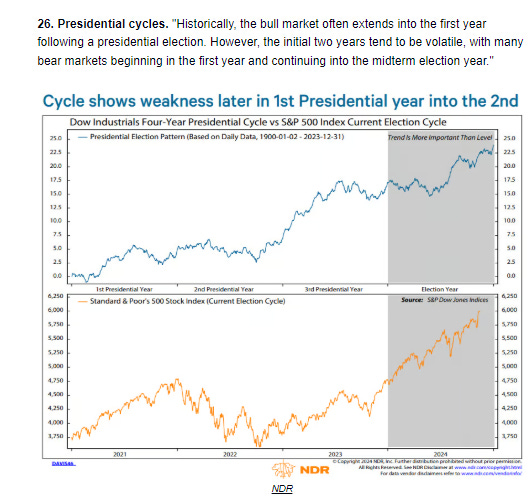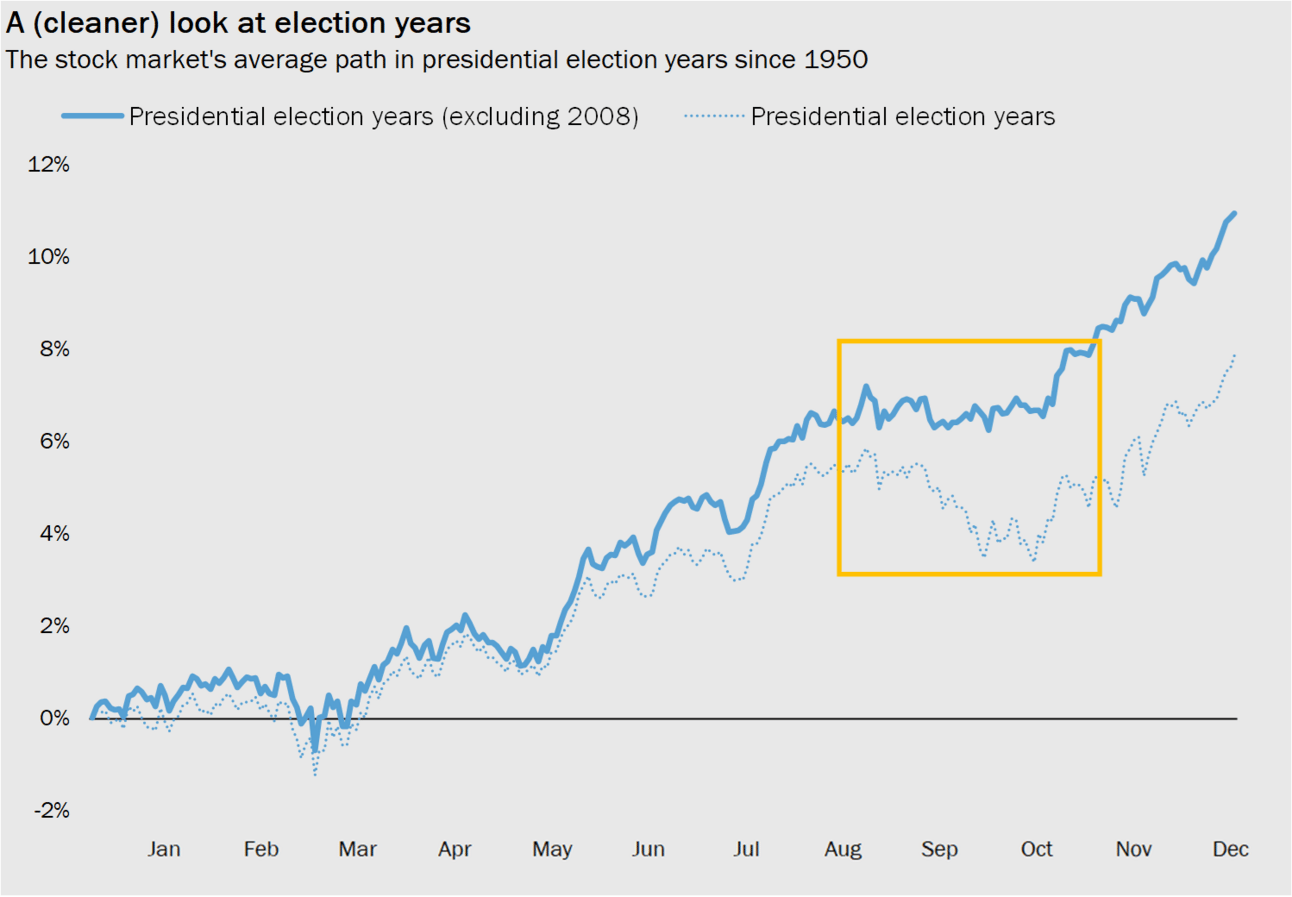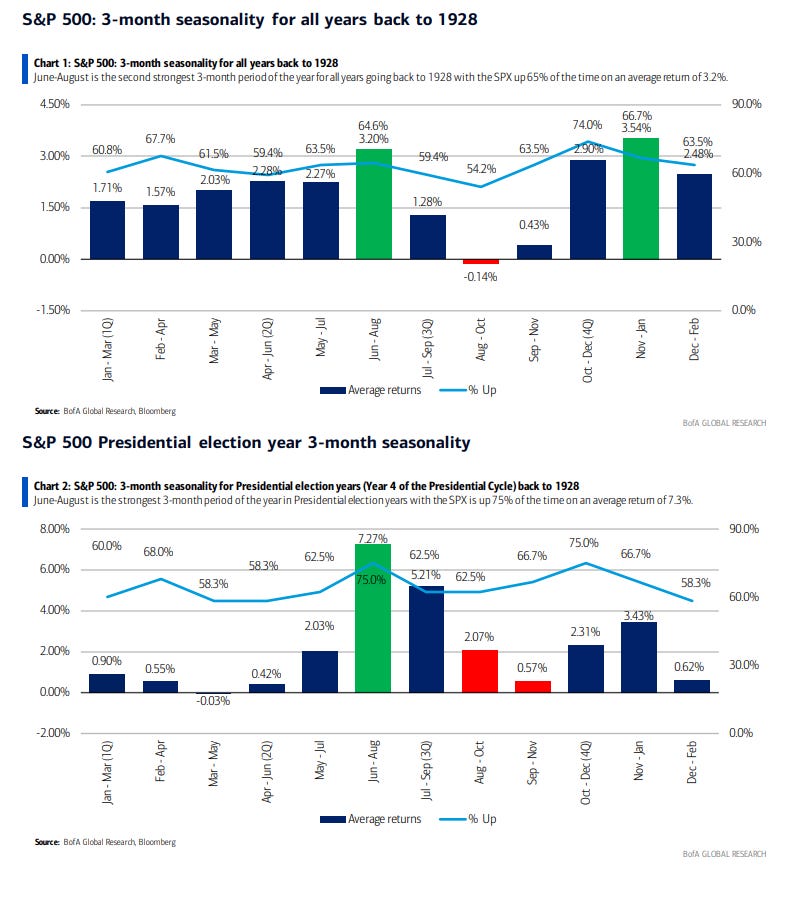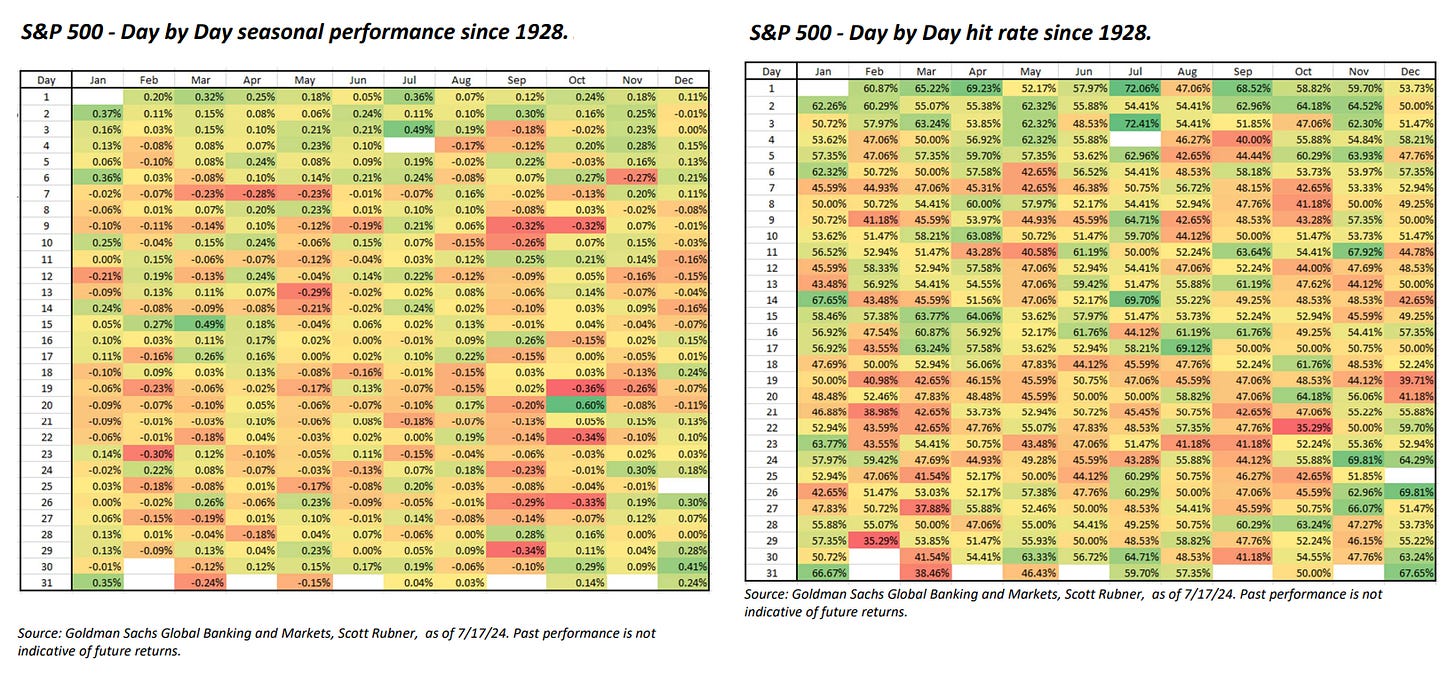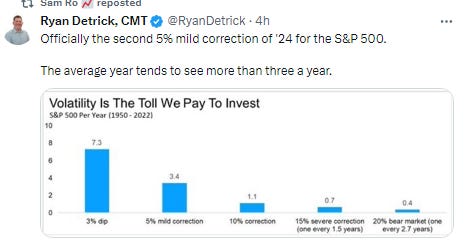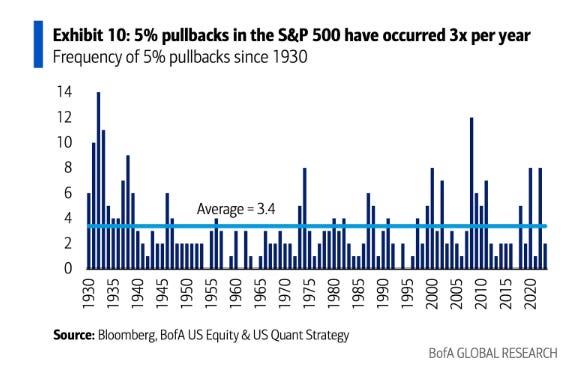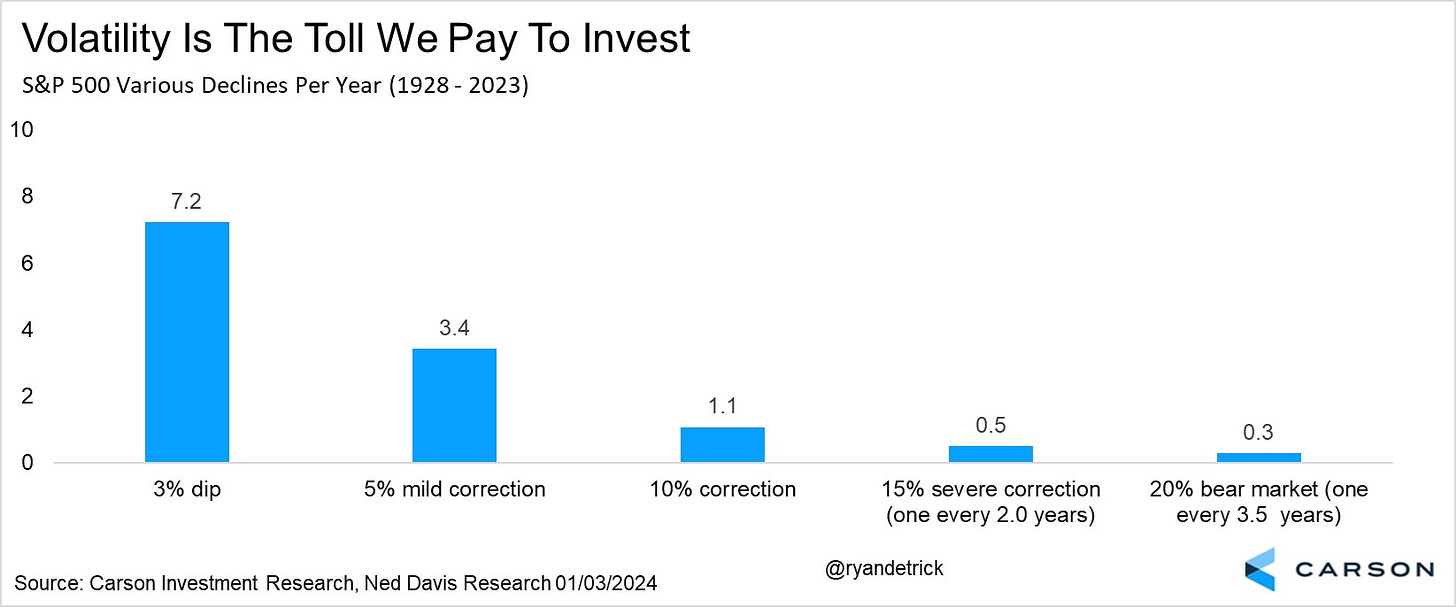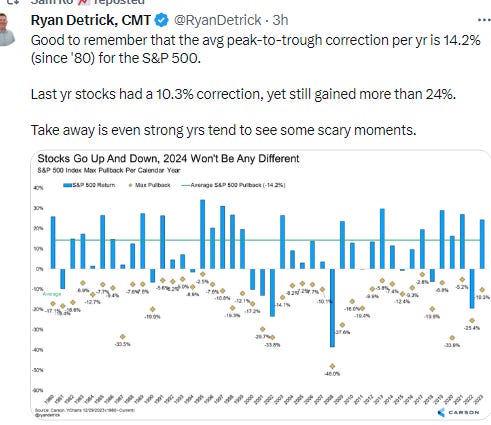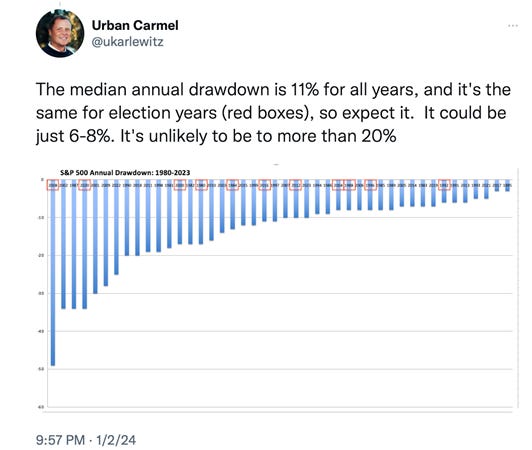The Week Ahead - 11/24/24
A comprehensive look at the upcoming week for US economics, equities and fixed income
If you're a new reader or maybe one who doesn’t make it to the end feel free to take a second to subscribe now (although then you’re missing my hard hitting analysis!). It’s free!
Or please take a moment to invite others who might be interested to check it out.
Also please note that I do often add to or tweak items after first publishing, so it’s always safest to read it from the website where it will have any updates.
As a reminder, some things I leave in from prior weeks. Anything not updated is in italics. As always apologize for typos, errors, etc., as there’s a lot here, and I don’t really have time to do a real double-check (and it’s a staff of 1).
The Week Ahead
The upcoming week is a tale of two halves. The first half starts slow with a light Monday, but Tuesday and Wednesday are a firehose of data, particularly the latter day. The highlight is the key report on personal income and spending for Oct along with core PCE prices, the Fed’s favorite measure of inflation. But also shoved into those 2 days are an update on Q2 GDP, new and pending home sales, home prices, consumer confidence, goods trade deficit and preliminary inventories, the Chicago Fed’s National Activity Index, Richmond & Dallas Fed regional PMIs, and weekly jobless claims, mortgage applications, and petroleum inventories. The second half (or last 40% to be more accurate) couldn’t be much lighter with a holiday (Thanksgiving) and half-day of trading with no economic reports (Friday).
Doesn’t look like we’ve got any Fed speakers on the schedule at this point, so we at least don’t have that to worry about, but we will be getting the FOMC minutes on Tuesday. Those will be parsed for clues on a December cut, pace for cuts after December, the neutral rate, etc.
US Treasury auctions will pick up though with with $69bn in 2yr’s, $70bn in 5yr’s, & $44bn in 7yr’s Mon, Tues, & Wed respectively.
Earnings in the upcoming week will continue but mostly outside of the SPX where 95% of companies have reported. This week we get 8 SPX components representing around 1% of earnings weight. Most (7) are on Tues, with just Agilent on Monday. Only one US reporter this week is >$100bn in market cap, Analog Devices, although Dell is close ($97.6bn).
From Seeking Alpha (links are to their website, see the full earnings calendar):
Earnings spotlight: Monday, November 25 - Agilent Technologies (A), Zoom Video Communications (ZM), Woodward (WWD), Bath & Body Works (BBWI), and Semtech (SMTC).
Earnings spotlight: Tuesday, November 26 - Analog Devices (ADI), Dell Technologies (DELL), CrowdStrike Holdings (CRWD), Guess? (GES), Manchester United (MANU), Workday (WDAY), and Autodesk (ADSK).
Earnings spotlight: Wednesday, November 27 - Patterson Companies (PDCO), and Zuora (ZUO).
Earnings spotlight: Friday, November 29 - MINISO Group Holding (MNSO) and Frontline (FRO).
Ex-US the focus will be on Canada GDP, China PMIs, Japan CPI, a likely pickup in EU inflation, and monetary decisions — including a possible large rate cut in New Zealand — are among the highlights. There are monetary policy meetings in South Korea, Nigeria, and Israel among others.
Canada’s third-quarter gross domestic product on Friday may help officials decide between a second 50 basis-point rate cut or a more cautious 25 basis-point move in December. Output data pointed to 1% growth, but economists expect the expenditure-based figures to land closer to a central bank estimate of 1.5% annualized expansion, supporting the case for more gradual reductions.
China’s economic health will stay in the spotlight, with purchasing managers’ indexes set for release at the end of the week. New Zealand’s central bank may consider a jumbo rate cut on Wednesday. The reduction is likely to be a half-percentage point rather than anything bigger as the Reserve Bank looks to balance caution over lingering inflation with the need to restart a stalled economy. The Bank of Korea is expected to stand pat on Thursday as it monitors the impact of its pivot toward lower rates in October. Elsewhere, rate decisions are also due in Sri Lanka and Kazakhstan. New Zealand, Hong Kong and Thailand will release trade figures in the coming week, Singapore has inflation numbers, and Japan will report on factory production, retail sales and the latest price growth data from Tokyo.
Inflation will take center stage in the euro zone, where data releases will start on Thursday before a report for the region as a whole the following day. Price growth is predicted by forecasters to have quickened in all four of the largest economies. Inflation in the euro area probably accelerated to 2.3% in November, the fastest reading for four months. Investors will also watch for the European Central Bank’s survey of consumer-price expectations on Friday. Several appearances are scheduled over the course of the week by policymakers, including Chief Economist Philip Lane. ECB officials have become increasingly sanguine on inflation prospects and will probably view the anticipated re-acceleration as a short-lived blip. Germany’s Ifo index of business expectations on Monday — the first since Donald Trump’s re-election raised the prospect of new tariffs — will also be a highlight. In the UK, the Bank of England is likely to draw attention. Governor Andrew Bailey will address business leaders on Monday, and the latest financial stability report will be published at the end of the week. Turning to Sweden, data on Friday may show the economy succumbed to a recession in the third quarter. Before that, two Riksbank officials are scheduled to speak.
Several monetary decisions are scheduled in the wider EMEA region:
On Monday, Israel’s central bank is likely to hold its base rate at 4.5% at a time when wars in Gaza and Lebanon are causing price pressures and slowing the economy.
On Tuesday, Nigerian officials may hike borrowing costs to cool price growth stoked by gasoline, currency weakness and floods. Governor Olayemi Cardoso has said the central bank wants a positive inflation-adjusted interest rate to attract investment and support the naira. The spread between inflation and the benchmark is now about 660 basis points.
Lesotho, whose currency is pegged to the rand and is experiencing slowing price growth, is expected to follow South Africa and cut by a quarter point.
In Mozambique on Wednesday, policymakers may keep their rate at 13.5%, concerned by the impact election unrest may have on inflation.
A day later, Gambian officials, encouraged by weakening price growth, may cut benchmark borrowing costs, currently set at 17%.
On Friday, Ghana is expected to leave its benchmark at 27% because of concerns about missing its year-end target for inflation at 18%.
In Mexico, the central bank’s quarterly inflation report and minutes of Banxico’s Nov. 14 decision to deliver a third straight rate reduction to 10.25% are keenly awaited. Analysts have been trimming their 2024 and 2025 GDP forecasts while Banxico notably raised its fourth-quarter inflation projection to 4.7% from 4.3% at its November meeting. Governor Victoria Rodríguez on Nov. 19 indicated that, given the progress in slowing consumer-price increases, more easing lies ahead. Jobs data for October are also on tap in three of the region’s big economies. Brazil’s national unemployment may eclipse the previous low of 6.3% to set a new mark. In Colombia, the early consensus has the urban jobless rate falling to 8.9%, well below the average for the series. Chile’s current unemployment level of 8.7% points to the slack in the labor market and economy. In addition to the jobs report, Chile also posts October retail sales, commercial activity, industrial production, manufacturing production and total copper output. Budget figures and the Brazilian central bank’s weekly readout of market expectations bookend the mid-month inflation report, which is likely to show consumer prices taking another leg up, both above target and the top of its tolerance range. Local economists have raised their year-end forecasts in 26 of the central bank’s last 28 weekly surveys
And here’s BoA’s cheat sheets for the upcoming 2 weeks (they’re obviously taking next week off). I just copied next week, and I’ll follow up next weekend with the following week.
And here’s a calendar of 2024 major central bank meetings.
Market Drivers
So let’s go through the list of items that I think are most important to the direction of equity markets:
Fed/Bonds
As noted previously this was one of the sections that had grown unwieldy, so I’ve really pared it down. Given I provide daily updates on Fed expectations, Fedspeak, and analyst thoughts on the Fed, it’s duplicative (and time consuming) to gather it all again so, again, I encourage you to look at those (the daily posts) for updates. I will just give more of a quick summary.
I noted last week that
with the overall more hawkish Fed speakers including Powell, I think what is being telegraphed is a switch to quarterly cuts following what remains a likely December cut. I think the only thing that would change that is a strong November payrolls report and hotter than expected CPI (which comes during the blackout period so would need to be telegraphed by a Nick Timiraos/Colby Smith article(s)). But I do think if we get those types of reports the December cut is in serious jeopardy. For now, though, we wait.
And that continued this week with FOMC rate cut expectations ebbing and flowing as to December (but remaining a little better than 50/50, but what has been more consistent has been a dialing back of 2025 cut expectations with around 1.5 cuts priced assuming a cut in December. While that’s possible, I feel that we’ve gone from one extreme (way too many cuts priced) towards the other extreme (too few cuts priced). We’ll get some important data this week in retail sales and industrial production among some other reports, but I really think it comes down to Nov payrolls and CPI which we won’t get until December. We’ll see if the FOMC minutes from the last meeting we get this week shed some more light on things.
Looking at the Treasury markets, with yields rising more on the short end this week, the 2/10 curve gave back the +8bps gain from the prior week, back to +0.04% Fri according to the St. Louis Fed, back to the low end of the narrow range over the past nearly 3 months.
As a reminder, historically when the 2/10 curve uninverts following a long period of inversion the economy is either in a recession or within a few months of one. Given we just got a 2.8% GDP for 3Q and are currently estimating well over 2% for 4Q, it seems like the days of the 2/10 curve as an infallible recession indicator may be numbered.
The 3mos/10yr yield curve (considered a better recession signal than 2/10’s w/the last four recessions on average coming a few months after the curve uninverted (prior to that it generally uninverted after a recession had already started)) which had seen a dramatic resteepening since late Sept fell back from the steepest since Nov ‘22 to -0.22% (still up +1.24% since Sept 11th).
Long term inflation expectations (as measured by the 5-yr, 5-yr forward rate (exp'd inflation starting in 5 yrs over the following 5 yrs), specifically mentioned by Powell at the Nov FOMC press conference (he said the metric was “right where it’s been, consistent with 2% PCE inflation”), were in that regard little changed again this week at 2.25% -1bps w/w (and -2bps since the Nov FOMC) in the middle of its range this year.
With nominal yields and inflation exp's little changed w/w, 10yr real rates using 10yr TIPS were as well remaining above 2% at 2.09% as of Thursday, just off the highest since early July, -1bps w/w but still +68bps since Sept 17th (& remaining well above the 2010-2020 peak of 1% (but down from the post-pandemic peak Oct ‘23 of 2.5%)).
10yr real rates using 5-yr, 5-yr forward inflation expectations (subtracted from the 10yr nominal yield) were little changed as well remaining above 2% at 2.17%, unch w/w, the highest since May, moving towards the highs of the year (2.29%), and well above the 2013-2020 average of around 0.5% (but down from the post-pandemic peak of 2.5% in October '23).
And according to BoA the importance of real rates on equity returns has seen the largest increase in the factors they track over the past 5 yrs.
Shorter-term real yields (Fed Funds - core PCE) remain well over 2% at 2.48% slightly off the highest since 2008.
And the real prime rate (using core PCE) is at 5.65%, just off the 5.9% in June which was the highest since Sep 2007. No wonder small biz sentiment has been so negative.
And with the 25bps FOMC Nov cut, the gap between 2yr Treasury yields and the Fed Funds continues to close, now just 0.24% versus the record of 1.77% before the Sept FOMC meeting, still though remaining at levels historically indicative of further FOMC cuts. Also even if it crosses, note that the 2yr often follows rather than leads, and we’ve seen this type of action before (rising 2yr crossing through a falling Fed Funds) such as in 2008 when the market thought fewer rate cuts were coming only to be wrong-footed).
And looking out longer term, one thing to note is the FOMC’s long run projection for the endpoint of the Fed Funds rate (the “neutral rate”) has steadily increased this year, now the highest since Sep 2018 at 2.9% (and not unlikely to go higher). [This gets updated in December].
And the 10yr term premium from the St Louis Fed (who uses the Kim and Wright (2005) model which differs from other models in that it incorporates non-yield curve factors such as inflation & GDP) continued to rise, +2bps w/w (and +54bps since Sept 11th) to +0.58%, the highest since Oct ‘23 (and just 10bps under the post-pandemic peak in June ‘22).
I had been a broken record since the Spring that I thought at some point (most likely around the election) this could resurface as an issue that will push yields higher perhaps cause some mild equity indigestion as it did in Oct of last yr, and while the issue has resurfaced we haven't seen quite the drawdown as we did in Oct (which was closer to -5%).
Also as Simon White of BBG noted 3 weeks ago it generally increases after FOMC rate cuts which we may be seeing some of as well (circle).
The extended discussion on term premium (what it is, why it’s important, etc.), can be found in this section in the Feb 4th Week Ahead.
As the MOVE index of expected 30-day bond volatility falls back to the least since late Oct but not yet to where it was prior to the jump when the election entered the 30-day window (early Oct).
Despite the drop in bond volatility, 30yr mortgage spreads were unch this week at 2.38%, but like bond volatility are around late Oct levels. Spreads overall remain just +10bps above the least since June ‘22, around a half percent above the 2010-2020 avg level.
And the Chicago Fed National Financial Conditions Index and its adjusted counterpart (which are very comprehensive each w/105 indicators) in week through Nov 15th each dropped a larger than normal two and three tenths respectively to now the loosest since Nov ‘21.
https://www.chicagofed.org/research/data/nfci/current-data
And BBG also sees very loose financial conditions.
Turning to the Fed’s balance sheet/QT and its impact on RRP, we continue to get steady, sizeable auctions of T-bills (<1 yr duration) of around $800bn/month as well as the $60bn in balance sheet runoff which quickly drained ~$1.75 trillion from RRP in the year through March 1st. From then until early July they had remained relatively stable in the $375-$500bn range, but since early July had resumed their decline (in fits and starts), falling to just $144bn on Election Day, but since then RRP levels have rebuilt somewhat to $204bn as of Friday (+$32bn w/w), now back over $200bn after falling under that level 3 weeks ago for the first time since May ‘21 (when RRP went from $129 to $485bn). They are still -$171bn since the start of the quarter Oct 1st.
This was a situation the Fed was comfortable with even when they were down below $300bn (at the Sept FOMC press conference Powell went so far as to say liquidity was “ample”, amplified later by comments from Dallas Fed Pres Laurie Logan (who is an important voice given her extensive experience in the NY Fed's markets group) who like Powell described liquidity as “more than ample” and said she's looking for RRP to fall to "negligible" levels). As I said in previous weeks “she's the expert so I'll defer to her, but I continue to be on the lookout for funding stresses now that RRP has crossed below $200bn, and I still think at zero RRP the Fed will likely need to stop QT to avoid another liquidity shortage as they did in late 2018.”
And as noted previously, BoA, who had previously estimated that RRP would fall to zero in Oct has pushed that out now to Jan ‘25. Citi in contrast had thought it would remain around the $300bn level until RRP rates fall.
And Powell’s and Logan’s lack of concern with liquidity was echoed by New York Fed’s Roberto Perli who said bank reserves remain “deep inside the ‘ample’ range,” even as the difference between peak and avg bank overdraft levels with the Fed has been increasing, traditionally a warning sign of bank reserve scarcity, although it may also just be a sign that banks are becoming more comfortable using the overdraft program. “We’re reluctant to draw strong conclusions from the latest data, as we don’t know exactly what is driving the trend,” said Wrightson ICAP senior economist Lou Crandall, and “if some banks are in fact more willing to rely on their Fed overdraft privileges to meet intraday working-balance needs, they may be less inclined to hoard reserves going forward,” Crandall wrote. “That ultimately could allow the Fed to shrink its balance sheet more than would otherwise be the case.” And Perli was out again this week brushing off concerns this time regarding the widening of rates at quarter end.
Meanwhile the yellow flags continue to grow with overnight repo rates (intra-bank lending fees) for year-end pushing higher, up over a half percent in just the last week, pressured not just by QT & a looming wall of Treasury settlements on Dec 31st, but also unprecedented demand for equity financing from dealers w/equity exposure hitting record levels.
Meanwhile BTFP loans (the emergency loan program created by the Fed in the aftermath of the SVB collapse) continue to fall as loans come up for refinance. As noted previously the Fed has wanted to clear these loans out and raised the rates to make them unattractive starting Jan 1, 2024. As these are 1yr loans, that means that by the end of this year all borrowers will have had to either pay off or refinance their loan at the now unattractive rate.
As you can see from the chart below, many are choosing the former with the program down to around $21bn (from $167bn at the peak in March of this yr), -$5bn w/w, the least since Mar ‘21 (when it went from $0 to $64bn) which I think will fall to near zero by year end (we’re almost there already). This will add to pressures on funding markets to some extent (the money has to come from somewhere).
For more on BoA’s forecasts for RRP to drop to near zero ($60bn) by Oct you can follow the link and look in this section (but it’s mostly due to RRP yields falling below those of money markets and will be soaked up by bonds (from Fed QT), the Treasury (with a higher TGA), and currency growth (in dollars). If bank reserves increase that would also pull from RRP. They see it building again into early 2025 before declining again towards zero.
For more on BoA pushing back their est for the end of QT to Mar ‘25 from YE ‘24 “which could create a funding blind spot for the Fed” in the event the debt limit (which expires at YE) is not resolved you can follow this link and look in this section. In summary their thinking is that, similar to earlier this year, the Treasury’s depletion of its General Account (TGA) will offset what would otherwise be a continued drawdown of liquidity. That will keep liquidity stable but will rapidly reverse once the debt limit is ultimately raised (which BoA est’s will again be in July as they assume Congress will take it to the very last second as is their habit), which could lead to a funding squeeze. However if the debt limit is raised in advance, the liquidity issue will come quickly as noted above, and we could very easily find ourselves in another 2018 scenario (which resulted in a near bear market).
Despite RRP going up and BTFP going down, bank reserves got back last week’s drop, putting them back to the highest since Sept 11th in the week through Wed at $3.27tn, +$80bn w/w, giving a little more breathing room from the $3tn level which we haven’t revisited since the indigestion in the credit markets in March ‘23 contributing to the banking issues (SVB, etc.).
Overall, though, they remain just -$900bn below June 1, 2022 levels ($3.36tn), when the Fed started QT, a much better result than even the most optimistic estimates at the time.
For background on various estimates of when reserves will be “too low” see the Feb 4th Week Ahead.
Getting back to rates, I said 7 months ago 2-year Treasuries were a good buy at 5%, and as I noted once the Fed started its cutting cycle, the ship has likely sailed on seeing those yields anytime soon (meaning years). In terms of 10’s I had advised grabbing some at 4.7% which I had thought seemed like something we wouldn’t see anytime soon, but as I noted last week “we’re already back to 4.45% and 4.7% doesn’t seem so far away. I still think it will take something ‘new’ to push over 4.5% (a hot inflation print, very strong payrolls report, etc.), but we’ll see.” I had thought getting past the election would perhaps be the catalyst that saw rates ease off, but so far that’s not been the case, although they also haven’t moved any higher. In terms of much lower yields, though, as I said 7 weeks ago, we have probably seen the lows until we get a recession:
“while we didn’t quite see 3.5%, I think 3.6% is close enough, and I think we might have been at or near the lows at this point, particularly as the Fed has been raising their neutral rate estimate. If the endpoint for Fed Funds is around 3% (or higher) then it’s hard to see the 10yr trading much lower absent a recession. Similarly 2yrs at 3.6% seem to be very rich and almost certainly too low absent a recession consistent with my statement last week.” In short I’d expect to see 4% on these before we see 3.2%:
At around 3.6% on both the 2 & 10yrs absent a recession I think there’s not much value in either (I’d rather park my cash in short term Treasuries (0-3mths) or safe dividend paying stocks with a track record of growth (dividend aristocrats, etc.) at these levels.
And BMO’s excellent rates strategy made a good point in terms of the richness of the 2yr yields current:
For all the old “final hike” and “first cut” materials, you can reference the Feb 4th blog post.
BoA updated their FOMC Dove-Hawk Chart. Note it’s missing Hammack in ‘26 (Cleveland and Chicago vote every 2 yrs), but otherwise looks right. Also note that Philadelphia Fed Pres' Harker’s term is up next year (which is why they don’t have a name for Philadelphia), something I didn't realize.
Also, I had a little back & forth with them arguing that Schmid should be "Hawkish" considering that he didn't dissent (versus Bowman) and that Goolsbee seemed more dovish than Harker. Here was their response (which makes some sense):
In a recent dot plot (I think June), Goolsbee identified himself as not the outlier, which led us to conclude Harker is the outlier. On the other end of the spectrum, there were two people forecasting 50bp of total cuts this year. We think they’re probably Bowman and Schmid. If we had more granularity, we’d rate Bowman as more hawkish, but with only five categories, I’m comfortable with putting them in the same bucket.
It seems like there might be more changes coming soon though with Collins saying this week a December cut wasn’t a “done deal”, a fairly hawkish statement. Similarly Kashkari has blessed a December cut so seems less hawkish. Logan, Musalem, Bowman & Schmid though did their “hawkish” best last week.
Earnings
As a reminder, I have removed most of the background material, which you can get in the Feb 4th blog post. As you know I’ve moved on to 2Q and beyond. You can reference this post from 5/12/24 for stats on 1Q.
As noted last week,
Given we’re past the 90% mark in terms of earnings reports, I will update this section but it generally doesn’t change much. Things that are basically the same I will leave italicized, things that have seen more than a small change I will not.
As we continue to move through Q3 earnings season, now with 95% of SPX earnings weight having reported through Thursday Factset reports 75% have beaten expectations (the same as last 2 weeks), below the 5yr (77%), but above the 10yr avg (74%). Overall companies are reporting earnings that are +4.5% above expectations (up from +4.3% last wk but down from +6.1% six wks ago), still below 1yr (+5.5%), 5yr (+8.5%) & 10yr (+6.8%) avg's.
And with the better beat amount, we’ve seen 3Q earnings expectations edge higher to 5.8% y/y growth from 5.4% last wk (and 4.3% on Sept 30th). 5.8% though would be the lowest growth since Q2 ‘23.
Which means we didn’t see this quarter the normal level of “earnings inflation” which happens as companies beat the lowered bars they set for analysts (37 of last 40 quarters have seen actual earnings beat expectations at the end of the previous quarter (exceptions were Q1 '20 (Covid) & Q3/Q4 '22)). As Factset reminded us at the start of the season, even with those outliers, the past 10yrs earnings have ended +5.5% higher than the start of the quarter, which would equate to +9.9% earnings growth. However as I noted last week “it seems highly unlikely we’ll come anywhere close to +9.9%. In fact, I’d bet it’s not much changed from the current +5.8% which would mean we’d have seen the least earnings inflation (~1.5%) since Q4 ‘22 when it was -1.4%.” With now 90% of SPX earnings in by weight, it seems now certain we won’t come “anywhere close” to the historical earnings increase from the start of the quarter.
On the top line, 61% of companies have beaten expectations for Q3, below the 5yr (69%) & 10yr avg’s (64%). Companies are reporting revenues that are +1.2% above expectations (up from +1.1%), still below the 1yr & 5 yr avg’s (+2.0 & 1.4%).
Like earnings, revenue growth exp’s for Q3 increased w/w to +5.6% from +5.5% (which will be the 16th consecutive quarter of earnings growth and most since Q3 ‘22). It is up from +4.7% on Sept 30th (start of the quarter).
Expectations for earnings in future quarters were mixed this week, not falling across the board for the first time in weeks. While Q4 was down another tenth to +12.0% (now down -3.0% the past 7 wks), Q1 ‘25 was unch at +12.7% (-1.4% last 5 wks) & Q2 ‘25 was up a tenth to +12.1% (-1.2% last 5 wks).
Looking more specifically at Q4, according to Factset, just 5 industries are responsible for most of the 12% in exp'd earnings growth in Q4: Banks (181% exp'd growth), Semiconductors & Semiconductor Equipment (34%), Pharmaceuticals (64%), Interactive Media & Services (25%), and Broadline Retail (48%). "Excluding these five industries, the estimated earnings growth rate for the S&P 500 for the fourth quarter would fall to 1.6% from 12.0%."
Taking it down to the company level, it's Truist Financial $TFC ($0.88 vs. -$3.85), Citigroup $C ($1.21 vs. -$1.16), Bank of America $BAC ($0.78 vs. $0.35), JPMorgan Chase $JPM ($3.88 vs. $3.04), and Wells Fargo $WFC ($1.33 vs. $0.86) in Banks, NVIDIA $NVDA ($0.84 vs. $0.52), Micron Technology $MU ($1.73 vs. -$0.95), and Broadcom $AVGO ($1.46 vs. $1.10) in Semiconductors & Semiconductor Equipment industry, Merck & Company $MRK ($1.84 vs. $0.03), Eli Lilly & Company $LLY ($5.47 vs. $2.49), and Pfizer $PFE ($0.48 vs. $0.10) in the Pharmaceuticals industry, Alphabet $GOOG ($2.11 vs. $1.64) and Meta Platforms $META ($6.72 vs. $5.33) in Interactive Media & Services industry, and Amazon.com $AMZN ($1.47 vs. $1.00) in the Broadline Retail industry for the fourth quarter.
Putting it together the lift to Q3 expectations along with next 3 quarters stopping their deterioration sees FY ‘24 move up to $240.09 from $239.84 (now +73 cents above the low 2 weeks ago), representing +9.4% growth. Looking further back, it remains down just around -2% from July 1, 2023, much better than the typical -6% or so drop we historically see.
2025 earnings expectations also moved higher for a 2nd week +24 cents to $275.16 (+15.0% growth), up +57 cents from low 2 wks ago which was the least since February.
In terms of how markets are handling earnings beats & misses at this point, looking 2 days before to 2 days after an earnings release, Factset continues to see beats rewarded more than average at +1.6% vs 5yr avg of +1%, and continues to see misses punished more than average (-3.1% vs 5yr avg of -2.3%).
Despite the softening in earnings expectations, Factset’s analysis of analyst bottom-up SPX price targets for the next 12 months as of Thursday was up another 59pts w/w to 6,610, now up ~1,587 points over the past 37 weeks. Health Care remains with the largest upside seen by analysts (+18.2% (up from +13.1% 2 wks ago with the selloff)) while Financials (+3.1% with the rally in those stocks) is expected to see the smallest price increase.
As a reminder the last 10 yrs they have been on avg +2.9% too high (+3.4% last 5 yrs). Of course, that avg range masks a wide discrepancy between big up and down years.
In terms of analyst ratings, buy and hold ratings continue to dominate at 53.7 & 40.6% (from 53.6 & 40.8% respectively (sell ratings remained at 5.6%)). Communication Services (62%), Energy (61%), and Information Technology (61%) sectors have the highest percentages of Buy ratings, while the Consumer Staples (40%) has the lowest percentages of Buy ratings.
And some other earnings stuff:
Economy
Over the past 2+ years part of my earnings optimism has been due to the economy holding up better than expected. While earnings only track the economy loosely (and markets look forward 6-12 months), there is a clear correlation between recessions, lower earnings, and lower stock prices (although stock prices (being as noted forward looking) generally fall in advance of the recession and bottom 6-9 months before the end of the recession). So if you can see a recession coming it is helpful, although very difficult (especially ahead of the market). You can reference this Week Ahead (see the Economy section) for a lot of material on how every recession is preceded by talk of a “soft landing” as close as a month before the start. On the IRA infrastructure act, the November 26 report has good info on how that should be supportive at least through the end of this year. That report also has the notes about how small caps have shorter debt maturity profiles and more of it.
As I’ve been stating since I switched to the Week Ahead posts in mid-2022, the indicators to me are consistent with solid (which at times has been robust) economic growth, and I have been a broken record that I “certainly [did] not think we’re on the verge of a recession (although as noted above every recession starts out looking like just some economic softening).” But several months ago I added: “That said, I’ve also noted over the past __ weeks or so [it got to 22], we have clearly started to see some moderation in key areas like consumption, manufacturing, construction, exports and housing.” The last 10 weeks though I’ve noted “the data [has been] fairly strong, more consistent with what we’d been seeing at the start of the year.” There wasn’t much data this week, and what we did have was influenced in part by Oct hurricanes (housing starts and coincident indicators) but outside of that things were solid particularly initial jobless claims (although continuing claims rose to a 3yr high) and flash PMI’s (although manufacturing remained in contraction). Homebuilder sentiment and consumer confidence improved for a 4th month as well (even as the levels remained on the weak side).
Overall, as noted 8 weeks ago, “the situation continues to seem like manufacturing is subdued but trying to bottom, housing perhaps has inflected off the bottom [although that is going to take a step backward with the jump in mortgage rates in the short term], labor markets (and the services sector and construction in particular) are solid [although hiring has clearly slowed and the last NFP report does raise some questions], and productivity appears to be very healthy (something I think you’re going to be hearing more and more about)…I continue to feel that any softening does not appear to be morphing into a recession.”
Overall, as I said 14 weeks ago:
without question, the evidence is building that the days of >3% real GDP growth are behind us (although we nearly got there in Q3), and we should be happy to settle into something more around trend (1-3% real (infl adjusted) growth). That though is far from a disaster. The important thing will be to see the softening level out (L-shape) rather than continue to fall turning the “soft landing” into a recession.
So far that’s what we’ve seen.
But despite what seemed like on net solid data last week, the Citi Economic Surprise Index fell for the first time w/w since Sept 9th edging down to 39.0 from 43.3 a week ago, remaining though much closer to the highs of the year (~50 in Jan) than the lows (-47.5 in early July).
https://yardeni.com/charts/citigroup-economic-surprise/
And GDP estimates are for now consistent with a no recession call (again though remembering GDP going into recessions generally doesn’t look like one is coming (it was up around 2% in Q2 & Q3 2008 well after the recession had started)). After coming in at 2.8% for Q3, most trackers are looking for a little below that level for Q4.
Goldman (who was 3.0% for 3Q vs 2.8% actual 1st est) left their 4Q GDP estimate at +2.5% (from isabelnet.com).
Atlanta Fed (who was right in line in its 3Q est of #GDP (and just a tenth off for 2Q from the 1st est)), edges its 4Q GDP estimate up a tenth to +2.6%.
BoA hasn’t released their 4Q tracking estimate yet. Their 3Q GDP tracking ahead of the GDP print was 3.0%, the highest since it initiated tracking. As a reminder, their “official” house est was 2.5% y/y growth in 3Q.
NY Fed’s 4Q GDP Nowcast (as a reminder, they had 2.91% for 3Q vs 2.8% 1st est) fell to 1.91% this week, mostly on the drops in the Philly Fed manufacturing current activity index (cancelling out last week’s increase from NY regional) and housing starts and permits.
As a reminder, the NY Fed’s model is dynamic and so adjusts in real time as data evolves, which subtracted -0.01% for “parameter revisions”.
And the St. Louis Fed GDP tracker, which outside of Q1 this yr (where it was the closest) has undershot actual real GDP since Q3 ‘22, continues to see sub-2% growth at 1.55% for Q4 from 1.6% the prior week.
While the Weekly Econ Index from the DallasFed (scaled as y/y rise for GDP), which runs a week behind other GDP trackers, continued to bounce back from a big drop 2 weeks ago now to +1.98% in the week through Nov 16th after falling relatively sharply 2 weeks ago to 1.65%, moving closer to the middle of its range this yr (1.49 - 2.66%). The 13-wk avg also improved to 2.04%, evidencing overall economic momentum around trend.
https://www.dallasfed.org/research/wei
Here’s the components.
Other economy stuff:
Multiple
Like the other sections, I’ll just post current week items regarding the multiple. For the historical stuff, see the Feb 4th blog post.
With the rise in equities this week, forward P/E’s rose as well outside of the “Megacap-8,” getting close to or all the way back to the levels 2 wks ago which were the highest since 2021.
The $SPX increased three tenths to 22.0 (-0.2 below the highest since mid-'21).
Mid-caps (S&P 400) were up four tenths to 17.1 (back to the highest since late ‘21).
Small caps (S&P 600) were up six tenths to 16.9 (the highest since mid-‘21 and almost catching mid-caps which they've trailed all year).
The “Megacap-8” P/E though fell back to 29.1 from 30 led by the weakness in Nvidia still up 2.7 pts from the 26.4 it hit 9 weeks ago (which was the least of the yr) but well below the 31.5 it hit 18 wks ago (which was the highest since Jan ‘22)).
https://yardeni.com/charts/stock-market-p-e-ratios/
Other valuation stuff:
Breadth
Breadth which had steadily weakened since the election turned around this week, particularly following Nvidia’s earnings Wed after the close.
The McClellan Summation Index ("what the avg stock is doing") trying to turn up again from around the area it's bottomed previously this year, although it looked similar at the start of Nov before heading back lower post-election.
With the rise in equities, the % of stocks over 200-DMAs rose as well, but they continue to lag prices as they have since Sept.
% of stocks above 50-DMAs similar to those over 200-DMAs, improving but with a large gap to prices.
% of stocks above 20-DMAs actually a little better than those over 200 & 50-DMAs on the NYSE edging to a 1-mth high (and from a higher low) while the Nasdaq like the others is seeing a big lag to price so far with another lower high.
Value/Growth moved to the highest of the month, making its first higher high since the local peak in September. Still not seeing the dramatic jump we got following Trump’s victory in 2016 but at least moving in the “right” direction. As a reminder, after the peak in 2016, the ratio fell through Trump’s first term until it finally bottomed post-Covid. Also note that it has never revisited those levels.
The equal-weighted SPX vs cap weighted ratio like value/growth moved higher last week, in its case to a 1-mth high, also seeing its first higher high since the local peak in Sept. Like value/growth it saw a bigger jump following Trump’s victory in 2016, and, again after that peak in 2016, the ratio fell throughout Trump’s 1st term until it finally bottomed post-Covid. Also note that like value/growth it has never revisited those levels.
It continues to me to bear some resemblance to the 2009 pattern where we saw an initial bounce from historic lows, then a pullback for several months before it embarked on a rapid multi-year recovery, although the Trump analog above raises caution signs.
IWM:SPY (small caps to large caps), which fell back last week, got back most of that, but for now remains not far from 24yr lows.
Equity sector breadth based on CME Indices last week best since election week with 10 green sectors (up from 5) & all of them up at least 1% (from 3). Communications only sector down due to weakness in GOOG & AMZN (and despite TSLA jumping another 10%) and only -0.3%. Big difference from last week.
SPX sector flag from Finviz consistent showing lots of green.
Other breadth stuff:
Flows/Positioning
BofA using EPFR data in the week through Nov 20th saw equities with another inflow (8th in 9 wks & 25th inflow in 27 wks), +$14.4bn, now +$103.7bn the last 3 wks (since election) & $624bn YTD annualizing to ~$701bn:
US 7th wk of inflows, +$16.4bn, $105.0bn last 4 wks (since election), +$405bn YTD annualizing to a record $448bn.
EM though saw a 6th week of outflows, decelerating to -$1.8bn, after the most since Aug ‘15 the prior week & the largest 4 wk outflow since May ‘20 (now -$27.4bn last 7 wks, but after 20 wks of inflows), still at +$149bn YTD (after $91bn in all of ‘23), w/#China seeing most of that outflow w/another -$1.0bn (now -$22.5bn the past 6 wks (but like EM overall only after 20 straight wks of inflows before that)) still +$131.2bn YTD, while #India saw a 5th wk of outflows (but only 6th this yr), -$0.3bn leaving it at +$20.5bn YTD.
#Japan saw another outflow (-$0.5bn) after 4 weeks of inflows (still +$5.1bn last 5 wks (but after -$10.7bn the prev 2 wks)), +$13.3bn YTD after +$7.3bn in 2023.
Europe 8th straight outflow & 82nd in 88 wks, -$3.6bn, now -$52.5bn YTD after -$66.9bn in 2023.
US large caps see 7th consec inflow & 48th in 58 wks +$9.8bn, after +$44.1bn the prior week, the most on record, now +$78.1bn last 3 wks (since election), ~+$156bn last 9 wks & ~+$444bn last 52 wks after +$125bn in all of 2023).
Small caps return to outflows -$0.5bn, still +$10.7bn last 3 wks (since election), +$23.2bn last 19 weeks and +$14.9bn YTD.
US value another inflow +$0.8bn (still -$70.1bn in 2024 after a record -$73bn in 2023).
US growth 2nd inflow (after 7 wks of outflows) just the 4th in 21 wks, +$2.9bn, +$3.4bn last 2 wks, -$37.8bn last 21 wks but ~+$113bn YTD.
Sector specific equity flows were very positive in EPFR data in the week through Nov 20th:
Inflows:
Tech led inflows after outflows in 4 of 5 wks w/big +$5.4bn, most in 6 wks, now +$17.9bn last 17 wks & +$52.4bn last 46.
Materials saw 10th inflow in 11 wks +$1.2bn after record +$5.6bn prev wk, +$15.2bn last 9 wks).
Financials another inflow +$1.1bn (+$6.6bn last 3 wks).
Energy just 2nd inflow in 15 wks (although just +$0.1bn and other inflow was tiny +$0.045bn, still -$7.1bn last 14 wks, -$0.2bn since election).
Outflows:
Utilities 5th outflow in 6 wks -$1.1bn (-$1.3bn since election).
Healthcare returns to outflows -$1.1bn, most since Dec (-$19.7bn last 58 weeks).
Real estate 6th consec outflow -$0.2bn (-$2.4bn since election).
Consumer returns to outflows, 5th in 6 wks -$0.5bn (-$27.6bn last 56 wks).
Looking at EPFR data in the week through Nov 20th for fixed income saw an 85th inflow in 86 wks (and 17th straight) +$9.1bn now ~+$593bn YTD (annualizing to record $666bn) but still BoA private client bond holdings as % of AUM lowest since '22:
IG/HG a 56th consec inflow (& 82nd in 84 wks) +$10.2, ~+$380bn YTD, on track for a record $425bn in 2024 after +$162bn in 2023.
Munis the 40th inflow in 44 wks (and 21st straight) +$0.8bn (+$1.9bn since the election).
HY 15th consec inflow & 21st in 22 wks (and 46th in 55) +$1.5bn, now ~+$62bn last 53 wks (+$3.5bn since election).
Bank loans 7th wk of inflows, +$1.6bn, after largest since Apr '22 in prev week (+$9.5bn last 6 wks).
EM debt though 5th consec outflow -$3.0bn, largest since Mar ‘23 (-$10.0bn last 5 wks).
Treasuries see 2nd outflow (after 5 wks of inflows), just 6th in 30 wks (and 8th in 43) -$2.9bn, largest 2 wk outflow since Dec ‘23 (now -$2.2bn since the election).
TIPS a rare inflow just 2nd in 15 wks & 3rd in 20 (& 9th in 64), but just +$1mn. TIPS saw record outflows of -$33bn in 2023.
In week through Nov 20th, EPFR saw cash w/1st outflow in 5 wks & 2nd in 9 wks, but tiny -$1.3bn, still +$991bn YTD (annualizing to +$1.113tn after a record +$1.3T in 2023 and +$3.3T 2019-2023). BoA private client cash holdings as % of AUM though remain well under the historic avg (although increasing for 2nd wk), even as AUM in money markets is at a record high ($6.7tn).
Gold/Silver see 3rd outflow (but only 5th in 21 wks) -$0.6bn, after most since Jul ‘22 prev wk, still +$12.9bn last 25 wks, but -$2.8bn since election.
Crypto funds (Bitcoin) another inflow (9th in 10 wks) +$0.9bn after a record +$6.0bn in prev wk +$20.4bn last 28 wks and +$6.3bn since the election.
ICI data on money market flows saw a larger outflow (-$22.2bn) than did EPFR (-$1.3bn) in the week through Nov 20th, still leaving the YTD flows into money market funds at ~+$723bn and total MMF assets at $6.65tn, from a record high the prior week. All of the outflow (-$31bn) was institutional (after +$79.4bn the prior wk), while retail added +$8.7bn (after +$2.2bn). In terms of totals, 60% is institutional, 40% retail.
Looking at CTA (trend follower) equity positioning, BoA says “trend followers were likely well positioned for this week’s US equity moves [according to our model] with elevated long positions, and as we noted last week, actual CTAs may be even longer as implied by our backwards looking regression. Moreover, we’re increasingly convinced that actual CTAs may be dynamically adjusting risk budgets based on outperforming assets….Next week our model forecasts increasing Russell 2000 longs. Meanwhile, the picture is much less bullish outside the US where CTAs could have short EURO STOXX 50 and only small long Nikkei 225 positions.”
So, CTAs look like they’ll again be buying/selling in the direction of index moves this week except on the RUT where BoA’s model has them buying in all cases.
In that regard, the $RUT now has the strongest trend strength at 67% (up from 55%) while $SPX & $NDX still are at 64 & 61% (from 64 & 60% last week). Japan fell to 8% from 26% two weeks ago while Stoxx50 is -43% (from -23%).
In terms of gamma positioning, BoA says that “[a]fter the US election and prior to this week, $SPX gamma had generally been well supported (averaging +$9.4bn). However, [last] week SPX gamma has softened somewhat. For example, as of Thursday’s close SPX gamma was more moderate at +$5.6bn (46th %ile year-to-date). Looking forward, while the S&P continues to hover just below 6000, if equities do climb higher early next week, then the current profile suggests gamma may climb quickly. On the other hand, if equities decline from here then gamma may follow suit. Naturally, new flows & expiries may alter this picture”
As I’ve noted weekly this year, very high levels of gamma have acted as a market stabilizer for most of this year dampening volatility in both directions. When it’s fallen below $2bn or so (as it did 4 weeks ago) we’ve seen heightened volatility (which we did), and while it’s rarely been negative that has been associated with even higher volatility (which is what BoA saw 3 weeks ago, and which we saw (to the upside)). With gamma now moderate, it will provide some cushion, but less so than we’ve seen, although it would take a sharp move below 5650 to see gamma flip negative.
And while BoA est's that risk parity strategies continue to heavily overweight bonds and underweight commodities & equities. I suggested 5 wks ago given the (relatively) lower equity volatility on a 30-day lookback window vs bonds, the gap should narrow, but for now it remains quite wide. Commodities not so much given the continued elevated volatility in that asset class.
BoA est’s that volatility targeters (vol control), saw their adding back of SPX exposure stall out last week in line with the heightened volatility the previous week. Last week was less volatile so we’ll see if these will resume buying.
In that regard, BoA is looking for some buying on Monday.
And BoA notes “the amount of both S&P 500 and NASDAQ-100 futures that leveraged & inverse ETFs would theoretically need to trade for each 1% move e increased over the last week as upside resumed,” although not back to the ATH’s hit 2 weeks ago. This trading typically happens the last 5 minutes of each day, and they estimate is responsible 4 & 32% (the latter down from 37% 2 wks ago) respectively of all volume in that period.
And some other notes on positioning:
And BoA continues to see buybacks continuing above seasonal norms.
But something to watch out for towards the end of the year.
Sentiment
Sentiment (which I treat separately from positioning) is one of those things that really only matters at the extremes (and even then, like positioning, it really is typically helpful more at extreme lows vs extreme highs (“it takes bulls to have a bull market”, etc.)). As we saw last week, sentiment is mixed with some metrics pushing towards (or above) Sept levels (which I said were a “caution signal”) while others remain more subdued. So still not a good read to me but if anything a moderate headwind.
From Helene Meisler:
Elsewhere, the Investors Intelligence survey saw almost no change in the bulls (still at 60%), but the bears finally dropped—to 18.3%. This is the lowest reading since September so while folks did not necessarily get more bullish, they got less bearish.
I am still watching the bull/bear spread which has climbed quite a bit in the last few months. It was just under 2.0 and is now 3.3. In July and in the spring it got to 4.2, meaning there were four bulls to every bear. It doesn’t need to get back there, but should it do so, it would be considered extreme.
The 10-DMA of the equity put/call ratio (black/red line) which had started to lift from near the lows of the year (investors starting to grow more cautious), halted that rise 3 weeks ago, and has again started to bump along near the lows of the year as it did in Oct indicating investors remain bullish (buying upside over downside protection). When it’s increasing it normally equates to a consolidation in equities and increase in volatility and vice versa.
The CNN Fear & Greed Index recovered its -10 pt decline the prior week moving back to 61 (still -8pts from the recent peak of 69 Nov 11th) back into “Greed” territory.
Looking at the components, market momentum (SPX >125-DMA), safe haven demand (20-day difference in stock/bond returns), junk bond demand, and 5-day put/call options remain in Greed/Extreme Greed territory, while market volatility remained in Neutral. Stock price strength (net new 52wk highs) moves to Fear from Extreme Fear, and stock price breath (as measured by the McClellan Volume Summation Index) remains in Extreme Fear.
https://www.cnn.com/markets/fear-and-greed
After “surging” 6 wks ago the most this year to 7.0, BofA’s Bull & Bear Indicator declines for a 6th wk to 5.4, the least since mid-May “driven by higher Nov FMS cash levels, EM debt outflows, and poor global stock index breadth (23 out of 45 global equity indices trading below 50 & 200dma); investors are bullish on America, but are not bullish on the World.”
And Goldman’s sentiment indicator hits 52wk high.
While Helene's followers are now the most bullish since Aprin the bullish camp for a 2nd week after the first 2-wk stretch of bearishness since June although moderating to 52.6% from 59.2%.
And Citi’s Panic/Euphoria model looks like it has hit the highest in the past year+. As a reminder, “[h]istorically...euphoria levels generate a better than 80% of stock probabilities being lower one year later.” In that regard, it first entered euphoria in late March (when the SPX was around 5200) and then reentered in late October (around 5800).
Seasonality
As I said 4 weeks ago, “now we’re pushing into the the very strong end-of-year period which starts Oct 28th and runs to the beginning of Jan, although some think perhaps we pulled forward some of those gains.” Perhaps that’s why we’re back to the same level as Oct 17th. Still if you’re basing your decisions just on seasonality, it doesn’t get any better than this through the end of the year. In terms of next week the day before and after Thanksgiving are generally positive.
BoA (Suttmeier): When the SPX is up through 3Q in an election year, 4Q is up 89% of the time w/avg return of 4.98% (4.26% median), which equates to SPX 6000 into yearend.
And looking into next year.
And as we consider seasonality, a really nice post from Callie Cox about how you need to take historical analogies w/a grain of salt (unless you've dug into the history). Her chart on Presidential election yr performance w/ & w/o 2008 (when the SPX was -17% in Oct) is a wonderful example.
https://www.optimisticallie.com/p/a-history-lesson
For references to all of the “up YTD through Feb” see the March 3rd post. For all the very positive stats through March (strong 1Q, strong two consec quarters, etc.) see the April 14h post.
For the “as January goes so goes the year”, see the February 4th Week Ahead.
Final Thoughts
As noted last week,
most of the above bullish notes remain intact, although we’ve still got Nvidia earnings on Wednesday to navigate. And the shine has clearly come off the rose more quickly than I expected (I thought it would be in January) on some of the Trump trades with worries about higher yields and fewer rate cuts from spending and policy decisions as well as some consternation with some of the picks for some key positions. Also, earnings remain an issue for me, and breadth is poor. Still seasonality remains very strong, buybacks are in full force, retail continues to buy, systematic positioning seems to be increasing (particularly if volatility falls), and we’re in a week without any other major catalysts on the calendar so if Nvidia comes through (or at least doesn’t create a lot of volatility in markets) and things settle down a bit I would expect the rally to resume.
And we did get a resumption of the rally, particularly in the “other 493” on Thursday and Friday. Does that continue into this week? Well, we continue to have seasonality on our side, along with buybacks, and it appears retail continues to buy. Earnings sentiment improved this week, the economy remains in good shape, breadth is improving (even as it lags prices for now), and it feels like things can’t get much more bearish on the Fed side (fewer cuts) with less than 3 total priced in. Rates seem ready to perhaps cool off a bit, and it looks like it won’t take much to get systematic strategies reengaging which would be a powerful force. There are certainly quibbles. Stocks are relatively expensive and sentiment is pretty complacent, but this is certainly not a market I would want to short.
So as I’ve said all year:
Overall this feels like a bull market (the economy is growing, earnings are growing, the Fed is much more likely to be cutting than hiking as its next move, the technical picture and seasonality are strong overall for this year, balance sheets are solid, there’s lots of liquidity, and there’s lots of stocks other than the biggest ones that are performing well (the equal weight SPX hit a new ATH in March, etc.). So if/when we do get that sharp pullback I would think it will likely be an opportunity to buy (like most sharp pullbacks are), not a reason to run for the hills.
And as always just remember pullbacks/corrections are just part of the plan.
Portfolio Notes
Had all of TRP called away (would buy back on any notable pullback), and sold out of PEP. Also trimmed CHWY, SNOW, ARE, ADNT, RHHBY, CZR, ZBH, BIO, KSS, SMCI, TPR, MPLX, AM, CTVA, CTRA, ASML. Some of those are tax-loss harvesting, which I will do more of over the next couple of weeks.
Added to M (new), ULTA, E, IBB (new), VRSN (new), NTR.
Cash = 18% (held mostly in SGOV, MINT & BOXX (BOXX mimics SGOV but no dividend, all capital appreciation so get long term capital gains if you hold for a year) but also some non-TBill (>1yr duration) Treasury ETF’s (if you exclude those longer duration TBill ETF’s, cash is around 11%)).
Positions (after around the top 20 I don’t keep track of their order on a frequent basis as they’re all less than 0.5% of my portfolio).
Core positions (each 5% or more of portfolio total around 20%) Note the core of my portfolio is energy infrastructure, specifically petroleum focused pipelines (weighted towards MLP’s due to the tax advantages). If you want to know more about reasons to own pipeline companies here are a couple of starter articles, but I’m happy to answer questions or steer you in the right direction. https://finance.yahoo.com/news/pipeline-stocks-101-investor-guide-000940473.html; https://www.globalxetfs.com/energy-mlp-insights-u-s-midstream-pipelines-are-still-attractive-and-can-benefit-from-global-catalysts/)
EPD, ET, PAA
Secondary core positions (each at least 1% of portfolio)
ENB, XOM
For the rest I’ll split based on how I think about them (these are all less than 1% of the portfolio each)
High quality, high conviction (long term), roughly in order of sizing
DIS, SHEL, CVS, CTRA, KHC, GOOGL, ADNT, T, PFE, GILD, BWA, BMY, SCHW, APA, O, GSK, EQNR, CMCSA, TLH, TPR, DVN, ADNT, OXY, RHHBY, STLA, NEM, NTR, TRP, E, ING, VZ, KMI, CI, AM, JWN, VSS, ARCC, AES, BAC, VNOM, TFC, MPLX, VOD, FSK, CVX, ING, HBAN, CCJ, BTI, MTB, RRC, FRT, VICI, DGS, WES, INDA, CURLF, MPLX, OWL, BUD, KEY, CVE, URNM, URA, BAYRY, SOFI, BEP, BIIB, SAN, TEF, SPG, KVUE, SLB, KT, SQM, ALB, F, VNM, MFC, GPN, SEE, LYG, NKE, ORCC, LVMUY, EMN, ZS, ADBE, NVDA, BCE, MDT, BAX, SNOW, DAL, RTX, HAS, DELL, NOC, BIO, GIS, OCSL, MSM, PHM, VRSN
High quality, less conviction due to valuation
Higher risk due to business or sector issues; own due to depressed valuation or long term growth potential (secular tailwinds), but at this point I am looking to scale out of these names on strength. These are generally smaller positions.
ILMN, AGNC, FXI, PYPL, URNM, URA, LADR, STWD, PARA, CFG, YUMC, ORAN, KSS, CHWY, TIGO, TCNNF, TCEHY, JD, WBA, ACCO, KVUE, KLG, CLB, HBI, IBIT, UNG, EEMV, PK, VNM, SABR, NSANY, VNQI, VALE, SBH, ST, WBD, BNS, EWS, IJS, NOK, SIL, WVFC, VTRS, NYCB, ABEV, TPIC, PEAK, SEE, LBTYK, RBGLY, LAC, CMP, CZR, BBWI, LAC, EWZ, CPER, MBUU, HRTX, MSOS, SIRI, M, IBB, CE, EL,
Note: CQP, EPD, ET, MPLX, PAA, WES all issue K-1s (PAGP is the same as PAA but with a 1099).
Reminder: I am generally a long term investor (12+ month horizon) but about 20% of my portfolio is more short term oriented (just looking for a retracement of a big move for example). This is probably a little more given the current environment. I do like to get paid while I wait though so I am a sucker for a good well supported dividend. I also supplement that with selling calls and puts. When I sell a stock, I almost always use a 1-2% trailstop. If you don’t know what that is, you can look it up on investopedia. But that allows me to continue to participate in a move if it just keeps going. Sometimes those don’t sell for days. When I sell calls or puts I go out 30-60 days and look to buy back at half price. Rather than monitor them I just put in a GTC order at the half price mark.
To subscribe to these summaries, click below (it’s free).
To invite others to check it out,





